The blog for Mets fans
who like to read
ABOUT US

Faith and Fear in Flushing made its debut on Feb. 16, 2005, the brainchild of two longtime friends and lifelong Met fans.
Greg Prince discovered the Mets when he was 6, during the magical summer of 1969. He is a Long Island-based writer, editor and communications consultant. Contact him here.
Jason Fry is a Brooklyn writer whose first memories include his mom leaping up and down cheering for Rusty Staub. Check out his other writing here.
Got something to say? Leave a comment, or email us at faithandfear@gmail.com. (Sorry, but we have no interest in ads, sponsored content or guest posts.)
Need our RSS feed? It's here.
Visit our Facebook page, or drop by the personal pages for Greg and Jason.
Or follow us on Twitter: Here's Greg, and here's Jason.
|
by Greg Prince on 27 March 2024 1:13 am Today we reach that year in the MY FAVORITE SEASONS, FROM LEAST FAVORITE TO MOST FAVORITE, 1969-PRESENT countdown when I have to admit I went to sleep sometime in early April and woke up sometime in early November. That must be what happened, because I don’t seem to have any memories of anything that could have actually happened.
Fortunately, I stirred often enough over those seven months to keep a dream journal, writing down some of the surreal things, Metwise and otherwise, that apparently occurred in my subconscious. As I reviewed it for this series, I was struck by how surreal it reads. Like, I guess it could have happened, but, no, even now it comes off as a little too strange for reality.
Nonetheless, I’m sharing some excerpts below. I wouldn’t necessarily call them bad dreams. Far from it, for the most part. But I’d definitely call them weird dreams.
What a season I seem to have imagined…
***12. 2015
APRIL 6: I dreamed the Mets won on Opening Day in Washington, which doesn’t exactly feel like a dream, since they usually win on Opening Day, but the save went to journeyman Buddy Carlyle, which I wouldn’t have expected in my waking hours. Where’s last year’s closer Jenrry Mejia? I wonder if this is a harbinger of strange dreams to come.
APRIL 9: Matt Harvey is back, if my dreams are to be believed. He’s beating Stephen Strasburg again, just like that game I went to in real life in 2013 when we all chanted “HARVEY’S BETTER,” which is the only thing I can remember ever chanting at Citi Field. Are my dreams in reruns? No, this took place in Washington. Also, a guy named Alex Torres wore an oversized hat and pitched in relief for us, and I never saw a hat like that before. Also, isn’t the Torres who pitches for the Mets named Carlos? I don’t know if I need more sleep, but I need better sleep.
APRIL 11: Where was last year’s closer Jenrry Mejia on Opening Day? Per my latest dream, he’s been suspended for PEDs. Also, the Mets lost in Atlanta to drop their record to 2-3. Even in my dreams, the Mets can’t catch a break.
APRIL 14: I’m at Citi Field for Harvey Night. It’s the first Harvey Night since 2013. It doesn’t seem weird that Harvey is pitching again. We spent the bulk of last year reading every update about his Tommy John rehab. What’s weird is a) Chase Utley — we’re playing the Phillies — homers off him in the first inning (I must’ve been thinking about Utley’s Corner), as if Harvey gives up home runs; b) Harvey hits Utley in the fifth (do the Mets ever retaliate?); c) Utley hits another homer, this time off a pitcher named “Sean Gilmartin” (a combination of Gil Hodges and Billy Martin, maybe, reflecting my unease about Terry Collins still managing this team for a fifth straight season); d) David Wright steals a base, but then has to leave with some kind of injury (the words “day to day” float through my ears; e) Anthony Recker, the good-looking catcher (why do I notice he’s good looking in my dreams?) has to play third base in his stead, which is REALLY surreal even though the Mets have that crazy “79 Men on Third” history with that position, which David Wright seemed to have rendered moot; and f) the Mets win despite all the weirdness.
APRIL 23: I’m at Citi Field again, a weekday afternoon game. Wright still isn’t playing. The Mets are trying to tie their consecutive wins streak record at eleven, a mark they set in 1969 and have tied three times since but never broken. When they win eleven in a row, they always wind up having a winning record, which would be a nice change from what I’m used to as a Mets fan, having experienced nothing but losing seasons dating back to 2009 and the opening of the new ballpark. What are the Mets doing being unbeatable? In the dream, if the Mets win, they will have swept an entire three-team, ten-game homestand: the Phillies, the Marlins and the Braves, all hated divisional rivals. So many questions. Also, it is freezing, yet I am up and I am clapping and feeling very optimistic about the Mets, something I haven’t felt for more than five minutes in maybe seven years, probably longer. It’s like my cynicism has taken a holiday. “We’ll have to change our jaded ways,” Billy Joel once said, and I seem to have listened. Toward the end of the dream, the Mets do win their eleventh consecutive game — and our new closer Jeurys Familia saves his eighth, making it seem as if Mejia never existed. I’m loving these days?
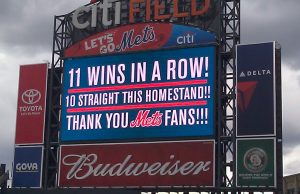 MAY 6: Jacob deGrom, last year’s Rookie of the Year, beats the Orioles one night after Bartolo Colon does the same. I really like deGrom, though I find Colon a little too much of an Internet meme. “Jake and the Fatman,” I muse, and then tweet a picture of William Conrad. Good line, if a little pot calling the kettle black insensitive on my part. Can I help what material I come up with in my dreams? MAY 6: Jacob deGrom, last year’s Rookie of the Year, beats the Orioles one night after Bartolo Colon does the same. I really like deGrom, though I find Colon a little too much of an Internet meme. “Jake and the Fatman,” I muse, and then tweet a picture of William Conrad. Good line, if a little pot calling the kettle black insensitive on my part. Can I help what material I come up with in my dreams?
MAY 17: Back at Citi Field, a sunny Sunday afternoon. Noah Syndergaard is making his home debut. A lot of guys have brought toy hammers, like hammers of the gods from Norse Mythology, I assume, because his nickname is Thor. I must be dreaming, because I can’t believe security would let those through. Before I drifted off during Spring Training, I think there was something about Syndergaard (or “Thor”) eating lunch in the clubhouse during an exhibition game and David Wright telling him that’s a no-no, rook, and Bobby Parnell tossing it into the trash. Anyway, “Thor” is a Met now, according to my dream. Maybe he replaced Dillon Gee, who I don’t see anywhere. Gee, I always liked him.
MAY 20: My dreaming takes a dark turn. I’m supposed to be at tonight’s game, but I can’t go. Turns out the Mets get shellacked by the Cardinals and fall out of first place — the Mets are in first place? — but that’s hardly the center of the dream. In the morning, I get a call that my father’s been taken to the hospital, which gets me and my sister together to drive first to one hospital, then another until we find out which one he’s in. He fell at home, apparently. He’s there all day into the night, so I just can’t take off for a ballgame. Honestly, in the dream, I’m not too worried about the Mets. My father is checked in and staying for a while. Oh, and if all of this isn’t weird enough, this is the night David Letterman ends his talk show, three days after Mad Men airs its finale. I vaguely recall making small talk with my father about Mad Men while he’s lying on a gurnee in a hospital corridor. And wasn’t one of Letterman’s directors named Hal Gurnee? My dreams are getting weirder.
MAY 23: My worlds must be meshing because in addition to dreaming my father is a) still in the hospital and b) had to have brain surgery to remove as much could be removed of a glioblastoma, I learn David Wright — who hasn’t played in more than a month — will be out indefinitely with something back-related I have to Google (it’s something nobody’s heard of, but it’s not good). To make it all stranger, I seem to be driving back and forth from the South Shore, where I live in real life, to the North Shore, where my father’s recuperating, and I almost never drive any kind of distance. It’s all a little scary.
MAY 24: I’m visiting my dad in the hospital again. The Mets are on a TV, losing in Pittsburgh by a score of 9-1. The Mets won their first game ever in Pittsburgh by a score of 9-1. That was the year I was born, and here, in my dreams, I’m trying to get closer to my father, but somehow finding time to keep an eye on the Mets game and worry about Wright’s “stenosis” I think it’s called. What does it all mean?
MAY 30: I go the Mets game by myself. It’s all connected to my father being in the hospital in the dream. Everything about his condition and recovery and the family (ours and his girlfriend’s) is kind of closing in, and I just have to get back to something familiar, something with a different form of attachment. In the dream, I’ve chosen Pepsi Towel Day. I have a longstanding relationship to the beverage business, and Pepsi has a Porch at Citi Field, but the kicker in the dream is they run out of towels by the time I get to the ballpark. The Mets lose to the Marlins. That, somehow, doesn’t sound surreal.
JUNE 1 I dreamed an article ran in the New York Times about the Mets’ ancient third base problems and how they’ve revived with Wright out, how they’re suddenly using Ruben Tejada there. Thing is, in the dream they get the all-time number of Mets third basemen wrong — the article said 144 and I KNOW it’s 156 because I keep track — and it drives me crazy, even though I have bigger things to worry about, like my dad. I keep sending e-mails and tweets to the sports editor and the guy who wrote the story, even including Baseball-Reference links to support my assertion, yet they don’t do anything about it. Later in the dream, the writer winds up blocking me on Twitter and they never run a correction. But, for the record, I was right…or do I mean Wright?
JUNE 9: OK, this one might call for therapy. I’m visiting my father in the hospital, or whichever facility he’s in now. I come to see him almost every day, which is quite a switch of how it was when he was healthy. He’s coming along, which seems like an understatement — he had brain surgery less than two weeks ago (on the night THAT was happening, according to a dreamed memory I must’ve repressed, I was watching Noah Syndergaard pitch against another young fireballer, Gerrit Cole, as if it was important that I stay on top of the Mets), yet we’re holding conversations and they’re teaching him to get the hang of walking again. Anyway, toward the end of our visit, I tell him I’m going to the Beacon Theatre for an offseason football Giants event. Eli Manning’s gonna be there. Tom Coughlin’s gonna be there. My father gets a kick out of this, so it seems like a worthwhile fact for me to share with him. Next thing I know, after the Giants thing is over, I’m out on the street listening to the Mets game and I hear the Mets playing the BASEBALL Giants at Citi Field and some guy I’ve never heard of is throwing a no-hitter against the Mets. I’m totally confused by what all of this means. Is it because I’m fascinated by New York Giants baseball history and it’s split off in multiple directions? Is my father’s situation casting a giant shadow over the season? Am I worried that the Mets aren’t hitting and will therefore never hit again? The dream winds up with me listening to Howie Rose calling the play-by-play first outside Penn Station, then on a train home.
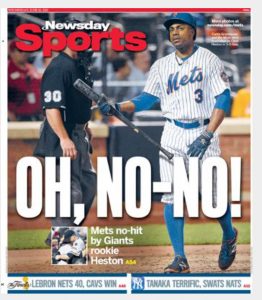 JUNE 10: I’m still having no-hitter dreams. I find Howie Rose’s ninth-inning play-by-play online somewhere and I decide to transcribe it, first on Twitter, then on the blog. I lose Twitter followers who don’t want to be reminded, and some blog readers tell me they don’t love being reminded. Yet in the dream I did it to be complimentary toward Howie’s play-by-play, particularly that he called it with the right amount of drama, never mind it was happening to rather than for the Mets, like Bob Murphy might have. The kicker to this dream? Howie Rose e-mailed me to thank me for making the comparison. No, this couldn’t have happened. MEANWHILE (yes, it’s one of those long and winding dreams), I go to a game that night, at Citi Field, against the Giants. It’s with a guy from California who tells me he’s moved to Queens for the season JUST so he can go to every Mets home game. I know, right? The guy, who tells me a book I wrote helped inspire him to do this, has very good seats not far from the field, the cushy green ones. At one point, I stand up, then sit down, and the seat collapses with me in it. In my dreams, this six-year-old ballpark is falling apart. JUNE 10: I’m still having no-hitter dreams. I find Howie Rose’s ninth-inning play-by-play online somewhere and I decide to transcribe it, first on Twitter, then on the blog. I lose Twitter followers who don’t want to be reminded, and some blog readers tell me they don’t love being reminded. Yet in the dream I did it to be complimentary toward Howie’s play-by-play, particularly that he called it with the right amount of drama, never mind it was happening to rather than for the Mets, like Bob Murphy might have. The kicker to this dream? Howie Rose e-mailed me to thank me for making the comparison. No, this couldn’t have happened. MEANWHILE (yes, it’s one of those long and winding dreams), I go to a game that night, at Citi Field, against the Giants. It’s with a guy from California who tells me he’s moved to Queens for the season JUST so he can go to every Mets home game. I know, right? The guy, who tells me a book I wrote helped inspire him to do this, has very good seats not far from the field, the cushy green ones. At one point, I stand up, then sit down, and the seat collapses with me in it. In my dreams, this six-year-old ballpark is falling apart.
JUNE 14: In this dream, the Mets blew a lead yesterday, with the guy with the big hat (one of the Torreses, I think, still) blowing the save in the ninth and a guy wearing a normal-sized hat (the other Torres?) taking the loss in the eleventh; a horse named American Pharoah — spelled just like that — won the first horse racing Triple Crown in 37 years; and then the Mets storm from behind today to win. The racing metaphor must have something to do with the pennant race. That would make sense. Less logical are some of the names that keep filtering through my subconscious. According to the box score in my dream, one of the four Mets to hit a homer in the win was “Darrell Ceciliani”. Your guess is as good as mine as to who that is.
JUNE 18: This one feels like the culmination of a few things. There’s been a four-game series against the Blue Jays — two at home, two on the road. (Do they do that in real life?) First off, there’s a lot of Jose Reyes in this dream. He was traded at some point from the Marlins to the Jays, but deep down I’ve never stopped missing him on the Mets. Then, in the middle of a large Mets loss, there are two pitchers named “Jack Leathersich” and “Akeel Morris”. Where do these names keep coming from? Next, there’s R.A. Dickey beating us in Toronto. He’s another guy I’ve never quite made my peace with having been gone. But what really catapults this one into strange-dream territory is John Gibbons, the Blue Jays manager (and an ex-Met, make of that what you will), reveals that Dickey was pitching shortly after his father died. It’s too eerily similar to what I’m going through with my dad not to give me chills.
JUNE 25: The standings in my dreams indicate the Mets have slipped below .500, yet here they are for a change winning. DeGrom not only pitched eight shutout innings, but he gets a hit and scores the insurance run…and I’m listening to it in the lobby of a hospital that isn’t the one my father’s been in. We — me, him, my sister, his girlfriend — have just come to this other place for him to be examined and told he’s coming along. For a moment, I feel like I’m talking to my dad in some “normal” situation that just happens to be a hospital lobby. I take this to mean that they will be sending home soon, or that the Mets will be sending more runners home soon. Whatever it is, it’s one of the less disturbing dreams I’ve had of late.
JUNE 26: Latest bizarre setting in dreamland? One of those suites at Citi Field. What am I doing in a suite? Well, best as I can make out, a friend’s daughter is having her high school graduation party there. I know, go figure. I show up with my wife, and who do I see in the suite? Howie Rose AND Josh Lewin. Before I can say a word, Howie waves to me and says, “Hi Greg,” which is something I wouldn’t have dreamed when I started listening to him on the radio in 1987. I call my father from the hallway outside the suite. I’m a little cagey about where I am because I feel weird being at a game while he’s still in the hospital this Friday night. While we’re chatting, a very tall man walks by with an entourage. He’s wearing a Mets jersey but he’s supposed to be the Knicks’ first-round draft pick. Kristaps something. He’s from Europe and he’s throwing out the first pitch. These dreams’ details are heading off the charts.
JUNE 28: My subconscious ain’t seen nothing yet. Today’s dream was a LONG one. I’m back at Citi Field, not for a doubleheader, but kind of a doubleheader, because apparently it rained a lot yesterday and that game was suspended — in the dream, I was there for that, too; it was a cold rain and the people behind me castigated me for opening my umbrella. Anyway, they have to finish the day before’s game, and that takes forever, because the Mets don’t hit, but they somehow win it. Lucas Duda drives in the winning run, which doesn’t sound like anything unusual, except in the dream, they gave out a “growth chart” with his picture on it. Then they play the regularly scheduled game, which is started for the Mets by a kid named Matz (a little on the nose) who’s supposed to be from Suffolk County, and everybody’s excited that he grew up a Mets fan. Not only does he pitch well, but he gets three hits and drives in four runs while his grandfather becomes a TV sensation by going nuts for the SNY cameras. So we sweep the pseudo-doubleheader and I stick around afterwards because STEVE MILLER? is playing a concert to like 200 people. He’s good, but it’s been a long day and I guess everybody else is itching to go home. In the dream, Steve Miller makes mention of “Stevie” Matz, like that’s what he’s called? I’m none among a joker, toker or midnight smoker, but I am confused.
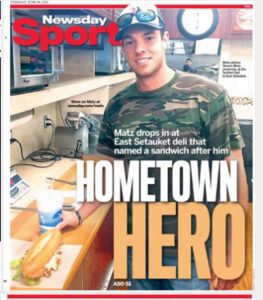 JULY 2: My dad is out of the hospital and the Mets are being swept three by the Cubs while scoring exactly one run. Disappointing Met overtones asides, this qualifies as a good dream. JULY 2: My dad is out of the hospital and the Mets are being swept three by the Cubs while scoring exactly one run. Disappointing Met overtones asides, this qualifies as a good dream.
JULY 6: The Mets are in San Francisco. “Johnny Monell” breaks up a scoreless tie and we win. Where do these total strangers keep coming up and what do they mean?
JULY 11: Maybe because this is the same date that I went to my first game in 1973, I get a good dream for the occasion. I’m at Citi Field and Matt Harvey homers. Pitchers really do hit in my subconscious. I hate the designated hitter THAT much. I fuzzily recall Noah Syndergaard homering in late May, too, but that happened when my dad took ill, so I wasn’t able to dwell on it.
JULY 12: It’s the last game before the All-Star break and KIRK NIEUWENHUIS, who I think I dreamed wasn’t even on the team for a while this year, hits THREE HOME RUNS in a single home game, the first Met to ever do that at Citi Field or Shea Stadium or the Polo Grounds. Not Wright or Piazza or Strawberry or even the original Frank Thomas. Kirk Nieuwenhuis. Tell me I’m not dreaming.
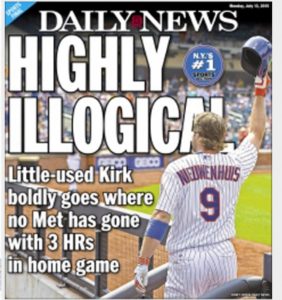 JULY 19: It’s the Sunday after the All-Star break in this one. The Mets are in St. Louis and they play EIGHTEEN innings. I think the Mets won. I know Keith Hernandez got impatient (a very lifelike detail to have retained). JULY 19: It’s the Sunday after the All-Star break in this one. The Mets are in St. Louis and they play EIGHTEEN innings. I think the Mets won. I know Keith Hernandez got impatient (a very lifelike detail to have retained).
JULY 23: In this dream, the Mets are facing Clayton Kershaw, last year’s NL Cy Young and MVP. Who are they sending out to bat against him? I see names on a TV screen: Mayberry (didn’t he play for the Royals in the ’70s?); Campbell (am I secretly craving soup?); Recker (the catcher who played third base in my April dream). Bartolo Colon is the starting pitcher for us and he doesn’t even have the lowest batting average of the bunch. The Mets miraculously pound out three hits while Kershaw tossed an eleven-strikeout shutout. If somebody were awake while he came up with this Met lineup, I’d call it a nightmare.
JULY 24: I dreamed the Mets called up last year’s top draft choice Michael Conforto. The Mets never call up last year’s draft choice, so I must be dreaming. Unless they had the same nightmare about the lineup the night before that I did.
JULY 25: I wonder if I was sweating when I rolled over and went back to sleep, because this one feels like a fever dream. First of all, the Mets traded for major league help: Kelly Johnson and Juan Uribe. Random baseball names for my subconscious, but at least I’ve heard of them. Then the Mets, with me in attendance, stomp all over the Dodgers, 15-2, with those new guys helping AND Conforto getting four hits. Oh, and HEART — you know, “Magic Man” — plays a show afterward. The summer heat must be getting to me.
JULY 26: We’re still playing the Dodgers in my dreams. I’m at this game, too. I’m in the right field corner of Field Level with my wife and a bunch of people from where she works. That’s happened in real life, but on a Sunday afternoon? Against the Dodgers? Anything goes in a dream. Zack Greinke is pitching for L.A. and has this long scoreless innings streak, but who should drive in the run that snaps it? Jacob deGrom. He pitches great, but Familia blows the lead, it rains a little, and in the dream I’m really fatalistic. But then Jenrry Mejia, like from out of nowhere in my subconscious, returns to throw a scoreless inning, and Uribe drives in the winning run in the tenth inning. It’s also apparently the same day Pedro Martinez is inducted into the Hall of Fame, where he says something very nice about Mets fans. That’s the kind of thing I always dream of.
JULY 29: This dream starts in a doctor’s examining room. My father’s been getting radiation and taking chemo since leaving the hospital. The whole family is crowded in with him for a followup. He’s told he’s doing very well and can go about his life. He’s 86, but asks the doctor if he’s good for another “10 or 11 years”. The doctor doesn’t quite respond. I celebrate by letting a friend of mine know I will go to the game with him that night. Lucas Duda hits three home runs, just like Kirk Nieuwenhuis did a couple of weeks ago, but nobody notices, because the trade deadline is approaching and word spreads around the ballpark that the Mets are trading Wilmer Flores and Zack Wheeler (who’s been injured this whole time) to Milwaukee for Carlos Gomez, the guy we traded in a package to get Johan Santana in 2008. CARLOS GOMEZ? I don’t know where that name came from. The kicker is word spreads to the Mets dugout and somebody tells Flores, who’s getting appreciative applause from the stands, and he gets all sad and the TV cameras pick up that he’s playing with tears in his eyes and my friend and I ask each other what the hell he’s doing in the game? Then, maybe just before I woke up, Sandy Alderson shows up to say there is no trade. Holy crap, go figure that one out.
JULY 30: I’m at Citi Field yet again for an afternoon game. Everybody’s talking about Flores, but he isn’t playing. The Mets are beating the Padres, which is great, except it starts to get overcast, and there’s a late rain delay, and Familia comes out to get the save, but he doesn’t get it. One of the Uptons (I forget which one) hits a home run to put the Padres in the lead and it starts to rain again, really hard, and I give up and go home. Next thing I dream, I walk into my living room and turn on the radio to hear the Mets are still in rain delay. They eventually lose. Funny thing about this dream is everybody seems convinced the Mets are cursed, yet I notice they’re still close to Washington in the standings and I’m almost serene about the whole thing. In dreams, right?
JULY 31: If I weren’t already seated while I’m entering this into my dream journal, I’d suggest I sit down for this. Shoot, maybe I’ll just stand up. Lemme see…the dream starts with a trade. At like a few minutes to four, right before the deadline, I dreamed the Mets got Yoenis Cespedes from the Tigers (wasn’t he with the A’s?). I’m excited, everybody’s excited. Then we’re playing the Nationals, which is a big deal because they’re in first place and we’re in second place, which is one of those things I’m still getting used to in my dreamscape after a real life in which they’ve won the division three times in the past five years and we’ve finished far from it. Matt Harvey is pitching for us. He pitches against them a lot in these dreams, doesn’t he? He’s going really well, but the Met who’s getting everybody’s attention at Citi Field is Wilmer Flores. Nobody’s trading him. They continue to applaud him. We go to extra innings and it’s Wilmer who hits the game-winning home run. Definitely a dream scenario.
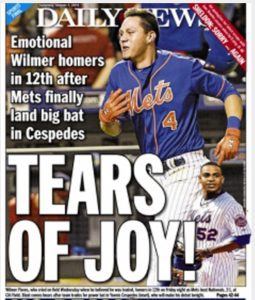 AUGUST 2: One more Mets-Nationals dream. This time it’s Sunday Night Baseball, which is usually akin to a nightmare, but crazily enough, the Mets can’t stop hitting home runs, at least in the third inning. Granderson — home run! Murphy — home run! Duda — home run! The Thor guy goes eight. Tyler Clippard, who my subconscious vaguely recalls as a Yankee who came out of nowhere to beat us on Sunday Night Baseball a long time ago, gets the save for us. We’re in a “virtual tie” for first. I’m beginning to wish I was awake for more of this. AUGUST 2: One more Mets-Nationals dream. This time it’s Sunday Night Baseball, which is usually akin to a nightmare, but crazily enough, the Mets can’t stop hitting home runs, at least in the third inning. Granderson — home run! Murphy — home run! Duda — home run! The Thor guy goes eight. Tyler Clippard, who my subconscious vaguely recalls as a Yankee who came out of nowhere to beat us on Sunday Night Baseball a long time ago, gets the save for us. We’re in a “virtual tie” for first. I’m beginning to wish I was awake for more of this.
AUGUST 3: The Mets go to Miami and stomp all over the Marlins while the Nationals lose and we’re alone in first place. Don’t wake me.
AUGUST 8: That guy from California shows up again. It’s his birthday, and I’m taking him to lunch (we’re eating in this place that is showing the night before’s Mets win), then on the subway up to the site of the Polo Grounds to show him around because Willie Mays is his all-time favorite player. I’m telling him I kind of know where I’m going — though I admit I got lost the last time I came here the month before — and eventually, we wander around enough so I get my bearings and I can show him the rededicated John T. Brush Stairway and then the street where Willie used to play stickball. We part ways at Penn Station. The dream includes him telling me he got a parking ticket at the LIRR station near where he’s been staying.
AUGUST 11: I’m wandering around Citi Field before another Mets win (they’re all Mets wins lately) and somebody hands me a flier for Slomin’s Home Heating Oil. Am I dreaming that winter is coming before I know it?
AUGUST 12: For this dream, I’m in the Promenade with a few people I’ve either known well in my past or known a little, but we’re a group tonight and the Mets are winning and Citi Field is noisy like I’ve never heard it for just another weeknight game. I must really want the Mets to be as good as I’m dreaming they are.
AUGUST 14: Once more with the California guy. He tells me he won some kind of special pass to get us (which includes yet another California guy, somebody I’ve never seen before and will never see again) on the field pregame. Curtis Granderson walks by signing autographs for everybody. Michael Conforto comes out and poses for a picture with the California guys, with the one I know wearing a t-shirt with Conforto’s name and number on it. My California friend tells me he never wears that kind of shirt, but he was kind of stoked about the rookie, and this happens. There’s a lot of “this happens” in these dreams I’ve been having in 2015. The game, against the Pirates, gets to the ninth inning tied, and with two out, the same Michael Conforto blasts a fly ball to deep left field that we think is going out, but it doesn’t. We lose in ten. Somewhere in the middle of all this, I buy each of us (me and the California guys, but not the actual Conforto) a tall can of Heineken to show my appreciation for the invitation. I realize I drink very little beer when I’m actually awake, because in the dream I’m shocked at how much beer costs, at least at the ballpark.
AUGUST 19: It’s early evening, and I’m driving home from picking up dinner for my wife and me at a local Italian place, when my cell phone rings. I never talk on the phone in my car, since it’s an old car and a relatively old phone, but I glance and see it’s my father’s girlfriend’s daughter. I answer. She tells me my father is back in the hospital. This dream again. I go home, drop the food off, and my wife and I drive to the hospital, nervously and anxiously, if that makes sense. This time my father has a really bad cough to go with whatever else is bothering him, something like pneumonia. We stay with him for several hours until after he’s checked in. I slip away at one point to a lounge where the Mets are playing the Orioles. Carlos Torres gives up a game-winning home run. We get home very late and heat up some of the Italian food.
AUGUST 21: I visit my dad and watch preseason football with him while trying to keep up with the Mets on one device or another. In the dream, he sort of notices that my attention is divided and I try to play it off like, no, not really, but he knows. Cespedes, who we got a few weeks ago, goes crazy at Colorado, where it’s easy to go crazy. The Mets win, 14-9, which I somehow know they’ve never done before.
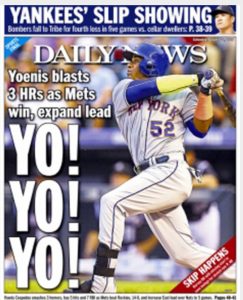 AUGUST 22: It’s the next night, and the Mets have beaten the Rockies again by THE EXACT SAME SCORE of 14-9, which must mean I’m dreaming in a loop. AUGUST 22: It’s the next night, and the Mets have beaten the Rockies again by THE EXACT SAME SCORE of 14-9, which must mean I’m dreaming in a loop.
AUGUST 24: A funny thing is happening in these dreams: my father is taking an interest in the Mets a little bit. He truly hasn’t cared what they’ve been up to since my mother died in 1990. But he’s noticed that I show up and stick around if the Mets game is on. I doubt I wouldn’t stick around if we watched something else, but I’m not gonna argue with a hospital patient, so we put the game on. And what a game I dreamed up for this night: David Wright is suddenly playing for the Mets again! And he hits a home run his first time up! Everybody hits a home run for the Mets, it seems. They hit a team-record eight and beat the Phillies, 16-7 (another new score), in Philadelphia. To prove it’s a dream, even the Phillies fans applaud David Wright for coming back with a bang. To prove my dreams are getting even weirder, I don’t see Wright’s home run the instant it’s hit because I’m emptying my father’s bedside urinal for him. It’s only when I return from disposing what needs to be disposed that I notice Wright is accepting his teammates’ congratulations. A surreal tradeoff for having David back and watching with my dad. I’ll take it.
AUGUST 25: Tonight’s twist: somebody comes to my father’s room and tells him he has to get something scanned. He’s against this. Even in my dreams, I don’t know how he puts up with the poking and prodding that I suppose is necessary. While he protests that he won’t go, I come up with the craziest thing I’ve ever said, awake or asleep. “Dad, if you don’t get better, you can’t go home, and if you can’t go home, I can’t come over to watch the World Series with you.” It seems he’s been aware of how well the Mets are doing and he’s already skipped ahead to October. HE’S the one who mentioned the World Series to ME — in AUGUST. I don’t know where I got the nerve to dictate terms to him and throw in baseball, but son of a gun (was that Freudian?), it worked. He puts up with the scan. Hopefully it’s all part of getting better.
AUGUST 27: There’s a play in tonight’s game nobody could have dreamed up: Jeff Francoeur (the Met from 2010 who I’m now dreaming plays for the Phillies) lines a ball off Carlos Torres’s foot, and Daniel Murphy retrieves it and flips it to Torres without looking, trusting Torres is covering first, and he is, and Francoeur is out. I’m dreaming I’m watching in my dad’s hospital room and Gary Cohen calls it “a play you’ve never seen before and you may never see again.” Even if it’s just in my subconscious, it’s incredible. Next thing I know, I’m driving home on a deserted road, the Mets win in thirteen and I applaud at the wheel and I can hear the echo come back to me through my car window.
AUGUST 28: The phone rings on a Friday afternoon. It’s my dad. He wants to make sure I’m coming up to watch that night’s game with him. That’s never happened before in my dreams or in my life.
AUGUST 29: I find the time in my dreams to head back to Citi Field. They’re giving away Jesse Orosco bobbleheads and playing the Red Sox. Now tell me who’s skipping ahead. There’s an insanely long line to be one of the first how-many thousand. Of course there is. My Met dreams are insanity practically every night.
SEPTEMBER 2: Ruben Tejada hits an inside-the-park home run, because what else HAVEN’T I dreamed this year?
SEPTEMBER 4: Matt Harvey’s agent says Matt won’t pitch in the playoffs if he’s exceeded his post-surgery innings limit. Didn’t they pull the same thing with Strasburg and the Nationals? Why would this filter into my subconscious? Why I am already deep-down dreading something going wrong in the postseason? Can’t I have a clear head for all of this?
SEPTEMBER 5: Watching the Mets with my father again, and Bartolo Colon is pitching at Miami. He throws a guy out at first by tossing the ball behind his back. I guess this qualifies as clearing my head.
SEPTEMBER 7: The Mets are playing a huge Labor Day game at Washington. We’re still in first place, but this is the Nationals’ big chance. Yet we win. I’m glad my subconscious hasn’t lost the pennant race thread.
SEPTEMBER 8: The Mets are still in Washington, and Harvey is getting lit up, but the Mets come from way behind and win again. In the parking lot at the hospital, where I’ve been watching in this dream, I let out a howl at the moon. That has to be symbolic of something.
SEPTEMBER 9: Last game in Washington. Kelly Johnson hits a late home run. Yoenis Cepedes hits a later home run (he hits a lot of them). The Mets sweep the Nationals and, in my dreams, they’ve all but clinched the division and made the ghosts of 2007 go away. It’s not too early in September for that, I hope.
SEPTEMBER 13: I’m home watching a Mets game on a Sunday afternoon from Turner Field, so I’d expect something terrible to happen. Indeed, in my dream, the Mets are losing by three runs with two out in the ninth, but then Daniel Murphy hits a three-run homer and Gary Cohen says the Mets don’t know how to lose. In point of fact, they win in the tenth inning, and I can’t imagine I’ll be any happier the rest of the season. Then the phone rings, and it’s my sister, who’s visiting my father, telling me Dad wants to know when I’ll be there, so I leave and drive up, and the postgame show on the radio ends, and there’s no Mets in the car, then no Mets at the hospital, and he’s in a bad mood (I can’t blame him) and I can’t even get him interested in the Giants and Cowboys on Sunday Night Football, and I leave feeling a little miserable about everything. I’ve really got to learn to wake up at the peak of these dreams.
SEPTEMBER 25: Most of the family is together in the hospital room this afternoon. Dad and his girlfriend are cheerful at first. They’re both aware the Mets have a dwindling magic number and tell me they’re happy for me. Then a doctor with not much of a bedside manner comes in to tell us the next step is palliative care. Dad tries to wrap his head around this. And, for reasons unknown to me, on TV they’re talking about the Pope visiting Philadelphia (the Mets are in Cincinnati).
SEPTEMBER 26: The Mets have clinched their first division title since 2006. I couldn’t have dreamed this at the outset of April. I’m watching it at home, I’m going out to bring back pizza, I’m opening Champagne, I’m toasting with my wife. Nothing is going to ruin this for me.
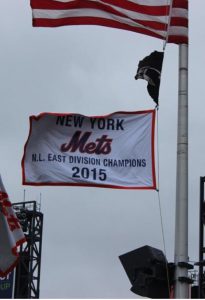 SEPTEMBER 27: My wife and I visit my dad. He’s in the ICU all of a sudden. He’s only vaguely aware of the Mets being division champions and drifts off a lot. The dream ends with us sitting around his bed watching 60 Minutes. SEPTEMBER 27: My wife and I visit my dad. He’s in the ICU all of a sudden. He’s only vaguely aware of the Mets being division champions and drifts off a lot. The dream ends with us sitting around his bed watching 60 Minutes.
OCTOBER 4: Dad has moved into a new facility, in line with the palliative care, and I’m at Citi Field for the final game of the season. Even in my dreams I go to Closing Day. The Mets win their 90th game (didn’t Sandy Alderson say that’s what this perennially sub-.500 team was going to do back in Spring Training, before I found it so difficult to stay awake?) and David Wright addresses the crowd, which seems unusual, but whatever. Also, we were apparently no-hit again the night before. Bring it on, subconscious. We’ve got playoffs, I think.
OCTOBER 9: We do have playoffs, Mets at Los Angeles. We win Game One. Daniel Murphy hits a home run off Clayton Kershaw, burning his name from his bat into the ball. Jacob deGrom strikes out 13. Such specificity. Also, deGrom plays a prank on Murphy during the postgame press conference, lowering his chair.
OCTOBER 10: Chase Utley, who is mysteriously a Dodger now, breaks Ruben Tejada’s leg by sliding into second base. Now I’m experiencing revenge dreams within my dreams at Utley’s expense. Mets lose.
OCTOBER 12: In what may be the weirdest dream of 2015 to date (and that’s saying something), I’m at Citi Field for the third game of the National League Division Series. Six seasons of Citi Field before this one, and I’ve never imagined, let alone dreamed, this place that so isn’t Shea Stadium, would either host one of these or get revved up for one of these. But, brother, is it ever. We’ve been waiting a long time to get loud, so it’s very loud — especially when Utley comes out as part of the introductions (we’ve all had revenge dreams) and then when Tejada comes out with the aid of cane festooned with Met logos. Best part of the dream is Cespedes hits a monster home run, the Mets win by a lot with Harvey pitching despite his agent’s protestations, and they’re one game from taking the series.
OCTOBER 13: The Mets are still one game from taking the series, since Clayton Kershaw beats them in this edition of my playoff dreams. Daniel Murphy hits another home run, though. And, oh, I’m there, like going to Citi Field for playoff games is now something I do.
OCTOBER 14: Guess which venue just showed up in my dreams again. Nope, not Citi Field — the Beacon Theatre. Am I looking for a beacon of light to guide the Mets safely to victory tomorrow night? For the record, I’m at a Steely Dan concert, and when they get to the part of “My Old School” that goes “California/tumbles into the sea…” I (in my Mets jacket) cheer, and I’m pretty sure I’m not the only one.
OCTOBER 15: I’m at the new place, with my dad. Whether the Mets advance in the postseason is at stake, and I’m watching on a palliative care facility TV. Not how I pictured it in my dreams, but that’ll show you what dreams know. The Mets are in trouble early. I must be having REM cycle problems sleeping. But Terry Collins stays with Jacob deGrom, Jacob deGrom hangs tough, Daniel Murphy both homers and does goofy stuff on the bases (that pays off) and, with some help from Syndergaard in relief, then Familia, we win. I mean, we win! I don’t know if I should shout too loud in this dream, given that there are probably a few older folks trying to sleep. Ah, what the hell — YIPPEE!!
OCTOBER 16: I dream there’s a picture going around the Internet of two Mets fans, one who was on the front page of the Daily News after the collapse of 2007, and one of another who was on the front page a year later after the collapse of 2008. They were both at Dodger Stadium looking really happy. Maybe my subconscious is no longer haunted by bad endings and Shea Stadium.
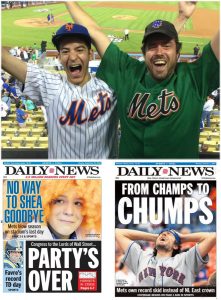 OCTOBER 17: Instead of being haunted by Shea, I am haunting Citi, site of Game One of the NLCS, Mets versus Cubs. How odd that it’s the Cubs in my dream. The Mets trying to catch the Cubs is where it all started for me as a fan, spurred on by my reading the Post my father would bring home every night. I’d see the standings and I’d see a cartoon on the back page, where the Cubs were the bear and the Mets were a bird of some sort, and now this? Does it mean some kind of full-circle in my relationship with my dad? While I ponder that, I note that my first NLCS game since 2006 (the Mets’ too, I guess) goes swimmingly. Murphy keeps hitting homers and we win. OCTOBER 17: Instead of being haunted by Shea, I am haunting Citi, site of Game One of the NLCS, Mets versus Cubs. How odd that it’s the Cubs in my dream. The Mets trying to catch the Cubs is where it all started for me as a fan, spurred on by my reading the Post my father would bring home every night. I’d see the standings and I’d see a cartoon on the back page, where the Cubs were the bear and the Mets were a bird of some sort, and now this? Does it mean some kind of full-circle in my relationship with my dad? While I ponder that, I note that my first NLCS game since 2006 (the Mets’ too, I guess) goes swimmingly. Murphy keeps hitting homers and we win.
OCTOBER 20: This dream says Game Three, at Wrigley. At the place where my father is hanging out, too. He’s sort of into the game when he’s awake (I should talk — I seem to be mostly into it when I’m asleep). The Mets take a three-oh series lead. Did I mention Murphy hit ANOTHER home run? And that the announcers in my dream said he hit one in Game Two? I don’t remember Daniel Murphy being this much of a power hitter.
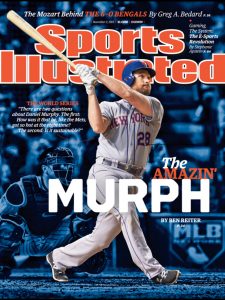 OCTOBER 21: I’ve never seen all of Back to the Future II, but in my dream, it’s significant that this is October 21, 2015, because apparently the Cubs win the World Series on this date in, you know, the future. (In, you know, the movie.) But never mind the movies. Let’s screen what I’ve been dreaming: the Mets win the pennant! Yes, Murphy has hit a home run in his sixth consecutive dream…I mean game. And though I’m watching from home, I get to share it with my father, as he calls me a few minutes after it happens. The strange part is he’s been calling me at all hours confused about whether it’s day or night, but in this part of the dream, he’s not only totally lucid, but simply calls to congratulate me, like he knows this is important to me, and that it was important to him to let me know that. OCTOBER 21: I’ve never seen all of Back to the Future II, but in my dream, it’s significant that this is October 21, 2015, because apparently the Cubs win the World Series on this date in, you know, the future. (In, you know, the movie.) But never mind the movies. Let’s screen what I’ve been dreaming: the Mets win the pennant! Yes, Murphy has hit a home run in his sixth consecutive dream…I mean game. And though I’m watching from home, I get to share it with my father, as he calls me a few minutes after it happens. The strange part is he’s been calling me at all hours confused about whether it’s day or night, but in this part of the dream, he’s not only totally lucid, but simply calls to congratulate me, like he knows this is important to me, and that it was important to him to let me know that.
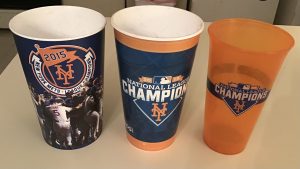 OCTOBER 25: I’m going up to my father’s place with a bag from Burger King. In my dream, my sister told me I should bring him a couple of cheeseburgers, that he likes Burger King cheeseburgers. I’ve avoided Burger King and its Golden Arched-brethren for years, but in my dream I go to the drive through and order some cheeseburgers. On my way up there, I notice Mets flags flying in people’s front yards. There’s something different in the air, and it’s not just the Burger King aroma. There’s no ballgame on, so it’s not much of a visit, and he’s not that into the cheeseburger. On my way home, my car is making a noise. I barely steer it into the parking lot. My driving has improved throughout these dreams, probably out of necessity. But it’s still an old car, just like my dad is an old dad. I eat the leftover cheeseburger. It doesn’t sit well. OCTOBER 25: I’m going up to my father’s place with a bag from Burger King. In my dream, my sister told me I should bring him a couple of cheeseburgers, that he likes Burger King cheeseburgers. I’ve avoided Burger King and its Golden Arched-brethren for years, but in my dream I go to the drive through and order some cheeseburgers. On my way up there, I notice Mets flags flying in people’s front yards. There’s something different in the air, and it’s not just the Burger King aroma. There’s no ballgame on, so it’s not much of a visit, and he’s not that into the cheeseburger. On my way home, my car is making a noise. I barely steer it into the parking lot. My driving has improved throughout these dreams, probably out of necessity. But it’s still an old car, just like my dad is an old dad. I eat the leftover cheeseburger. It doesn’t sit well.
OCTOBER 26: I call my mechanic in my dream and he wants to talk baseball, which I should relish, since he’s a Yankees fan and I’ve got a team in the World Series, but I get to the point, that my car has been making a noise and then some. Next thing I dream, it’s towed to his garage and I get a call that it’s the transmission, and he’s talking about me letting go of it, but with the Mets going to the World Series and me somehow making good on my word to my dad that I’m going to watch it with him (even if he’s not home, exactly), I’m not up for letting go of longstanding attachments. It’s going to cost a stupid amount of money, but I say go ahead, fix it.
OCTOBER 27-28: In my dream, I’m still without my car, so I have to take the Long Island Rail Road in several different directions to get to my dad’s. Not how I would have pictured watching the Mets in their first World Series in fifteen years, but I make it. We’re on the road playing Kansas City, a team I liked in that American League way when I was a kid, but now they’re my nemesis. Game One doesn’t go well. There’s an inside-the-parker from the Royals’ leadoff hitter, not a good sign. Something’ weird with the TV feed, which isn’t helping my father’s concentration. Fortunately it comes back, as do the Mets. It’s 3-3 in the eighth when the Royals’ first baseman, who has the same name as one of my cats, makes an error and we take the lead. Maybe I’m dreaming of Buckner and 1986, when my parents were as into the Mets as I was (but what New Yorker wasn’t?). Any chance this was gonna be a good dream goes out the window when Jeurys Familia gives up a ninth-inning home run, and it’s tied, and the night goes on and on and we lose in the fourteenth and I have to take an expensive cab ride home well after midnight.
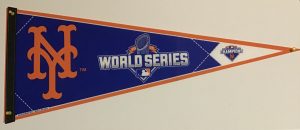 OCTOBER 30: The Mets are down oh-two in the Series, but I’m not giving up, because, according to the latest tributary of my dreamscape, I’m writing a book about the 2015 Mets, but it will only be published if they win. I’m working furiously on it before Game Three so I can have some of the chapters done and THEN walk to the train station and head for MY FIRST WORLD SERIES GAME. Not even in my dreams did I see the Mets in person in the Series in 1969, 1973, 1986 or 2000, but here I am, coming down the staircase from the 7 and taking in all the World Seriesness of it. I see a number of friends in the parking lot beforehand, including the California guy. It’s like we’re all getting our reward for our patience, and it makes me feel really good. Between one of the innings, they tell us to hold up our Stand Up 2 Cancer cards, which I do. I’ve written my father’s name on it. Daniel Murphy doesn’t hit a home run, but David Wright does. So does Curtis Granderson, but I don’t see it, because in this dream, the whole thing is almost too much and I have to get up and do a lap around Field Level. What else happened? Oh, Syndergaard! He’s brushed back that pesky leadoff Royals hitter, which was a welcome sight. Thor pitched well and we scored a lot and we won! I’ve seen the Mets win a World Series game in my dreams! Close enough to reality, I figure. OCTOBER 30: The Mets are down oh-two in the Series, but I’m not giving up, because, according to the latest tributary of my dreamscape, I’m writing a book about the 2015 Mets, but it will only be published if they win. I’m working furiously on it before Game Three so I can have some of the chapters done and THEN walk to the train station and head for MY FIRST WORLD SERIES GAME. Not even in my dreams did I see the Mets in person in the Series in 1969, 1973, 1986 or 2000, but here I am, coming down the staircase from the 7 and taking in all the World Seriesness of it. I see a number of friends in the parking lot beforehand, including the California guy. It’s like we’re all getting our reward for our patience, and it makes me feel really good. Between one of the innings, they tell us to hold up our Stand Up 2 Cancer cards, which I do. I’ve written my father’s name on it. Daniel Murphy doesn’t hit a home run, but David Wright does. So does Curtis Granderson, but I don’t see it, because in this dream, the whole thing is almost too much and I have to get up and do a lap around Field Level. What else happened? Oh, Syndergaard! He’s brushed back that pesky leadoff Royals hitter, which was a welcome sight. Thor pitched well and we scored a lot and we won! I’ve seen the Mets win a World Series game in my dreams! Close enough to reality, I figure.
OCTOBER 31: I’m back at Citi Field. I’m meeting up with people who have the tickets for Game Four. I see Bartolo Colon through a glass door. Someone in my dream yells BIG SEXY! at him and Colon waves without looking up. It’s Halloween, and people have come to the ballgame in costume. I run into a father and son who tell me they’re the ghosts of World Series past, dressed as “1969” and “1986”. I miss another home run, this one by Conforto, because I got up to go the bathroom and then opted for a slice of overpriced pizza (shortest line), but Conforto hits two, and I see the second. Unfortunately, all the nice dreams I’ve been having seem to catch up with me. Daniel Murphy, who’s on the cover of Sports Illustrated (cursed?) is no longer hitting, but he does make a crucial error. Cespedes gets himself doubled off base, too. The Mets lose and are one game from elimination. I just stand around a while as the ballpark empties out. It can be very lonely in my dreams.
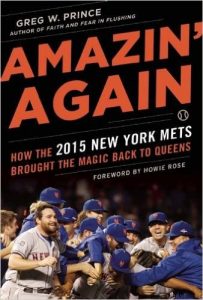 NOVEMBER 1-2: I never dreamed of the Mets playing in November, but here they are, trying to not lose the World Series, no matter what the calendar says. My car’s still in the shop. so I’m commuting by rail to get to my father’s. Matt Harvey is pitching really well. Granderson homers. Dad naps in and out of the action. It’s actually going pretty fast. Maybe I can make a decent-hour LIRR and wind my way home and then we can plan for Game Six. Maybe I shouldn’t have been thinking about such things prematurely because suddenly Harvey is on the mound in the ninth after yelling at Terry Collins in the dugout (I think he was gonna be taken out) and this long, painful drip of a Royals rally ensues. I’m not sure of the details. I may have blocked them out, but I do know it’s tied and we’re in extra innings again, and my father’s asleep and I’m texting with my sister which is REALLY weird, because she’s never cared about baseball, but in my mind in my dream I’m remembering my very first World Series memory: me and her running errands with Dad with Game One against the Orioles on the radio for my benefit. Don Buford homers off Tom Seaver, but Dad tells me it’s all right, there’s still a long way to go. We lose that game, but we win that Series. It, like the business about the Post and the standings and the cartoon, is the touchstone of my fandom. Full-circle? Going in circles? Why would my sister be watching the World Series? Not to see the Mets win, apparently. I dream the Royals score a ton of runs, again via details I block out, and Wilmer Flores, who everybody embraced back in July, takes strike three to end it. My father is awake by now and offers some condolences blended with some encouragement. He’s lying there in bed, unable to get up and walk out as I’m sure he’d prefer, and he’s telling me everything’s gonna be all right, just like in the Chrysler in 1969. I think I tell him I was glad to watch so much baseball with him. Or did I forget to mention that? I should’ve said something profound, but we’ve never talked to each other like that, so why make him uncomfortable with emotions? I don’t know. I have to take another expensive cab ride home, during which me and the driver end up talking about Carmelo Anthony for some reason. Then, in the dream, I get home, I write a whole lot about how much this weird dream of a season meant to me, I fall asleep (sleeping while I’m sleeping; I can’t make sense of anything anymore), and when I wake up, I learn my car is fixed, so I better pick it up, and they’re gonna publish my book despite the Mets losing, so I better finish it. NOVEMBER 1-2: I never dreamed of the Mets playing in November, but here they are, trying to not lose the World Series, no matter what the calendar says. My car’s still in the shop. so I’m commuting by rail to get to my father’s. Matt Harvey is pitching really well. Granderson homers. Dad naps in and out of the action. It’s actually going pretty fast. Maybe I can make a decent-hour LIRR and wind my way home and then we can plan for Game Six. Maybe I shouldn’t have been thinking about such things prematurely because suddenly Harvey is on the mound in the ninth after yelling at Terry Collins in the dugout (I think he was gonna be taken out) and this long, painful drip of a Royals rally ensues. I’m not sure of the details. I may have blocked them out, but I do know it’s tied and we’re in extra innings again, and my father’s asleep and I’m texting with my sister which is REALLY weird, because she’s never cared about baseball, but in my mind in my dream I’m remembering my very first World Series memory: me and her running errands with Dad with Game One against the Orioles on the radio for my benefit. Don Buford homers off Tom Seaver, but Dad tells me it’s all right, there’s still a long way to go. We lose that game, but we win that Series. It, like the business about the Post and the standings and the cartoon, is the touchstone of my fandom. Full-circle? Going in circles? Why would my sister be watching the World Series? Not to see the Mets win, apparently. I dream the Royals score a ton of runs, again via details I block out, and Wilmer Flores, who everybody embraced back in July, takes strike three to end it. My father is awake by now and offers some condolences blended with some encouragement. He’s lying there in bed, unable to get up and walk out as I’m sure he’d prefer, and he’s telling me everything’s gonna be all right, just like in the Chrysler in 1969. I think I tell him I was glad to watch so much baseball with him. Or did I forget to mention that? I should’ve said something profound, but we’ve never talked to each other like that, so why make him uncomfortable with emotions? I don’t know. I have to take another expensive cab ride home, during which me and the driver end up talking about Carmelo Anthony for some reason. Then, in the dream, I get home, I write a whole lot about how much this weird dream of a season meant to me, I fall asleep (sleeping while I’m sleeping; I can’t make sense of anything anymore), and when I wake up, I learn my car is fixed, so I better pick it up, and they’re gonna publish my book despite the Mets losing, so I better finish it.
That was the last entry. Everything must have returned to some semblance of normal after that. I don’t think I’ve experienced anything remotely like all of that since then, in my dreams or wide awake.
PREVIOUS ‘MY FAVORITE SEASONS’ INSTALLMENTS
Nos. 55-44: Lousy Seasons, Redeeming Features
Nos. 43-34: Lookin’ for the Lights (That Silver Lining)
Nos. 33-23: In the Middling Years
Nos. 22-21: Affection in Anonymity
No. 20: No Shirt, Sherlock
No. 19: Not So Heavy Next Time
No. 18: Honorably Discharged
No. 17: Taken Down in Paradise City
No. 16: Thin Degree of Separation
No. 15: We Good?
No. 14: This Thing Is On
No. 13: One of Those Teams
by Greg Prince on 22 March 2024 3:30 pm One of the core tenets to emerge amid the MY FAVORITE SEASONS, FROM LEAST FAVORITE TO MOST FAVORITE, 1969-PRESENT countdown is that the bromide “it’s not where you start, it’s where you finish” lacks foolproofitude. Sometimes the best part of a season is the start. Sometimes it’s somewhere in the middle. Sometimes it’s in the anticipation, like when you learn about a big-name signing to fill a gaping void on the eve of the next season, though what you’d really like is some follow-through once that season gets underway. If you’re extremely lucky, it is indeed where you finish, though you may have caught on that the Mets haven’t been extremely lucky all that often in this century.
Sometimes it’s where you spend the bulk of the regular season, the end of the regular season, a good bit of the postseason, and — if your head takes you there — the succeeding offseason. Sometimes, a fan makes the most of everything good that comes his way and learns to step around the unavoidable not-so-good. The not-so-good is always going to be unavoidable, but trust me: you can map out a detour.
***13. 2006
It’s January of 2024. My wife and I are watching the NFC Championship Game, the Lions at the 49ers, actually into it rather than simply having it on in the background while we scroll away on our devices. Every year at this time, bereft of baseball for months, I care more about football than I’d have suspected the previous summer. Stephanie thinks football looks good on TV and is capable of dipping into its spectacle on any given Sunday, especially if the HD picture is enhanced with a compelling storyline. This January, we have a doozy. Like all non-gambling Americans who are ostensibly unaffiliated in this matchup, we are Lions fans for the duration. Nothing against the Niners, but how can you NOT root for the team that has NEVER been to any of the previous LVII Super Bowls when they have an honest-to-goodness opportunity to make it to Super Bowl LVIII?
The Lions roar to a 24-7 lead and we offer sincere huzzahs for their (alas temporary) good fortune. We express genuine excitment for Michiganders we’ve never met. We don’t know any longtime, hardcore Lions fans, but today we are their auxiliary cheering section. Warming to the theme of the evening, we soon find ourselves sorting through teams that have waited so, so long to win the big one. In football, this automatically means the Lions and the Browns, two venerable franchises that have been on the clock ever since the 1970 NFL-AFL merger. No Supe for Detroit, ever; they haven’t gotten even this far since January of 1992, when Stephanie and I had been married precisely nine weeks. No Supe for Cleveland, ever…unless you count the Browns that became the Ravens…which, of course, you don’t. The last Browns team to win a National Football League championshp did so when I was turning two and Stephanie was, shall we say, not quite minus-three.
They Lions and the Browns, however, are hardly alone in Roger Goodell’s antsy waiting room. The Arizona Cardinals snuck into one Super Bowl, lost it late, and have to reach back to their Chicago incarnation and 1947 for their most recent NFL championship. The Atlanta Falcons have been been in the Super Bowl twice, led one of them by 25 points, yet have nothing in the way of an ultimate reward to show for their 1966 hatching. The Jets — for whom my “I’m more of a Giants fan, but I root for them, too” affinity has been on pause after sitting through a rain-soaked intraswamp debacle at the end of October — have gone cold for 55 years. The Dolphins, whose dynasty briefly captured my youthful fancy, just passed the half-century mark without augmenting their pair of Vince Lombardi trophies and are now four decades removed from their most recent trip to the Big Game (I can’t say I mind). The Cowboys have retained their glamour but haven’t gotten near a Super Bowl since their last win there XXVIII seasons ago (no complaints here). Washington was considered a jewel franchise, but their last significant celebration came the same January the Princes were newlyweds and the Lions last peaked. The then-Skins beat the Buffalo Bills to win it all that Sunday; the Bills are their own star-crossed story. As are, with less fanfare, the Bengals. And the Chargers. And the Vikings. And whatever happened to the Raiders? Didn’t they used to be an avatar of excellence? And didn’t they used to play in California?
These “haven’t since…” or “have never” totals can sneak up on fans and impartial observers alike. They can also disappear in a flash. Chiefs fans waited 50 years to re-enter the Kingdom of champions. Taylor Swift issues aside, when was the last time you conjured deep empathy for their cause? Hell, the Patriots, mostly futile from their founding in 1960 until a former Montreal Expos draft pick trotted into the huddle to relieve Drew Bledsoe in 2001, once presented a sympathetic face to the sporting world.
Natch, even before the Niners rally to ruin the Lions’ bid to cement their status as America’s Adopted Team (and two weeks before San Francisco guarantees it will extend its stealth Super Bowl championship drought to three decades), the conversation in our living room shifts to baseball. I am moved to catalogue the contact buzzes I’ve allowed myself as one overlong championship dearth of 40 or more years after another fell by the wayside ater the turn of the millennium: the Angels in 2002 (Stephanie joined me on that bandwagon, purchasing a few off-brand Rally Monkeys at our neighborhood Pathmark to send the Halos good vibes), the Red Sox in 2004, the White Sox in 2005, the Giants in 2010, the Cubs in 2016, and, to a lesser extent, the Astros in 2017 (extent lessened because of what came to light regarding their methods a couple of years later) and the Rangers in 2023 (I was rooting for the Diamondbacks, but it was still cool to see loyal Arlingtonians sip from their first goblet of glory after 52 seasons of building up a thirst). All this talk got me estimating how long is too long; when a wait becomes a drought; and when your team unquestionably becomes One of Those Teams everybody knows has been on the outside looking in forever.
Like the Lions, whose last NFL championship occurred in 1957.
Like the Browns, winners of it all most recently in 1964.
Like the Jets, I suppose. I’m just old enough to vaguely recall their standing as defending Super Bowl champions, but “January 12, 1969,” serves as much as a cudgel for the cruel these days as it does a milestone for the faithful, like “1940” did for hockey’s Rangers until 1994 (which wasn’t as long as it’s been for the Jets).
Like the Indians/Guardians, whose fans had to keep suffering toward and eventually past a seventh decade in order for the burden to be lifted from the shoulders of Cubs-lovers after 108 years.
Of course this led me to the Mets and how the 17 years between 1969 and 1986 represented a personal eternity, given that I waited between the ages of 6 and 23 for the second world championship. That’s being in first grade for the first one and being out of college a year-and-a-half by the second one. Even the wait between World Series appearances, from ’73 to ’86 was endless at that stage of my existence.
Thing is, I continued, every year without a championship is one year too many, but you have to be reasonable about it. Yeah, it sucked immensely to not win again in 1987, having now had a fresh taste of the top and then been denied an immediate next helping, but that was just one year. Boo-hoo, I’ve gone nearly 365 days without a ticker-tape parade. I could have made similar rationales to myself during the near misses and close calls that followed in ’88, ’89 and ’90 had I not been so aggravated by the near misses and close calls that followed in ’88, ’89 and ’90. It wasn’t until October 27, 1991, which happened to be the night the Twins and Braves were playing Game Seven of their World Series, that I really developed an inkling that length was coming into play. It was the fifth anniversary of our Game Seven victory, the one that vaulted 1986 onto the plane it shared with 1969 and no other Mets team. The Channel 4 news showed a clip of Jesse Orosco striking out Marty Barrett to commemorate the milestone. I was already aware of what date it was and what had happened five years ago tonight and what hadn’t happened since. Now it was This Date In History. For the first time since October 27, 1986, that world championship plane of ours was beginning to feel overly underoccupied.
I drifted from the Lions and Niners in front of us and heard myself reflecting aloud. I got older, I told Stephanie, and I waited for the Mets to make it back to the World Series. That took until 2000. Fourteen years, a pretty arid dry spell, I said. Stephanie nodded. She was there. She remembered. It was great to get where we got, but we didn’t win what there was to win, and the wait just kept getting longer. We passed 2003 emptyhanded, I added, noting that meant we would mathematically exceed those 17 years that spanned ’69 to ’86, and the next time we got to the World Series, in 2015 (also great), it was nearly 30 years — and when we didn’t win that one, it grew to exactly 30 years. It’s only grown longer since then.
The time I really thought we’d get it done, though, the time I decided was going to be perfect to get it done, I Metsplained to my wife (for not the first time, but she’s a good audience for reruns), the wait had already been long, but not as long as it would become. Not necessarily too long — not if it was going to come to an abrupt end, which I really and truly believed it would. The wait, at that point, was a 20-year wait. I was very ready for it to end after 20 years. So very ready. It should have. Twenty years was long enough.
But it didn’t end that year. It just kept going. It’s still going.
I started to detail why it should have happened for us that season and postseason, but I couldn’t quite get more than few words out without something get caught in my throat and something else welling up in my eyes. Stephanie understood. She was there then, too; she’s been with me a lot of seasons. I went silent for a moment, as if listening to the football play-by-play demanded my utmost attention. At last, I steered the subject into the long-term parking garage.
“Anyway, you don’t want to be One of Those Teams.”
Had the New York Mets won the World Series in 2006 and not again as of the Spring of 2024, it would be too long. Definitely too long. Longer than 1969 to 1986. But it wouldn’t be nearly as long as it is now, and the thought of the Mets being One of Those Teams wouldn’t have crossed my mind during the most recent NFC Championship Game or any time. That topic would be fodder for the Guardians fans (76 years since their last world championship in 1948) and the Pirates fans (45 years since 1979) and the Orioles and Tigers fans (41 and 40 years since 1983 and 1984, respectively) and the thus far altogether unrewarded followers of the Padres (born 1969), Brewers (relocated from Seattle 1970), Mariners (replacing the Pilots in 1977), Rockies (expansion class of 1993) and Rays (close but no cigar twice since swimming into being in 1998) AND it would be for the fans of any ballclub whose last World Series title came anywhere between 1987 and 2005. Our 18-year dry spell wouldn’t speak well for us in 2024, but at least we wouldn’t be wandering through the desert twice as long as we have been since 1986.
And who knows? We win in 2006, maybe we get the hang of it for 2007 and/or 2008. Maybe we stay on a perennial pennant path and don’t recede for eras at a time. Maybe we become One of Those Teams in a totally different sense of the phrase.
But we didn’t. We could have. We should have. We didn’t.
It’s 38 years and counting.
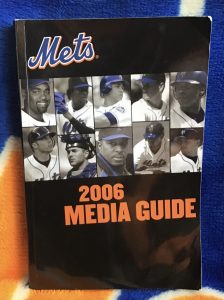 Of every Met year to have transpired after 1986, I’ve been absolutely convinced during only one of them that the Mets of the moment were on the verge of achieving their third world championship. In 2006, I knew as much as fan could think he knows it that THIS would be our year. Maybe not before it started, but before April was over I sensed strongly that we had a real shot. There were moments in May when we/I had to negotiate a pocket of uncertainty, but we/I made it through the month without a fatal stumble, and faster than you might say “hey, did you see where Pat Mahomes’s kid plays quarterback for Kansas City?” we took off and we never looked back. The divisional race was over by the middle of June, with us at the front of it, coasting in the direction of October, now and then revving our motor to demonstrate to any doubters we were capable of doing whatever it took to win whatever there was to win. Of every Met year to have transpired after 1986, I’ve been absolutely convinced during only one of them that the Mets of the moment were on the verge of achieving their third world championship. In 2006, I knew as much as fan could think he knows it that THIS would be our year. Maybe not before it started, but before April was over I sensed strongly that we had a real shot. There were moments in May when we/I had to negotiate a pocket of uncertainty, but we/I made it through the month without a fatal stumble, and faster than you might say “hey, did you see where Pat Mahomes’s kid plays quarterback for Kansas City?” we took off and we never looked back. The divisional race was over by the middle of June, with us at the front of it, coasting in the direction of October, now and then revving our motor to demonstrate to any doubters we were capable of doing whatever it took to win whatever there was to win.
I LOVED living in the heart of 2006. We won on Opening Day (helped by the lack of video replay review on a play at the plate; go tell it to a time machine), lost our second game in irritating fashion (perhaps the gods’ way of imbuing us with humility) and won our third game to take sole possession of first place. It was an item we held for the rest of the year. The Braves, who’d bullied us since suddenly remembering they played in the eastern half of the United States, had at last crumbled. We were five games ahead of them after the twelfth game of the season, and they were done. The Phillies, who annually boasted talent but lacked cohesiveness, could never quite get their act together. They had crept as close to 3½ games behind us as of June 7. By the afternoon we finished a three-game visit to Citizens Bank Park on June 15, we led them, our closest competitors, by 9½. Soon our margin over the pack was double-digits and it never slipped into singles.
For the first time since we’d pulled away from the Pirates in August of 1988, I knew — I mean knew — we were going to win our division. The 2006 Mets were NL East champs-in-waiting for more than half a season. The Wild Card, our treasured prize in 1999 and 2000, was for the rabble to fuss over. We’d effectively clinched first place.
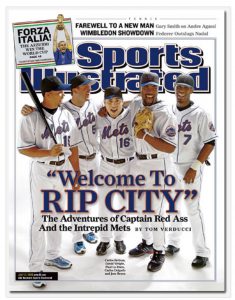 All at once, we were larger than life. It was such a step up from 2005 that I might have asked myself if this wasn’t all happening too soon (especially given that it was the second year of our blog, when I tended to pinch myself that we got to write about this kind of joyride), but then I’d remember twenty years was hardly too soon. So I got back to taking in all our enormity and reveling in it nonstop. Five Mets graced the cover of Sports Illustrated. Six Mets populated the National League All-Stars. Our new television network was a cable TV sensation. Our new ballpark was putting down stakes in Shea’s parking lot. Our Team, Our Time, as our goofy yet zeitgeisty attempt at an anthem put it. When the 1986 Mets swung by Shea in August to celebrate their china anniversary, they could have been forgiven for doing a double-take if they thought they were glimpsing a version of their younger selves. We were in the midst of a seven-game winning streak. We were nursing a 14-game lead. We were days away from swatting dramatic home runs to unnerve the Cardinals. By the end of the month, we’d have the best record in baseball. All at once, we were larger than life. It was such a step up from 2005 that I might have asked myself if this wasn’t all happening too soon (especially given that it was the second year of our blog, when I tended to pinch myself that we got to write about this kind of joyride), but then I’d remember twenty years was hardly too soon. So I got back to taking in all our enormity and reveling in it nonstop. Five Mets graced the cover of Sports Illustrated. Six Mets populated the National League All-Stars. Our new television network was a cable TV sensation. Our new ballpark was putting down stakes in Shea’s parking lot. Our Team, Our Time, as our goofy yet zeitgeisty attempt at an anthem put it. When the 1986 Mets swung by Shea in August to celebrate their china anniversary, they could have been forgiven for doing a double-take if they thought they were glimpsing a version of their younger selves. We were in the midst of a seven-game winning streak. We were nursing a 14-game lead. We were days away from swatting dramatic home runs to unnerve the Cardinals. By the end of the month, we’d have the best record in baseball.
Baseball Like It Oughta Be. Again.
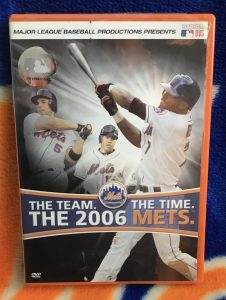 Jose Reyes and David Wright had blossomed into the superstardom that had been projected for them. Paul Lo Duca (Captain Red Ass, per SI) made us more or less forget Mike Piazza was still active and playing for somebody else. Carlos Beltran shook off his first-year New York tentativeness and put up MVP numbers. Carlos Delgado represented more of a good Carlos thing; between them, Belgado stroked 79 homers and drove in 230 runs. ¡Dos Carloses son mejores quen uno! Nobody saw Jose Valentin coming, yet he was hitting home runs regularly and filling the gap that had yawned at second base. Dos Joses, tambien. Nobody saw Endy Chavez coming, yet the erstwhile Met-killer (and before that Met farmhand) arrived to fill in all over the outifeld with defensive aplomb and timely hititng. Ancient Julio Franco revived as a pinch-hitter and team leader. Lastings Milledge showed a sample of his first-round stuff. Jose Reyes and David Wright had blossomed into the superstardom that had been projected for them. Paul Lo Duca (Captain Red Ass, per SI) made us more or less forget Mike Piazza was still active and playing for somebody else. Carlos Beltran shook off his first-year New York tentativeness and put up MVP numbers. Carlos Delgado represented more of a good Carlos thing; between them, Belgado stroked 79 homers and drove in 230 runs. ¡Dos Carloses son mejores quen uno! Nobody saw Jose Valentin coming, yet he was hitting home runs regularly and filling the gap that had yawned at second base. Dos Joses, tambien. Nobody saw Endy Chavez coming, yet the erstwhile Met-killer (and before that Met farmhand) arrived to fill in all over the outifeld with defensive aplomb and timely hititng. Ancient Julio Franco revived as a pinch-hitter and team leader. Lastings Milledge showed a sample of his first-round stuff.
 Were there reasons to worry? There are always reasons to worry. Fandom without worry is just wearing t-shirts that have a logo you like. The Cliff Floyd of 2006 wasn’t the Cliff Floyd of 2005, but there were definitely some big hits residing in his bat. He’d be fine. A taxi accident in Miami injured Duaner Sanchez and undermined the strength of our bullpen, motivating Omar Minaya to trade dependable right fielder Xavier Nady for relief depth, but we had a lot of arms out there, plus experienced hitter (and the most accomplished Jewish slugger since Hank Greenberg) Shawn Green on the way to replace ex-Met X-Man. We’d be fine. The starting pitching could be creaky at times, but among Pedro, Gl@v!ne, Trachsel, El Duque and whoever was the fifth starter in whichever week it was, it wasn’t like Willie Randolph couldn’t rely on guile and pedigree, along with blips of promise from younger fellows. We’d be fine. Were there reasons to worry? There are always reasons to worry. Fandom without worry is just wearing t-shirts that have a logo you like. The Cliff Floyd of 2006 wasn’t the Cliff Floyd of 2005, but there were definitely some big hits residing in his bat. He’d be fine. A taxi accident in Miami injured Duaner Sanchez and undermined the strength of our bullpen, motivating Omar Minaya to trade dependable right fielder Xavier Nady for relief depth, but we had a lot of arms out there, plus experienced hitter (and the most accomplished Jewish slugger since Hank Greenberg) Shawn Green on the way to replace ex-Met X-Man. We’d be fine. The starting pitching could be creaky at times, but among Pedro, Gl@v!ne, Trachsel, El Duque and whoever was the fifth starter in whichever week it was, it wasn’t like Willie Randolph couldn’t rely on guile and pedigree, along with blips of promise from younger fellows. We’d be fine.
You get through August with so much fine, you begin to feel invincible. We entered September with the best record in baseball. We were the first team to clinch — actually clinch — a division title. We nailed home-field advantage for the NL playoffs. What could stop us?
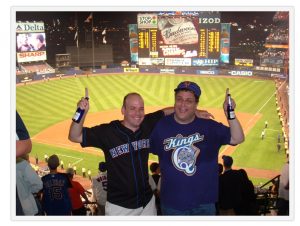 Pedro Martinez’s health had taken a turn for the worse. Between a bad calf and a worse rotator cuff, Pedro would be out for the postseason. That wasn’t good, but if we were being honest, though Pedro had made the All-Star team and had given us a robust push from April to June — and contributed to an extraordinarily satisfying burial of the Braves in July — we’d done a lot of what we’d done without him available. We could get by without Pedro if we absolutely had to. Pedro Martinez’s health had taken a turn for the worse. Between a bad calf and a worse rotator cuff, Pedro would be out for the postseason. That wasn’t good, but if we were being honest, though Pedro had made the All-Star team and had given us a robust push from April to June — and contributed to an extraordinarily satisfying burial of the Braves in July — we’d done a lot of what we’d done without him available. We could get by without Pedro if we absolutely had to.
Then there was something about El Duque’s calf acting up just before we were to play L.A. in the Division Series, and that was even less good, because El Duque had been so ageless and had picked up so much slack for the rotation when it looked wobbly. He was also a legendary postseason presence. Oof. But this is why we had more than a couple of pitchers. This is why John Maine had been readied. Maine started Game One of the NLDS and acquitted himself sufficiently (4.1 IP, 1 ER). So did Delgado (4-for-5, with a homer and two ribbies) and Floyd (a dinger of his own). And, oh, a defensive play for the ages, when three ex-Dodgers — Green in right, Valentin at second, Lo Duca at home — combined to retire two current Dodgers (Jeff Kent and Russell Martin) on the same play on consecutive tags at the plate. Shea Stadium, to my trained ears, had never been so loud, nor had it quaked so much. They may have had to have repounded those new-ballpark stakes in the parking lot after the way the old joint shook on 9-4-2 squared.
Gl@v!ne, who’d grown downright dependable in his fourth Met season, took care of L.A. in the second game. We flew west and finished off the sweep (our first in a postseason since ’69), with the offense abusing Greg Maddux, and Billy Wagner nailing the last out. Maddux and Gl@v!ne weren’t Braves? Wagner wasn’t an Astro? Me from the late ’90s would have had a hard time with the scorecards, but this was 2006, and everything was going as it was supposed to. We were moving on to the League Championship Series…the only New York team going so far, I don’t mind pointing out.
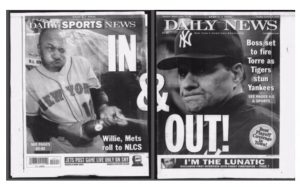 We took Game One of the NLCS from the Cardinals. Beltran socked a two-run homer, and the rest was handled by the capable arms of Gl@v!ne for seven, Guillermo Mota (an old Piazza nemesis we decided to tolerate for a spell) in the eighth and Wagner in the ninth. We’d now won four consecutive playoff games, on top of the final four during the regular season. Word was El Duque would be ready for the World Series, which was only three wins away. The October before, when the White Sox set fire to their 88-year drought, they lost only once en route to the title. Impressive, but not as impressive as were being. As I joined a mob chanting “LET’S GO METS” when we weren’t singing “HoZAY! HoZAY HoZAY HoZAY!!! HoZAY! HoZAY!” en route to Game Two from the LIRR’s Shea Stadium stop, I dared to think — and it didn’t seem like much of a dare — “we’re gonna go eleven-and-oh.” We took Game One of the NLCS from the Cardinals. Beltran socked a two-run homer, and the rest was handled by the capable arms of Gl@v!ne for seven, Guillermo Mota (an old Piazza nemesis we decided to tolerate for a spell) in the eighth and Wagner in the ninth. We’d now won four consecutive playoff games, on top of the final four during the regular season. Word was El Duque would be ready for the World Series, which was only three wins away. The October before, when the White Sox set fire to their 88-year drought, they lost only once en route to the title. Impressive, but not as impressive as were being. As I joined a mob chanting “LET’S GO METS” when we weren’t singing “HoZAY! HoZAY HoZAY HoZAY!!! HoZAY! HoZAY!” en route to Game Two from the LIRR’s Shea Stadium stop, I dared to think — and it didn’t seem like much of a dare — “we’re gonna go eleven-and-oh.”
I’d always been too superstitious to be so bold, but this team was rolling. The Cardinals drifted into the postseason with an 83-78 record. They had Albert Pujols, sure, but there was otherwise little about them that suggested destiny was propelling them. In the AL, the Tigers (who had been kind enough to have taken out the Yankees in the first round) were in the process of sweeping the A’s. We were already outclassing St. Louis. Detroit? Whatever. Twenty years had been enough in this part of New York. Two-Thousand Six was ours.
What could stop us?
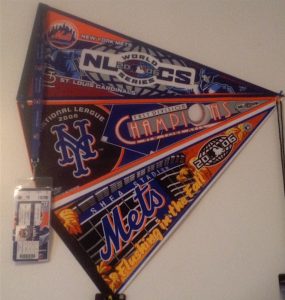 Maybe my hubris? Maybe Floyd going out of the lineup with his achilles bothering him? Randolph could have but didn’t shelve him before the NLCS began. Maybe our thinner than I cared to admit starting pitching? Maine wasn’t as adequate in Game Two against the Cardinals as he’d been the week before, letting an immediate 3-0 lead melt into a 4-4 tie. Maybe our well-worn bullpen? Neither Mota nor Wagner came through when it mattered most. Maybe our right field defense? Green in October sure looked a lot older than Nady had in the heady days of April. Maybe the Cardinals and whatever destiny the likes of So Taguchi (go-ahead homer) and Scott Spiezio (a torch of a triple in the eighth, a dagger of a double in the ninth) had packed? We lost the second game, 9-6, and the series was tied at one. So much for visions of 11-0. Maybe my hubris? Maybe Floyd going out of the lineup with his achilles bothering him? Randolph could have but didn’t shelve him before the NLCS began. Maybe our thinner than I cared to admit starting pitching? Maine wasn’t as adequate in Game Two against the Cardinals as he’d been the week before, letting an immediate 3-0 lead melt into a 4-4 tie. Maybe our well-worn bullpen? Neither Mota nor Wagner came through when it mattered most. Maybe our right field defense? Green in October sure looked a lot older than Nady had in the heady days of April. Maybe the Cardinals and whatever destiny the likes of So Taguchi (go-ahead homer) and Scott Spiezio (a torch of a triple in the eighth, a dagger of a double in the ninth) had packed? We lost the second game, 9-6, and the series was tied at one. So much for visions of 11-0.
Game Three in St. Louis was Steve Trachsel lasting one and Jeff Suppan lasting eight; we lost, 5-0, and trailed in the NLCS. We hadn’t trailed in any kind of standings since the second game of the season. We had 160 games to make up for it then. We basically had Game Four to reconvene our poise pronto. Our starter was Oliver Perez, one of the pieces moved Queensward in the post-Sanchez panic of the trade deadline. Perez was what was known as a project. Pittsburgh, which could have used all the help it could get, didn’t have the patience for him and packaged him along with Roberto Hernandez in the Nady swap. The Mets didn’t have to use him much down the stretch. He did throw a shutout in September, but even with Pedro and El Duque out, nobody was particularly counting on Ollie for October.
Now we had to count on Ollie. Ollie, in turn, counted on the Met offense, which withstood the Cardinals’ contingency starter, Anthony Reyes (ERA over 5), and then strafed three relievers. Perez carried an 11-3 lead into the sixth, and we breezed to an 11-5 finish in Game Four. Game Five would be future Hall of Famer Gl@v!ne versus historically shaky Jeff Weaver. T#m does what T#m’s been doing, and we keep hitting like we hit in support of Ollie, and “fine” returns to the forefront of Met fortunes.
But that didn’t happen. Weaver lasted longer than Gl@v!ne and gave up fewer runs. There was no particular salvation to be found in the bullpen portion of Game Five, either. The Mets, who’d scored at least six runs in four of their previous seven postseason contests, lost, 4-2. Our pitching was nothing special. Our hitting was inconsistent. Our fielding was hardly airtight. We were one game from elimination.
Then, back at Shea, everything exceeds fine for eight innings. Jose acknowledges all the HoZAYing by leading off with a homer versus Chris Carpenter. Green drives in a run, Lo Duca knocks home two, Maine and three relievers scatter baserunners and Wagner gets the ball for the ninth. It’s not a save situation, except for our season needing to be saved. Just three outs without four runs, Billy. Let’s go.
Billy, in the best tradition of those Met closers you kept telling yourself were really, really good despite your bones knowing the Met closer was never as good as you wished, put two on, got two out, then gave up a two-run double. Finally, a third out sealed it, 4-2. I stood in front of my seat throughout the top of the ninth. I fell into my seat when it was over.
Hubris was gone. Stayin’ alive was where it was at. The series was knotted at three.
My stomach might have been knotted, too.
I’d been in a splendid postseason groove in terms of passing through the gates of Valhalla, a.k.a. Shea. The Mets had played five home games thus far, and I was there for all of them. That wouldn’t be the case for Game Seven. This left me churning all day October 19 and not knowing what to do with myself once Perez threw the first pitch on TV. Sit? Stand? Wander in a small circle? I did it all, constantly. For a change, it was my cats not understanding my irrational movements.
It was 1-1 in the top of the sixth. I can tell you how it got that way, but it doesn’t matter. Ollie was pitching the game of his life and our lives, which was a blessing. Suppan was at least as effective, which was a problem. We weren’t looking for villains. With Jim Edmonds on second with one out and Scott Rolen up, we were holding out for a hero.
We got one — right, Gary Cohen?
Perez deals.
Fastball hit in the air to left field, that’s deep.
Back goes Chavez, back near the wall…leaping…and…
HE MADE THE CATCH!
HE TOOK A HOME RUN AWAY FROM ROLEN!
Trying to get back to first Edmonds…
HE’S DOUBLED OFF!
AND THE INNING IS OVER!
ENDY CHAVEZ SAVED THE DAY!
He reached high over the left field wall, right in front of the visitors’ bullpen and pulled back a two-run homer.
He went to the apex of his leap and caught it in the webbing of his glove with his elbow up above the fence, a MIRACULOUS play by Endy Chavez, and then Edmonds is doubled off first and Oliver Perez escapes the sixth inning.
The play of the year, the play, maybe, of the franchise history for Endy Chavez, the inning is over.
The apex of his leap. The apex of our year. The apex, maybe, of the franchise history. For a moment, nothing from 1962 forward felt bigger. We were living in it right here and now. No Met was ever more heroic on a baseball field, certainly in front of the left field wall at Shea Stadium, than Endy Chavez.
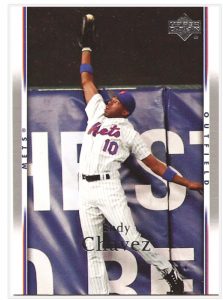 It was still 1-1. It was still 1-1.
My confidence soared. Then it plummeted. Up. Down. Standing. Sitting. Pacing. Shrieking. Silent. Probably yowling. Irking the kitties. I zipped back and forth for the next three-and-a-half innings between IT’S MEANT TO BE and WE’RE SCREWED, depending on what happened with each pitch, each swing, each take. WE’RE SCREWED took the pennant in seven games.
I’ve never made it from the beginning to the end of Staying Alive, the ill-conceived 1983 sequel to Saturday Night Fever, but I have managed to catch the coda to the movie’s climax, in which John Travolta as Tony Manero, now a Broadway dancer, asks his girlfriend, “Do you know what I wanna do? You know what I wanna do?”
“What?” she queries helpfully.
“Strut.”
And he hits the streets to the strains of the Bee Gees like he did back in 1977, when he was the king of the disco.
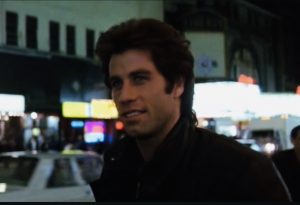 In the fall of 2006, once I compartmentalized my immediate heartbreak, you could tell by the way I used my walk that my team had executed a monumentally wonderful regular season-plus and had us on the brink of even more. Privately, I moped and mourned. To the outside world, I strutted around like I had in the fall of 1986. I wore my Mets jacket whenever feasible and stuck my chest out and used every bit of body language at my disposal to tell passersby that I was a self-appointed ambassador for the best damn baseball team in New York this year and you just watch what we’re gonna do next year. We weren’t world champions, but we might as well have been. In the fall of 2006, once I compartmentalized my immediate heartbreak, you could tell by the way I used my walk that my team had executed a monumentally wonderful regular season-plus and had us on the brink of even more. Privately, I moped and mourned. To the outside world, I strutted around like I had in the fall of 1986. I wore my Mets jacket whenever feasible and stuck my chest out and used every bit of body language at my disposal to tell passersby that I was a self-appointed ambassador for the best damn baseball team in New York this year and you just watch what we’re gonna do next year. We weren’t world champions, but we might as well have been.
More than a runner-up. More than a runner-up to me.
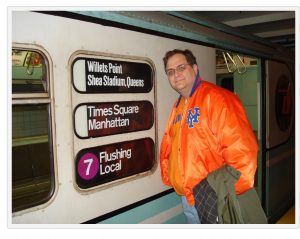 I really believed the front I was putting on. Give our team a little more time. This 2006 season will prove only the beginning of Met things to come. We’re gonna move on from Game Seven. We’re gonna withstand Suppan shutting us down in the sixth (with the bases loaded) and the seventh, and lefty Randy Flores doing the same to us in the eighth. We’re gonna get over Aaron Heilman giving up a two-run homer to Yadier Molina in the top of the ninth and the Cardinals shushing Shea, 3-1. We’re gonna render to a textured footnote the entire bottom of the ninth. I really believed the front I was putting on. Give our team a little more time. This 2006 season will prove only the beginning of Met things to come. We’re gonna move on from Game Seven. We’re gonna withstand Suppan shutting us down in the sixth (with the bases loaded) and the seventh, and lefty Randy Flores doing the same to us in the eighth. We’re gonna get over Aaron Heilman giving up a two-run homer to Yadier Molina in the top of the ninth and the Cardinals shushing Shea, 3-1. We’re gonna render to a textured footnote the entire bottom of the ninth.
The leadoff single from Valentin.
The single right behind him from Chavez.
Floyd hobbling to the plate only to strike out.
Edmonds robbing Reyes of a sinking-liner base hit that would have at least loaded the bases and likely scored Valentin from second (Edmonds’s thievery was not as dramatic as Chavez’s, but game is impelled to reluctantly recognize game).
Lo Duca walking to load the bases with two out, Anderson Hernandez pinch-running for the catcher whose walkup music happened to be Stayin’ Alive.
Rookie closer Adam Wainwright (in this role only because Old Friend™ Jason Isringhausen was sidelined with an aching hip) reinventing the curveball on the fly.
Carlos Beltran — who had detonated a walkoff bomb at Izzy’s expense in August — being perhaps a touch too selective on oh-and-two with two out (though you try hitting that curve).
All that? It was gonna serve as prologue for the real story, the multiple happy endings still to come for the post-2006 Mets. We lost a game and a series and a chance to go all the way ASAP, but we didn’t lose our future.
Reyes. Wright. The Carloses. The dazzling horizon. The whole thing was still right there in front of us. If I believed otherwise, would I be wearing this jacket with such conviction?
By the way, when I say I wore my Mets jacket, of course I had more than one. I had been hoping to add another to my wardrobe before 2007 arrived. At the last regular-season home game of 2006, when everything that could have been clinched had already been clinched and the postseason beckoned with so much promise, I saw somebody a few rows ahead of me wearing a varsity-style jacket commemorating on its back two world championships with two patches: one for 1969 and one for 1986. My companion that evening remarked it was quite an attractive jacket. Yeah, I said, but I wanna wait to get the revised version, the one with the third patch. I’m sure I wouldn’t have been the only one lining up to grab that jacket.
We’re still waiting.
PREVIOUS ‘MY FAVORITE SEASONS’ INSTALLMENTS
Nos. 55-44: Lousy Seasons, Redeeming Features
Nos. 43-34: Lookin’ for the Lights (That Silver Lining)
Nos. 33-23: In the Middling Years
Nos. 22-21: Affection in Anonymity
No. 20: No Shirt, Sherlock
No. 19: Not So Heavy Next Time
No. 18: Honorably Discharged
No. 17: Taken Down in Paradise City
No. 16: Thin Degree of Separation
No. 15: We Good?
No. 14: This Thing Is On
by Greg Prince on 19 March 2024 2:51 am For someone who writes plenty in the first-person, there’s nonetheless a phrase I try to avoid: “As I’ve written before…” It strikes me as self-aggrandizing, and to this point in the MY FAVORITE SEASONS, FROM LEAST FAVORITE TO MOST FAVORITE, 1969-PRESENT countdown, I have resisted the temptation to use it or, save for the winking inclusion of a screenshotted headline, explicitly refer to anything I’ve previously written on this blog.
But the season we’re about to revisit lives on for me mostly because it was the season I began to write on this blog. In the season when what you’re looking at all started, writing on this blog began to redefine me and my relationship to my team. I would never again consume Mets baseball without thinking of how I would put what I was experiencing into words.
As I’ve written before, the link between me and the Mets reached a whole new level of inextricable that year.
***
14. 2005
When the 2005 season ended, I thought I was one lucky sumbitch. What a year to construct, alongside a very good friend, a perch from which those two people could share their thoughts daily on what their favorite baseball team was up to. Our baseball team was up to so much!
Thinking back on it, had Faith and Fear in Flushing begun in 2003 or 2004 — years the Mets were trying to erase as they set their sights on what amounted to a total 2005 image reboot — there would have been a surfeit of material, too. Same for any season to which a hardcore fan/chronicler chooses to devote himself. It’s the Mets. We care. The story is always yearning to be put into words.
Nevertheless, I still believe 2005 was the perfect season for Jason and me to commence doing what we’ve spent the past nineteen seasons doing. I don’t know how in vogue the phrase “content” was among the media-savvy then, but brother, did 2005 give us content: content that made a fan/chronicler content, and content capable of filling a fan/chronicler with discontent.
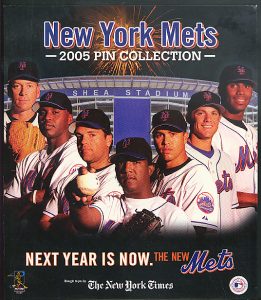 Downers in the course of 162 games were inevitable, but as a launching point, a team that finished four games above .500 and vied on the fringes of the Wild Card race until September grew serious manifested itself in everything a first-year blogger could have wanted — and wasn’t too bad for a longtime rooter, either. On its own merits, even if you didn’t commit to writing it up, 2005 was a quality season. Winning more games than you lose is always positive. Winning a whole lot of games is always preferable, but probably not reasonable to expect when you’ve just muddled through the previous two seasons losing 95 and 91, respectively. The 2005 Mets weren’t too hot. The 2005 Mets weren’t too cold. The 83-79 output of Team Just Right (featuring more than just Wright) sufficed. Besides, experiencing highs and lows provides a new blog with a bounty of storylines. Downers in the course of 162 games were inevitable, but as a launching point, a team that finished four games above .500 and vied on the fringes of the Wild Card race until September grew serious manifested itself in everything a first-year blogger could have wanted — and wasn’t too bad for a longtime rooter, either. On its own merits, even if you didn’t commit to writing it up, 2005 was a quality season. Winning more games than you lose is always positive. Winning a whole lot of games is always preferable, but probably not reasonable to expect when you’ve just muddled through the previous two seasons losing 95 and 91, respectively. The 2005 Mets weren’t too hot. The 2005 Mets weren’t too cold. The 83-79 output of Team Just Right (featuring more than just Wright) sufficed. Besides, experiencing highs and lows provides a new blog with a bounty of storylines.
Not that there weren’t already storylines galore awaiting us when we turned this thing on on February 16, 2005.
• Ace pitcher Pedro Martinez suddenly and shockingly descending from the stratosphere of superstardom to serve as face of this recently misbegotten franchise.
• Center fielder Carlos Beltran, coming off the postseason performance of a lifetime, and accepting a lucrative offer from a team that rarely proffered lucrative offers.
• The first true full seasons of shortstop Jose Reyes, 21, and third baseman David Wright, 22, avatars of homegrown promise and perhaps harbingers of a day when the likes of Martinez and Beltran wouldn’t have to be convinced too strenuously to join the humble Mets (and maybe we wouldn’t have to rely on glamorous free agents if we could keep growing players like these two kids).
• The approaching Met twilight of 36-year-old icon Mike Piazza, who had one year left on his contract, the wear and tear associated with a career full of catching, and no desire to return to his previous encampment at first base.
• The simultaneous lidlifting on the eras of Willie Randolph — respected New York baseball lifer at last receiving a chance to manage — and Omar Minaya — admired front-office mind tasked to run the whole show in Flushing.
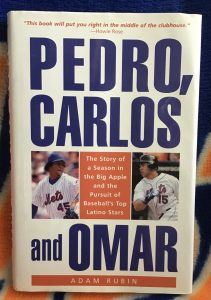 And those were just the storylines spelled out in advance. The season got into gear, and there was Cliff Floyd staying healthy while making pitchers sick; Beltran’s center field predecessor Mike Cameron reluctantly accepting reassignment to right; T#m Gl@v!ne seemingly settling in as an actual Met after two years working undercover as The Manchurian Brave; word that the Mets would soon air their own dedicated cable network; word that ownership and the city would collaborate on building a glittering new ballpark befitting these glittering New Mets (in conjunction with a bid for the 2012 Summer Olympics that were totally coming to NYC); and an onslaught of anxiety applied to a supporting cast whose identities were of paramount importance in 2005, even if hindsight suggests they were simply ballplayers trying to perform to the best of their ability and not necessarily meeting that goal on a sustained basis. And those were just the storylines spelled out in advance. The season got into gear, and there was Cliff Floyd staying healthy while making pitchers sick; Beltran’s center field predecessor Mike Cameron reluctantly accepting reassignment to right; T#m Gl@v!ne seemingly settling in as an actual Met after two years working undercover as The Manchurian Brave; word that the Mets would soon air their own dedicated cable network; word that ownership and the city would collaborate on building a glittering new ballpark befitting these glittering New Mets (in conjunction with a bid for the 2012 Summer Olympics that were totally coming to NYC); and an onslaught of anxiety applied to a supporting cast whose identities were of paramount importance in 2005, even if hindsight suggests they were simply ballplayers trying to perform to the best of their ability and not necessarily meeting that goal on a sustained basis.
As fans, we responded as we usually did when a starter didn’t last enough innings, or a reliever coughed up a lead, or a borderline veteran was taking at-bats that an unproven rookie could be using to prove himself. As fan/chroniclers, however, it was all new. So, we told ourselves, let’s form and share opinions about people whose names screamed relevance down the corridors of 2005, yet now whisper, “hey, remember how significant my effectiveness and/or production seemed to you when you were writing about me all those years ago?”
Less Miguel Cairo! More Anderson Hernandez!
Less Gerald Williams! More Victor Diaz!
Enough with Doug Mientkiewicz! Permanently install Mike Jacobs!
What the hell’s the deal with Kaz Ishii? Kris Benson? Victor Zambrano?
No, don’t bring in Felix Heredia…or Manny Aybar…or Mike Matthews…or Mike DeJean…or Danny Graves…or Tim Hamulack…or Shingo Takatsu.
WHEN ARE THEY GOING TO GIVE ROYCE RING THE BALL IN THE NINTH?
You can swap out most of those names for Mets who preceded or succeeded them in the middles of rotations or backs of bullpens or ends of benches to fill similar roles with modest results. Some things about 2005 weren’t as altogether eye-opening as they appeared. A gripe or a cause will always come along in the course of a season. I probably understood that innately then.
Yet I wrote as if everything the Mets did and every Met who did it was enormous. Because from my new perch as half of a Web site that endeavored to speak the Mets fan language to those who were fluent, it was. And they were. You had to love and had to obsess on this team, component by component, if you were going to make the most of this perch. It never occurred to me there was another way go about blogging our first season.
Besides, we had some highlights truly worth obsessing over.
Like that time that Aaron Heilman, en route from serving as a failed starter to a somewhat reliable reliever, snapped off a complete game one-hitter against Josh Beckett (when he was a big deal) and the Marlins (not yet having eviscerated their fairly recent world championship credentials). The only hit Aaron surrendered was a fourth-inning infield single to Luis Castillo, a name that doesn’t survive in Met lore as that guy who prevented our first no-hitter, for reasons that would become clear four years and one pop fly hence.
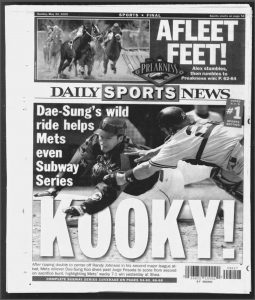 Like that time Dae-Sung Koo, a Korean working in America for this season and this season only, took his literal first swing in the major leagues — he’d struck out with the bat never leaving his shoulder in his only other plate appearance — and not only did it turn into a ringing double off Randy Johnson (when Johnson was mysteriously pitching for the Yankees), but Mr. Koo immediately thereafter came around from second on a bunt from Jose Reyes. Did we mention Mr. Koo, who legally had to be referred to as Mr. Koo, was a pitcher? Never won, lost or saved a game in 33 outings, and never batted again, either. Like that time Dae-Sung Koo, a Korean working in America for this season and this season only, took his literal first swing in the major leagues — he’d struck out with the bat never leaving his shoulder in his only other plate appearance — and not only did it turn into a ringing double off Randy Johnson (when Johnson was mysteriously pitching for the Yankees), but Mr. Koo immediately thereafter came around from second on a bunt from Jose Reyes. Did we mention Mr. Koo, who legally had to be referred to as Mr. Koo, was a pitcher? Never won, lost or saved a game in 33 outings, and never batted again, either.
Like that time journeyman Marlon Anderson pinch-hit a ninth-inning, game-tying inside-the-park home run, necessitating the acronym ITPPHHR for the first (and still only) instant in Mets history, finding the time during his 360-foot journey home to blow a bubble while gasping for air.
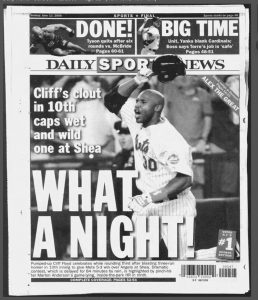 Like Cliff Floyd winning that very same ITPPHHR game with a more conventional shot over the wall in the bottom of the tenth. Like Cliff Floyd winning that very same ITPPHHR game with a more conventional shot over the wall in the bottom of the tenth.
Like Victor Zambrano, whom almost nobody trusted, outpitching Carlos Zambrano (no relation in any sense of the word) on Sunday Night Baseball.
Like Steve Trachsel, speaking of uninspiring starters, emerging from the DL in San Francisco to stymie the Giants by a score of 1-0, thanks to David Wright homering, that rare night when it was we who had the young differencemaker in our lineup.
Like preternaturally grizzled Roberto Hernandez stranding two runners and silencing tens and thousands of voluble doubters on a sweltering Shea afternoon when he struck out dangerous Derrek Lee to preserve a shutout started by Jae Seo.
Like Seo, never granted more than a rotation toehold, three months earlier throwing seven one-hit innings while knowing he was going to be sent back to Norfolk ASAP (roster-juggling has always been more art than science in these parts).
Like presumed-obsolete Miguel Cairo delivering a walkoff single as the Mets withstood impending elimination.
Like the great Pedro Martinez utlimately overwhelming an overwhelming John Smoltz on Easter Sunday.
Like the great Mike Piazza taking what amounted to a seven-minute curtain call on the final day of the season.
Like Chris Woodward, usually an infielder, making a dazzling catch in the outfield in a critical eighth inning.
Like Ramon Castro, usually a backup, belting a go-ahead dinger in another critical eighth inning.
Like Mike Cameron, for a time adjusting to right, slipping on grass, sticking out his glove, and snaring a sinking liner.
Like Kaz Ishii holding own versus Roger Clemens the last time Roger Clemens dared show his unpleasant Astro ass on the Shea Stadium mound, a night that proceeded with the starters exchanging seven zeroes apiece and ended with Jose Reyes driving in the game’s only run in the eleventh.
Like the Mets’ first win ever over an entity called the Washington Nationals, an enterprise that bore a modest resemblance to an outfit called the Montreal Expos.
Like the Mets’ first win at the Oakland Coliseum, or whatever corporate name it had that week, since the 1973 World Series.
Like the Mets’ last win the last time they would ever play at what was about to become old Busch Stadium, site of so much mutual snarling in the 1980s.
Like four consecutive Met wins at Bank One Ballpark by the composite romp of 39-7, a sweep so complete that a month later the Diamondbacks changed its name to Chase Field, presumably in the hope that the marauding band of New Yorkers wouldn’t be able to find the joint when they came back to administer more punishment in 2006.
Like so many times some Met, whether instantly or vaguely recognizable from the perspective of nearly two decades on, did something that seemed momentous and unforgettable in 2005 — yet momentum faded, and a memory hole opened and swallowed up most of what I would’ve sworn wouldn’t be easily forgotten.
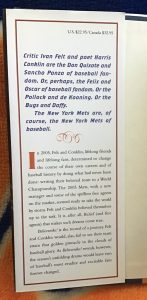 Sometimes I wonder whatever became of 2005, beyond the turning of the calendar. Oh, the calendar turned, all right. When the Mets arrived at their new home in 2009, only Reyes, Wright and Beltran remained on a continuing basis from four seasons prior, and each of them had accomplished enough in 2006, 2007 and 2008 to shroud in Citi Field fog whatever they’d achieved across 2005. Other than David’s barehanded grab of a fly ball in San Diego, not much among what the final three did way back then ever got replayed or widely referenced again. Video of Mr. Koo’s wild ride was a hardy Subway Series perennial, but Mr. Koo was back in Korea. Marlon Anderson did a Recidivist Met stint, but saw his ITPPHHR goodwill lapse during one collapse or another. Aaron Heilman’s incarnation as a somewhat reliable reliever post-one-hitter also carried an expiration date, and he was traded the winter Shea was being demolished. Pedro Martinez’s first and only outing at Citi was in a Phillies uniform, for crissake. Sometimes I wonder whatever became of 2005, beyond the turning of the calendar. Oh, the calendar turned, all right. When the Mets arrived at their new home in 2009, only Reyes, Wright and Beltran remained on a continuing basis from four seasons prior, and each of them had accomplished enough in 2006, 2007 and 2008 to shroud in Citi Field fog whatever they’d achieved across 2005. Other than David’s barehanded grab of a fly ball in San Diego, not much among what the final three did way back then ever got replayed or widely referenced again. Video of Mr. Koo’s wild ride was a hardy Subway Series perennial, but Mr. Koo was back in Korea. Marlon Anderson did a Recidivist Met stint, but saw his ITPPHHR goodwill lapse during one collapse or another. Aaron Heilman’s incarnation as a somewhat reliable reliever post-one-hitter also carried an expiration date, and he was traded the winter Shea was being demolished. Pedro Martinez’s first and only outing at Citi was in a Phillies uniform, for crissake.
Yet I’m convinced there was something more at work than time going undefeated contributing to what I’m willing to label insidious if inadvertent 2005 Mets Erasure.
My hastily cobbled theory suggests virality may have existed on the Internet as a concept, but things weren’t as shareable as they’d soon become. Message boards brought Mets fans together in community (it was how Jason and I first crossed paths in the mid-1990s) and comments sections were attached to Web sites in order to promote polite discourse of relevant topics and issues among strangers who claimed common interests, but if you didn’t stumble into Mets material on your computer, you had to work a little to find it. When Jason initially proposed we begin a blog, I went to Google and typed in “Mets” and “blog”. Facebook was something only high school and college students used; YouTube was just launching; and Twitter was a year away. Watching Met highlights meant tuning into local newscasts if you were in New York, or waiting for ESPN to get around to that night’s Mets game if you weren’t. Most 21st-century Mets action that aired prior to the 2006 creation of SNY (if it didn’t involve Mike Piazza hitting a home run on September 21, 2001) wound up receding into video archives that would go largely undisturbed, as if psychically the Mets had packed for the future but never got around to fully unboxing their stuff once they moved there. If a person said he read something a diligent beat writer like Adam Rubin wrote that morning, chances were pretty decent it meant that person bought a physical copy of the Daily News and turned actual pages of a sports section, usually past too many Bronx-focused column inches. Clipping and saving was becoming a lost, then different art.
The times, they were a-changin’ — as times always are — but at the confluence of our Met and media concerns, the times where 2005 reside belong to a transition period where only one foot appears firmly planted on the precipice of what is now the present. My perspective might be skewed by the fact that I am sitting in the same room and at the same desk where I sat when I wrote my first post for Faith and Fear. The first time Jason hit “publish” on my behalf (I wouldn’t learn to do that for myself for a few weeks), I became an online content creator. Mentally, however I was still dragging my feet out of what was left of the past. Hell, I’d keep going out and buying the News until 2007.
In the first year this blog operated, everything was so fresh and so urgent. There were arcs and trajectories and spurts and streaks and curiosities and quirks and kicks to the gut and reasons to believe unfurling in every direction until the season’s conclusion demanded they land at a dead end. There were trades rumored but not made. There were grudges molded and held between Opening Day and Closing Day, only to be set free, because, honestly, you’d sound like a lunatic today if you tried to convince somebody you once got up in arms about old Miguel Cairo getting at-bats that could have been going to young Anderson Hernandez.
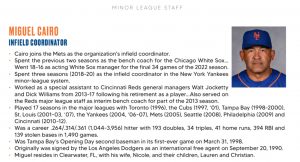 In September of 2023, I heard Howie Rose mention that Miguel Cairo, then the Mets’ minor league infield coordinator, had worked closely with Ronny Mauricio in advance of Ronny’s callup to the majors. Cairo was a veteran utilityman by 2005 and not all that productive per the ascendant advanced metrics of the era or, to be honest, any old-school statistics you could find in the paper. I seem to recall a groupthink developed within the budding ecosystem we called the Mets blogosphere that something was very wrong with your team’s philosophy if it depended on somebody like Miguel Cairo, which, in turn made me empathetic to the guy — he was 31, I was 42, each of us kind of old for what we were doing — while concurrently making me wonder if maybe he didn’t need to soaking up a roster spot on a team that could benefit from a nice youthful infusion (ah, gray area). As Howie explained in 2023 how helpful Cairo had been to Mauricio and Mark Vientos and Brett Baty, I remembered there was a time the mere mention of Miguel would represent a virtual red cape inside an online bullring. In September of 2023, I heard Howie Rose mention that Miguel Cairo, then the Mets’ minor league infield coordinator, had worked closely with Ronny Mauricio in advance of Ronny’s callup to the majors. Cairo was a veteran utilityman by 2005 and not all that productive per the ascendant advanced metrics of the era or, to be honest, any old-school statistics you could find in the paper. I seem to recall a groupthink developed within the budding ecosystem we called the Mets blogosphere that something was very wrong with your team’s philosophy if it depended on somebody like Miguel Cairo, which, in turn made me empathetic to the guy — he was 31, I was 42, each of us kind of old for what we were doing — while concurrently making me wonder if maybe he didn’t need to soaking up a roster spot on a team that could benefit from a nice youthful infusion (ah, gray area). As Howie explained in 2023 how helpful Cairo had been to Mauricio and Mark Vientos and Brett Baty, I remembered there was a time the mere mention of Miguel would represent a virtual red cape inside an online bullring.
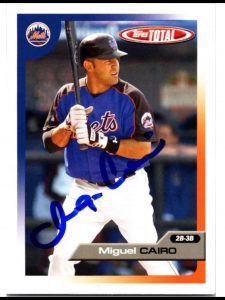 Now it was many years later, and Miguel Cairo, who last played in the majors in 2012 (two years later than Anderson Hernandez did), was part of some rising rookie’s story, and Howie didn’t see fit to elaborate on Cairo’s 2005. I doubt any listener began to fume at the mention of the man’s name or rue his FanGraphs WAR of -0.5, because, well, that was a long time ago. It’s likely some Mets fan somewhere is still steaming at some 2005 Met or perhaps the entirety of the 2005 Mets for not coming through when crucial victory was a pitch or hit away (we were a half-game out of the Wild Card on August 30), but I find it hard to believe anybody instinctively or theatrically recoils at the possibility of being reminded of the shortfalls that loomed so large in the moment the way “1987” evokes Pendleton or “1988” evokes Scioscia. At most, a then-crushing defeat, like Braden Looper blowing an unblowable lead on a Friday night in Pittsburgh, looms in miniature, and only for somebody who relishes remembering to begin with. Now it was many years later, and Miguel Cairo, who last played in the majors in 2012 (two years later than Anderson Hernandez did), was part of some rising rookie’s story, and Howie didn’t see fit to elaborate on Cairo’s 2005. I doubt any listener began to fume at the mention of the man’s name or rue his FanGraphs WAR of -0.5, because, well, that was a long time ago. It’s likely some Mets fan somewhere is still steaming at some 2005 Met or perhaps the entirety of the 2005 Mets for not coming through when crucial victory was a pitch or hit away (we were a half-game out of the Wild Card on August 30), but I find it hard to believe anybody instinctively or theatrically recoils at the possibility of being reminded of the shortfalls that loomed so large in the moment the way “1987” evokes Pendleton or “1988” evokes Scioscia. At most, a then-crushing defeat, like Braden Looper blowing an unblowable lead on a Friday night in Pittsburgh, looms in miniature, and only for somebody who relishes remembering to begin with.
Yet, damn, 2005 happened for a whole year, I mean really happened, and we printed receipts.
Faith and Fear in Flushing preceded by a few months a notable format change on New York radio. It was one of those stories, akin to so many developments within a baseball season: huge in its day, yet recalled rarely outside the province of obsessives once that day grew distant. On June 3, 2005, WCBS-FM gave up on what remained of its long-running oldies format and flipped to JACK-FM. JACK-FM, which had attracted listeners in other markets, was terrestrial radio’s response to the iPod craze. It was supposed to be a music format that didn’t adhere to a music format. The slogan was Playing What We Want.
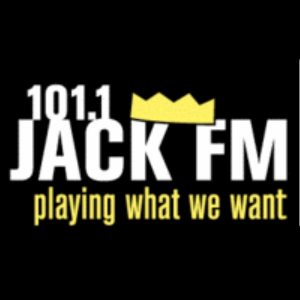 Here at FAFIF-FM, we played what we wanted in stereo…or wrote what we wanted the way we wanted. We didn’t pretend to be newspaper reporters or, god forbid, talk radio hosts. We were fans/chroniclers. We chronicled the Mets, but we also chronicled being Mets fans. What it was like watching the Mets on MSG or Fox Sports Net New York or Channel 11. What it was like listening to the Mets on WFAN, if they weren’t bumped to a more staticky frequency. What it was like to go to Shea Stadium, as one would after pushing out of the 7 local at the Willets Point-Shea Stadium station and streaming with the throng headed down the spiral staircase that left a ticketholder in the shadow of Gate E. I’d take out my ticket, hope security wouldn’t bother my bag too much, shove my raincheck in my back pocket (I knew where I was going) and trusted the escalators supposedly gliding up toward Loge, Mezzanine or the Upper Deck were in working order. I bitched about the schlep every bit as much as I embraced my destination, warts and all. My, yes, there were warts. The PA was too loud. The food was too cold or hard or depressing, yet somehow costly. The puddle in the concourse — there was always a puddle in the concourse — was too much like a lake. The know-it-all in my row, the one who repeatedly insisted he would do a better job of batting than Carlos Beltran, was too much. Here at FAFIF-FM, we played what we wanted in stereo…or wrote what we wanted the way we wanted. We didn’t pretend to be newspaper reporters or, god forbid, talk radio hosts. We were fans/chroniclers. We chronicled the Mets, but we also chronicled being Mets fans. What it was like watching the Mets on MSG or Fox Sports Net New York or Channel 11. What it was like listening to the Mets on WFAN, if they weren’t bumped to a more staticky frequency. What it was like to go to Shea Stadium, as one would after pushing out of the 7 local at the Willets Point-Shea Stadium station and streaming with the throng headed down the spiral staircase that left a ticketholder in the shadow of Gate E. I’d take out my ticket, hope security wouldn’t bother my bag too much, shove my raincheck in my back pocket (I knew where I was going) and trusted the escalators supposedly gliding up toward Loge, Mezzanine or the Upper Deck were in working order. I bitched about the schlep every bit as much as I embraced my destination, warts and all. My, yes, there were warts. The PA was too loud. The food was too cold or hard or depressing, yet somehow costly. The puddle in the concourse — there was always a puddle in the concourse — was too much like a lake. The know-it-all in my row, the one who repeatedly insisted he would do a better job of batting than Carlos Beltran, was too much.
And there was still nowhere else I wanted to be. Let me tell you about it…
Maybe once a year one of the papers would write a ballpark feature. Usually we in the stands were just “the crowd” or “the fans”. We were said to have cheered or booed or maybe chanted something clever or obscene. We weren’t the story. We weren’t in the box score. At Faith and Fear (and, depending on their respective missions, at our compatriot blogs that sprung up in the same Spring ours did), we made ourselves as much the story as the players and the game. We made what it meant to be a fan central to the story, not only when we went to Shea, but when we got home, when we got up the next morning, and whenever we found ourselves thinking about the Mets, which was, we didn’t mind telling anybody who was reading, almost all the time. How a baseball fan functioned was the lifeblood of a baseball season, and I swear it felt like we had an exclusive in delivering that reality.
We weren’t JACK-FM. JACK-FM’s calling card, besides supposedly playing what they wanted, was having no personalities talking between songs (the gimmick didn’t last; whoever owned the 101.1 frequency switched it back to something approximating the old WCBS-FM two years later). We aspired to let who we were seep through the ball talk. It wasn’t enough to communicate that Beltran had gone deep or Reyes had stolen a base or Pedro had quashed a threat. We had to tell you where we were, what were thinking, how it elevated our hopes, how those hopes were validated or dashed, and maybe what we had for dinner. It was fans chronicling fandom. It was what we wanted to do. It was what readers connected with. The most resonant feedback we received in 2005 — and still sometimes hear, if not as much now that social media exists and everybody can express themselves for an audience — was some version of “I thought it was just me who was like that about the Mets.”
Baseball seasons are long affairs. Even with a game filling a roughly three-hour block on a given night or day 162 nights or days per year, that leaves waking hours without baseball being played, waking hours with thoughts of baseball orbiting the brain. It hardly seemed efficient to have this wonderful perch and fire it up only after a Mets game was over.
Informally first, then as a weekly feature dubbed Flashback Friday, I opened a portal to my past that intertwined with the Mets’ past. My journey was mine, but it wasn’t dissimilar to that of anybody reading about it. It wasn’t just me who was like that about the Mets. We’d all had that journey leading up to 2005. We’d all started somewhere as Mets fans. We all exulted, depending on vintage, in 1986 and 1969. We were all overcome by gloom in 1993 and 1979 and years like those. But you didn’t read about it in the papers. On this blog, you read about it as a matter of course. It’s how baseball worked in my head and probably your head. I didn’t see how I could spend 2005 writing about the Mets and limit myself to writing about the 2005 Mets.
And now 2005 is one of those long-ago seasons that I invite to intrude on the present.
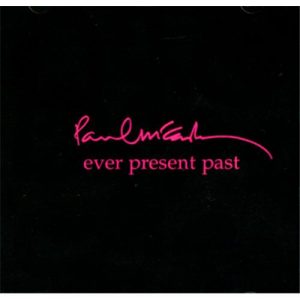 At the risk of loading a description, I haven’t been a “normal” fan since 2005. It rarely occurs to me to not filter my life through an orange-and-blue prism and muse if this or that is something that belongs on Faith and Fear. And that’s just life. It’s never occurred to me over these nineteen years to not care about everything the Mets do, though I’ve probably developed discernment over how much inherent value any single bulletin carries for blogging purposes. I certainly haven’t watched a game without instinctively thinking about what I will write, whether it’s a game for which I’m the designated recapper or not, because there’s always something to write eventually. Everything became and continues to be content. My ever present past lingers as prelude for what I might write tomorrow. If I stopped to realize how much older I am now than I was in 2005, it could give me pause, but it probably wouldn’t. I relish having lived through so much Metwise, but age as a figure simply doesn’t resonate for me in this realm. In this realm, I’m as old as I feel. At the risk of loading a description, I haven’t been a “normal” fan since 2005. It rarely occurs to me to not filter my life through an orange-and-blue prism and muse if this or that is something that belongs on Faith and Fear. And that’s just life. It’s never occurred to me over these nineteen years to not care about everything the Mets do, though I’ve probably developed discernment over how much inherent value any single bulletin carries for blogging purposes. I certainly haven’t watched a game without instinctively thinking about what I will write, whether it’s a game for which I’m the designated recapper or not, because there’s always something to write eventually. Everything became and continues to be content. My ever present past lingers as prelude for what I might write tomorrow. If I stopped to realize how much older I am now than I was in 2005, it could give me pause, but it probably wouldn’t. I relish having lived through so much Metwise, but age as a figure simply doesn’t resonate for me in this realm. In this realm, I’m as old as I feel.
As in 2005, I feel like writing about the Mets.
PREVIOUS ‘MY FAVORITE SEASONS’ INSTALLMENTS
Nos. 55-44: Lousy Seasons, Redeeming Features
Nos. 43-34: Lookin’ for the Lights (That Silver Lining)
Nos. 33-23: In the Middling Years
Nos. 22-21: Affection in Anonymity
No. 20: No Shirt, Sherlock
No. 19: Not So Heavy Next Time
No. 18: Honorably Discharged
No. 17: Taken Down in Paradise City
No. 16: Thin Degree of Separation
No. 15: We Good?
by Greg Prince on 15 March 2024 4:47 pm What Met tidings do the ides of March bring this spring? I’d like to believe glad, though in the middle a month devoted to merely getting ready for the season ahead, who can tell?
Two sentences, two question marks. Only in March? Always in March.
Entering the action of March 15, which includes a game matching Met prospects versus National prospects — ideal when everything is about waiting and seeing, and seeing and waiting — the Mets’ record this Spring is 9-8-1. I’ll take that to mean everything is going along as it should. No more than half of any game to this point in Grapefruit League play is designed to replicate the games played from Opening Day forward. Some regulars charge onto the exhibition field in February, others wait until early March to as much as cross a foul line (while still others wait out a lingering biceps issue amid assurances that it’s no big deal). Established regulars ready themselves at their own pace. Those fighting for recognition either open eyes by taking advantage of their opportunity or get a temporary pass for their statistical setbacks because, c’mon, it’s only Spring. The lineups that look legitimate in the top of the first are a hodgepodge of All Others no later than the seventh.
Our Spring Training as fans took hold many Springs ago. We are trained to understand little of what we might be tuning in for matters in cobbling a throughline to, this year, March 28. If the Mets were winning all these games that don’t count, I’d be a little nervous. If the Mets were losing all these games that don’t count, I’d be verging on apoplectic. Instead, the Mets are not too hot, not too cold; we’re Team Just Right. Met defense — now known as run prevention — seems to be in sync to date with our not bad, could be better, don’t take it too seriously yet motif.
Still, you have to like that Met starting pitching, whose Senga-deprived composition seems an advertisement for hoping to get the most out of what adequacy you have, has mostly quelled opponents’ starting hitting, whoever composes it in a given inning. The perennial bromide of the pitchers being ahead of the hitters is a handy touchstone for reminding us how Spring Training operates. The Met pitchers being very far ahead of the Met hitters, however…ah, it’s Spring, you tell yourself. I’ve noticed not a lot of runs being driven in or scored by either the fellows whose names are a little hard to read (thanks, Nike/Fanatics/MLB) or the fellows who have yet to rate names on their backs (who doesn’t love when No. 97 is at bat and a different No. 97 is on deck?). This, too, shall pass, or we shall hope it does, especially if the front office continues to pass on the professional hitters still available on the surprisingly open market.
I’m also generating preliminary faith in the coalescing 2024 Mets bullpen, an instinct that courts danger, because, you know, Mets bullpens. Nevertheless, many of the guys who crept into the transaction column on little cat feet are hinting that they and their array of different looks are capable of building the bridge from however much the adequate starting pitching can construct to the ninth inning. To engineer truly meaningful ninth innings, the offense and defense will have to drive in and prevent runs, respectively. Let’s hope they do, because if we get the ninths we desire, we’ll get Edwin Diaz.
One glad tiding above all has permeated my Spring consciousness, and that was the return earlier this week of Diaz. It wasn’t the ninth, because it’s never the ninth for a closer when a closer is just feeling his way into Spring, but never mind the inning. It was Edwin coming to pitch in a game for the first time since the World Baseball Classic just about a year earlier, and we all remember the postscript to that appearance.
Monday night in St. Lucie, it wasn’t so much the trumpets blaring for Edwin Diaz. It was that drumbeat that precedes the trumpets when you hear Sugar making his way to the mound. My Pavolovian response was to salivate, especially from my tear ducts. The whole “Narco” bit was a blast in 2022. In 2023, it morphed into nostalgia for the grand old days, à la watching grainy footage of Cleon Jones dropping to one knee ten years after 1969, or stumbling across video of a little roller up along first, convincing me in a season like 1993 that a season like 1986 actually happened. The idea of Edwin Diaz last year might have meant more to me than the reality of Edwin Diaz the year before. And he meant a lot the year before.
This is the new year, and we’ve got the old Diaz, based on one inning, three batters and three strikeouts, everything looking good, nobody indicating they feel anything but good. If that’s the lone highlight of this Spring, then the highlight reel is robust.
***This week has brought two other pieces of news to which it is difficult to apply the descriptor “glad”, but an upbeat spin is possible when you pull back and take in the bigger picture.
Darryl Strawberry suffered a heart attack Monday night. The part to be glad about is Darryl himself posted to social media, “I am so happy and honored to report that all is well,” with an Instagram photo from his hospital bed revealing a smiling Straw. Over the past several years, Darryl has channeled his celebrity into ministering. Whenever he’s asked about baseball, he swears it’s no longer close to being of utmost importance to him. Yet baseball must still mean something, as he was in Port St. Lucie earlier this Spring and he has expressed great enthusiasm about being back in Flushing at the beginning of June to see his No. 18 retired. Let’s be glad that Darryl is recovering and will have the chance to continue to do what means most to him…and that what he did as a Met will always mean a ton to us.
Jim McAndrew died at the age of 80 on Thursday. I’m eternally glad I grew up with Jim McAndrew in my pitching rotation. Say the name “Jim McAndrew” (or his hometown of Lost Nation, Iowa) to me, and I’m a kid again, feeling blessed that a talent like his informs the astonishing depth that skews my perception of what Met pitching should be for the rest of my rooting life. Thinking back on how good Jim McAndrew so often was in the shadows of Seaver and Koosman and Gentry and Ryan and Matlack, throwing less hard stuff while receiving less consistent opportunities, I realize that had Jim McAndrew come along in some later Met times, he would have gotten the ball every fifth day, and we would have been well off for it.
The Met heyday of McAndrew, a starter 110 times between 1968 and 1973, yielded some indelible highlights, none more transcendent than the eleven innings he threw on the evening of September 10, 1969. You read that right: eleven innings, all in the service of pitching the Mets into first place for the very first time. That was the “LOOK WHO’S NO. 1” night, when the tiring Cubs lost in the afternoon, and McAndrew gave up single runs to the Expos in the first and second innings of the opener of a twi-nighter at Shea before holding the fort like crazy into extras. The Mets would win in twelve, sweep the doubleheader, grip first place and never give it up.
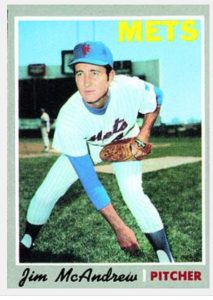 The Mets selected Jim in their very first amateur draft class, the same June 1965 crop that yielded Nolan Ryan and Ken Boswell. Three summers later, McAndrew’s initiation into the National League stands historically as a quintessential exercise in perseverance. As a pitcher in 1968, a.k.a. The Year of the Pitcher, he wasn’t alone in being put on a run-support starvation diet, but what Jim had to endure represented a whole other level of asceticism. In his first four starts, he tossed 24.2 innings, kept his ERA to 1.82, and came away with an 0-4 record. The Mets scored literally nothing for him in each of his starts. To get himself into the win column, he had to outduel future Hall of Famer Steve Carlton, 1-0. To get there again (following losses of 2-0 and 2-1), he had to top future Hall of Famer Fergie Jenkins, 1-0. The Mets selected Jim in their very first amateur draft class, the same June 1965 crop that yielded Nolan Ryan and Ken Boswell. Three summers later, McAndrew’s initiation into the National League stands historically as a quintessential exercise in perseverance. As a pitcher in 1968, a.k.a. The Year of the Pitcher, he wasn’t alone in being put on a run-support starvation diet, but what Jim had to endure represented a whole other level of asceticism. In his first four starts, he tossed 24.2 innings, kept his ERA to 1.82, and came away with an 0-4 record. The Mets scored literally nothing for him in each of his starts. To get himself into the win column, he had to outduel future Hall of Famer Steve Carlton, 1-0. To get there again (following losses of 2-0 and 2-1), he had to top future Hall of Famer Fergie Jenkins, 1-0.
As a rookie and into the prime of his career, Jim McAndrew proved he could pitch with anybody, whatever uniform they were wearing. In six seasons as a Met, he was part of a world champion once and a pennant-winner twice. In his post-playing days, he always showed up when the 1969 Mets were introduced en masse to take his well-deserved bow. In 2015, I’m told, he paid his way to Kansas City to cheer on the most recent National League Champion Mets. Fantasy campers have warm memories of the tips they received from Coach McAndrew. Save for a brief stint with San Diego, he was literally a lifetime Met.
“My arm was live and I was in a good groove,” is how Jim recalled his 1969 effectiveness for Stanley Cohen in A Magic Summer. If that’s not an image to make a Mets fan glad, I don’t know what is.
by Greg Prince on 11 March 2024 2:20 am Connoisseurs of the Academy Awards’ In Memoriam montage — the inspiration behind Faith and Fear’s annual salute to the Mets Who Have Left Us (in the baseball sense) — are inevitably miffed by the incompleteness of the televised salute, as there never fails to be some beloved contributor to the world of film who gets left out in deference to time constraints. To be fair to those who produce the montage, many people work in motion pictures, and it’s impossible to include everybody who might rate acknowledgement. Bruce Davis, a former Academy executive, recently shared with the Washington Post a story that illustrates the difficulties inherent in creating a tribute that is both well-meaning and all-encompassing.
Davis once received a call from an emotional stranger who said he was leaving Cedars-Sinai Medical Center, where his father had just died. How could he submit his name to the In Memoriam segment?
“I had never heard his father’s name,” Davis says, “and I consider myself reasonably knowledgeable of who’s had a significant career in the industry.” So Davis looked him up. The man had three tiny nonspeaking roles in 1940s westerns.
“I’m thinking: This poor guy is going to be watching the show, waiting for his father’s name, maybe even a picture of him,” Davis says. “He has no concept of how many people would qualify.”
This blog is not nearly so selective. The baseline qualification for the FAFIF montage is twofold. A person had to have a) played for the Mets and b) left or been nudged from the organization between the previous year’s Oscars telecast and the one that just happened. We might also tip a cap to a non-player who moved on during the time period in question if that person’s inclusion is deemed appropriate. But the core policy we’ve followed since introducing this feature in 2007 has been we excerpt a passage exemplifying how every Met who has left us existed within the pages of Faith and Fear during his Met tenure…even the baseball equivalent of the actor whose IMDb credits are limited to three tiny nonspeaking roles in 1940s westerns.
We have quite a few of those this year. Of the 35 players (along with one other fellow of surpassing significance) we’re about to remember, 14 played in no more than 10 games as a New York Met. I’m confident in asserting that you’ve already forgotten several of them. There’s a decent chance you were never more than barely aware of a few of them. Modern-day roster manipulation tends to make some men Mets for a minute, yet nary a minute more.
Usually the Mets Who Left Us spotlight presents a final opportunity to say goodbye to the players we got to know pretty well, players who were part of our lives as fans, players we consciously or otherwise adopted as our own. Hopefully you’ll feel some of that here, but this edition will also likely have you saying something along the lines of “I’m sorry, did I know you?”
___
TYSON MARCUS MILLER
Relief Pitcher
August 14, 2023
Miller to Coonrod to Bickford to Gott. Ortega and Araúz. Yep, just like we planned it.
—August 15, 2023
(Selected off waivers by Dodgers, 8/27/2023)
___
EDWIN DANIEL UCETA
Relief Pitcher
April 22, 2023
Meanwhile, Edwin Uceta, who went on the IL in April following three innings of work in a single relief outing, was activated on Wednesday only to find himself simultaneously designated for assignment. “What do Santana, Butto, Miller, Reyes, Yacabonis and Curtiss got that I ain’t got?” Uceta might have been heard to think. Hard to build team morale when the team keeps becoming a slightly different team.
—August 16, 2023
(Selected off waivers by Cubs, 8/18/2023)
___
DENNIS ANFERNEE SANTANA
Relief Pitcher
April 1, 2023 – August 18, 2023
Santana is a pitcher we got from the Twins. The last time we got a pitcher named Santana from the Twins, it was an enormous deal. It worked out well.
—March 29, 2023
(Free agent, 8/22/2023; signed with Yankees, 12/6/2023)
___
ABRAHAM ALMONTE
Outfielder
August 8, 2023 – August 26, 2023
The Mets did a little threatening in the eighth — two on — and the ninth — Lindor leading off with a single. The threats proved idle. Alonso lined to deep right for the first out of the ninth, leaving Lindor on first and bringing up Daniel Vogelbach. Ryder and I had been moments earlier bemoaning the stubborn presence of Vogelbach on the 2023 Mets’ roster. In August of 2022, Vogey was the right hitter at the right time for a contender, even if he usually required a pinch-runner to complete his rounds. In August of 2023, we don’t celebrate his designated bat any longer. There’s no Terrance Gore, no Tim Locastro to steer his additional 270 feet from first to home should Vogelbach somehow accomplish the first 90 feet. There is Abraham Almonte, the 34-year-old callup we saw make his Met debut, but Almonte is no pinch-runner. For These Mets, Almonte was Tuesday’s starting right fielder.
—August 9, 2023
(Free agent, 10/4/2023; signed with Olmecas de Tabasco (Mexican League), 2/1/2024)
___
SAMUEL TIMOTHY “Sam” COONROD
Relief Pitcher
August 14, 2023 – September 12, 2023
That last homer was particularly welcome, coming after Grant Hartwig and Sam Coonrod sandwiched a competent inning from Phil Bickford by doing what the bullpen does seemingly every night these days. Hartwig and Coonrod were nice stories for about five seconds earlier this season; now when you see either of those young men you consider hiding behind the couch before remembering that a) what the hell, the season’s already lost; and b) at least they’re not Trevor Gott or Drew Smith.
—September 13, 2023
(Free agent, 11/17/2023; currently unsigned)
___
GARY SANCHEZ (Herrera)
Catcher
May 21, 2023 – May 23, 2023
Alvarez? He’s the starting catcher on the same team. Gary Sanchez, an idea that might have been worth trying out in a practical sense if there was no better option behind the plate or in the lineup, was designated for assignment Thursday. By the time he got a few reps in 2023, the position he played belonged to the much younger man.
—May 26, 2023
(Selected off waivers by Padres, 5/29/2023)
___
ADAM JOHN KOLAREK
Relief Pitcher
August 20, 2023 – August 26, 2023
When the Mets began the sixth with Lindor’s double and Vogelbach’s eleventh home run of the season to cut Atlanta’s lead to 3-2, a game that played as frustrating for the New Yorkers turned to perhaps promising. Yet despite the continued effective relief pitching of Kolarek, Reed Garrett and Brooks Raley, a trio who combined for three-and-a-third scoreless innings, the Mets never could plate the tying run.
—August 23, 2023
(Free agent, 8/29/2023; signed with Braves, 8/31/2023)
___
ZACHARY E. “Zach” MUCKENHIRN
Relief Pitcher
May 3, 2023 – June 9, 2023
Lefty reliever Zach Muckenhirn made his debut for us, and it didn’t go badly. Muckenhirn is the 1,197th Met overall and, barring who knows what before today’s first inning, will always have the pleasure of knowing he will always sit directly above prospective Met No. 1,198 Justin Verlander on the franchise’s all-time chronological roster.
—May 4, 2023
(Traded to Mariners, 7/3/2023)
___
TIMOTHY JOHN “T.J.” McFARLAND
Relief Pitcher
June 28, 2023 – July 9, 2023
With the Mets scoring seven runs and the visiting Brewers scoring none entering the eighth inning, the stage should have been set for T.J. McFarland. “Pulsipher to McFarland,” it was said. Too good a throughline to interject, “Don’t forget Roger Mason and Rick Parker,” from when there’d been barely more than 500 Mets overall. All that was needed was the enormous lead to remain immense, and there’d be no reason to not bring in from the bullpen for the ninth inning the southpaw who would forever be the 1,205th Met overall and inch us closer to 700 Mets we could say we’ve shared across 29 years and counting of counting. Except Jeff Brigham gave up a couple of runs, and Buck Showalter, too nervous to screw around too much these days, turned to Dominic Leone to finish up, and we had to settle for the Mets breezing to a 7-2 win and staying stuck on 1,204 Mets overall. Still, a delightful evening like so many we’ve enjoyed in neighboring seats in so many seasons in a couple of different apple-laden ballparks. We got everything but T.J. McFarland for our Tuesday night troubles.
—June 28, 2023
(Free agent, 7/18/2023; signed with Orioles, 7/23/2022)
___
ANTHONY BENJAMIN KAY
Relief Pitcher
September 24, 2023 – October 1, 2023
Hello to Long Island’s Own Anthony Kay, the 1,218th Met overall and a fellow who can be said to have waited longer than most Mets to become Mets. We drafted him in 2013 (didn’t sign). We drafted him anew in 2016 (he did sign). We traded him in 2019 (for Marcus Stroman, who had one of those eventful Met tenures that a couple of years later doesn’t seem like it actually happened). We grabbed LIOAK back on waivers recently and called him up to fortify the bullpen from the left side, which he did with a scoreless inning-and-a-third Sunday. Who says you can’t go home again for the first time?
—September 25, 2023
(Selected off waivers by A’s, 10/24/2023)
___
KHALIL RASHAD LEE
Outfielder
May 17, 2021 – June 11, 2022
[I]t was Khalil Lee pinch-hitting for Drew Smith. Khalil Lee had the distinction of being both the last guy you’d think of to pinch-hit, considering he was 0-for-8 with eight strikeouts in his brief career, and the last guy you had who roughly answered to the description of “hitter” left on the bench. Lee therefore was distinct enough to get the chance to break his ohfer. And he did, doubling like he’d done it before, driving in Dom to give the Mets a 4-3 lead.
—May 22, 2021
(Released 5/8/2023; signed with Southern Maryland Crabs (Atlantic League), 6/1/2023)
___
DOMINIC JOSEPH LEONE
Relief Pitcher
May 4, 2023 – July 29, 2023
Having generated such a thoughtful response from Buck pregame, I wondered if I could ask him a followup in the seventh: “What’s this debilitating fascination you have with Dominic Leone?” Leone, who hasn’t inspired an iota of confidence during his Met tenure to date, got bailed out by his defense in the sixth. He responded to his good fortune by loading the bases in the seventh.
—May 20, 2023
(Traded to Angels, 8/1/2023)
___
MICHAEL VINCENT “Vinny” NITTOLI
Relief Pitcher
June 23, 2023 – August 19, 2023
The way they’ve been playing, they can get rid of everybody. The names of the pitchers received for Escobar are Coleman Crow and Landon Marceaux. At this juncture of their affiliation with the Mets, they are slightly less familiar to me than Vinny Nittoli, the journeyman reliever who made his Met debut in the 5-1 loss at Citizens Bank Park Friday. Nittoli pitched a scoreless inning once it became apparent that, in the scheme of the game he entered, it didn’t really matter what he did. In the scheme of the season in which the Mets’ 75th game was played, it has become apparent that no individual game really matters, either.
—June 24, 2023
(Free agent, 10/24/2023; signed with A’s, 10/27/2023)
___
JOHN DICKENS CURTISS
Relief Pitcher
March 31, 2023 – August 4, 2023
I’d like to say I didn’t know the game was lost at 3-1, but that was just too many almosts for one half-inning when the opponent is the Braves. Maybe it would have been too many almosts for one half-inning when the opponent is anybody, but the Braves have been the Braves too much and too long, especially too recently, where the Mets are concerned. Almost-ing them isn’t gonna cut it, especially when they’re being definitive about increasing their lead off Mets starter Denyi Reyes. Reyes gives up a single to Michael Harris II and a homer to Kevin Pillar. Reyes is replaced by Syracuse recallee John Curtiss. Curtiss gives up a homer to Acuña. Instead of cutting into the Braves’ edge further or tying them or passing them, we fall further behind them. Arithmetically, allowing three hitters to become three runners who cross the plate can equal no more than three runs. It felt like more.
—May 2, 2023
(Free agent, 11/6/2023; signed with Rockies, 1/25/2024)
___
TREVOR VAUGHAN GOTT
Relief Pitcher
July 6, 2023 – September 27, 2023
Buck told Trevor to do what Trevor does, and he responded. In retrospect, it was methodical, but in the moment, it wasn’t easy. Nothing about this game was easy. I watched it with a piercing sinus headache that didn’t get any better from the presence of Trevor Gott.
—September 20, 2023
(Free agent, 11/17/2023; signed with A’s, 12/15/2023)
___
MICHAEL PEREZ
Catcher
August 15, 2022 – October 1, 2023
It became a 3-2 Mets loss despite recalled catcher Perez rapping out four hits from the nine-hole in his first game back from Triple-A, only the second time the Mets have ever lost a game with that kind of bottom-of-the-order production, and surely the first time they’d been held to a mere two runs with their last batter proving himself entirely unretirable.
—May 15, 2023
(Free agent, 10/24/2023; signed with Orioles, 12/30/2023)
___
JAMES ALLIN “Jimmy” YACABONIS
Relief Pitcher
April 16, 2023 – August 11, 2023
Meanwhile, the post-Max pack, led for two-and-two-thirds by Jimmy the Yak, picked up the Scherzerless slack. A potential ace tour de force became a bullpen game, and for the last six innings, Jimmy Yacabonis plus Jeff Brigham, Drew Smith, David Robertson and Adam Ottavino did the best thing relief pitchers can do: they got the job done. […] Afterward, when Scherzer paused from claiming perfectly permissible “sweat and rosin” long enough to answer a question about how well Yacabonis pitched in his place on no notice, Max smiled and said the long reliever definitely deserved a steak dinner, presumably on him. That’s really nice, assuming Max washes his hands before passing the potatoes.
—April 20, 2023
(Free agent, 8/15/2023; signed with Long Island Ducks (Atlantic League), 9/5/2023)
___
DANIEL “Danny” MENDICK
Utilityman
June 24, 2023 – September 30, 2023
The Mets lost by the typographically correct if competitively averse score of 21-3 in Saturday afternoon’s makeup game versus the Braves, the day portion of a split-admission doubleheader necessitated by an April rainout and cruelty. The Mets were losing only 13-3 when they were using pitchers; utilityman Danny Mendick allowed eight runs in the ninth, indicating his utility has its limits.
—August 12, 2023
(Free agent, 10/24/2023; signed with White Sox, 2/8/2024)
___
JEFF JOHN BRIGHAM
Relief Pitcher
April 18, 2023 – September 21, 2023
Turning to rookie lefty Josh Walker to get outs with a three-run lead didn’t work out. At all. A walk. A single. A walk. An exit. The Mets still lead by three. The manager brings in Jeff Brigham, a veteran righty who was surprisingly consistent in earlier innings in earlier weeks of this season, a little less so has time has gone on. Still, Brigham bounces the first batter he faces, Bohm, to third base. That could very well be a double play ball. All the third baseman, Brett Baty has to do is field the ball cleanly and throw it quickly and accurately. But he doesn’t. He double clutches, he throws low to second, everybody is safe, every base is occupied and a run has scored. Brigham has been undermined by his defense but is still protecting a lead. He must face three batters in all. The second of them, Brandon Marsh, walks with the bases loaded. OK, not good, but the Mets still lead. Then Kody Clemens strikes out, which is much better. Hitting Kyle Schwarber…no, not very good at all. The game is tied. Then, upon Brigham’s fifth batter, Turner…another HBP. It is now Phillies 7 Mets 6. At last, Brigham is removed.
—June 26, 2023
(Free agent, 11/17/2023; signed with Twins, 2/13/2024)
___
TIMOTHY DONALD “Tim” LOCASTRO
Outfielder
March 31, 2023 – October 1, 2023
Bottom of the sixth Sunday. Tim Locastro leads off versus Carson Spiers. Spiers is the nephew of 1995 Met Bill Spiers. Carson’s skipper is the grandson of 1962 Met right fielder Gus Bell. Locastro relates to Spiers by lofting a fly ball above short right field. It doesn’t fly that much, but it stays in the air a spell and it has its eye on No Red’s Land. It falls in. Tim, a burner, sees he can take advantage of the ball’s elusiveness and hustles. It’s a HUSTLE double! A BLOOP double! No such thing as a bloop homer, and you pretty much have to be Marlon Anderson and receive a lot of luck to Van McCoy your way into a home run if you didn’t clear the fence. Triples have to go far, too. Doubles don’t have to travel all day if the right fellow hits the ball in just the right spot. Alas, Locastro didn’t score, as nobody drove or wild-pitched him in. The Mets were leaving a few too many of their crew to fend for themselves on the bases as the day progressed.
—September 18, 2023
(Free agent, 11/6/2023; signed with Padres, 2/28/2024)
___
DARIN CORTLAND RUF
Designated Hitter
August 5, 2022 – October 8, 2022
The transitory thrills were provided in the fifth by pinch-hitter Darin Ruf in his first Met plate appearance (two-run double to right) and pinch-hitter Eduardo Escobar (single to bring home Ruf). So much pinch-hitting produced so many pinch-ribbies that we were pinching ourselves, then convincing ourselves the tying run was coming to bat every inning. Maybe it was. Maybe we hallucinated. Wearing too much black in such hot weather can cause mirages.
—August 6, 2022
(Released, 4/3/2023; signed with Giants, 4/8/2023)
___
DENYI REYES
Pitcher
April 4, 2023 – October 1, 2023
But if it were just Reyes shaking off his 15.88 ERA as a starter in 2023 — gathered over two outings that lasted fewer than six innings — and holding the Rangers in check for five-and-a-third, leaving the game with an unlikely two-run lead that set the Mets up for their victory…well, solid pitching from mysterious sources materializes from time to time. Plus, this was the first start in which Reyes’s first name was pronounced “Den-gee” by Mets announcers rather than the intuitive “Den-yee” or Americanized “Denny”. Perhaps this Reyes is somebody else altogether. Or perhaps he hired as his private pitching tutor former Met stalwart Dillon Gee and the lessons took.
—August 31, 2023
(Free agent, 11/6/2023; signed with Samsung Lions (Korean Baseball Organization), 1/4/2024)
___
JONATHAN ALDAIR ARAÚZ
Infielder
August 2, 2023 – September 17, 2023
It’s easy to pick on guys we’ve never heard of when they suddenly appear in our uniform. I did it after Wednesday’s game when presented the likes of Jonathan Araúz as my starting second baseman. Is it the fault of a professional baseball player who entered 2023 with nearly 200 big league plate appearances that I don’t know him from a hole in the head? I apparently saw him play on television in 2020; it’s on his permanent record that he competed against the Mets in two games inside an empty Fenway right after the pandemic mini-slate got underway. In the fourth inning Thursday, Araúz grabbed a sinking liner and turned into a heady double play. All right, now Jonathan isn’t just a strange name. He’s done something. He’s a Met. Four innings later, Araúz undermined a 5-4 putout when he received a throw from Brett Baty in the neighborhood of second base. The baserunner he thought he’d forced was initially called out, but the Royals, using eyes, challenged and got it overturned (the umpire must have not been in the vicinity of the neighborhood). It wasn’t one of those plays they had to show from myriad angles to determine if the fielder’s foot was off the bag. The fielder’s foot might as well have been on the bus to Syracuse.
—August 4, 2023
(Free agent, 10/24/2023; signed with Dodgers, 12/15/2023)
___
RAYMOND THOMAS “Tommy” HUNTER
Relief Pitcher
May 7, 2021 – June 9, 2023
When the Mets play their erstwhile National League expansionmates in matchup of first-place occupants in Houston, they will have Tommy Hunter ready to go as one-eighth of their formerly nine-man bullpen. Hunter returned to Met duty on Sunday after a detour to Tampa Bay in 2021 when, like [John] Paciorek, he had to deal with back problems, but — no irony intended — he is back. Hunter didn’t pitch for the Rays while he was gone, meaning we can categorize good ol’ Tommy not so much as a Recidivist Met (someone who played for the Mets; played for somebody else; then returned to play for the Mets some more) but as a Met Once Removed (someone who played for the Mets; left for another organization without logging any MLB action while away; then got his Met on again in an active player sense, thus precluding the necessity to include Chris Schwinden and his umpteen waiver claims from 2012). As defense attorney Jackie Chiles told his clients in the Seinfeld finale, “You people have a little pet name for everybody.”
—June 20, 2022
(Released 6/13/2023; retired, 12/13/2023)
___
RAFAEL ANGEL ORTEGA
Outfielder
August 1, 2023 – October 1, 2023
Me, I had Rafael Ortega. And now I will always have Rafael Ortega, even if the Mets won’t after this season ends. Ortega ensured his sliver of Met immortality by sinking a fly ball along the edge of No Man’s Land, or at least not inside Renfroe’s zone of defensive comfort in right field. Hunter nearly made a stumbling catch that would have likely resulted in Locastro tagging up and scoring, because however strong the right fielder’s arm, his angle wasn’t optimal to make an effective throw.
—August 28, 2023
(Free agent, 10/24/2023; signed with White Sox, 1/5/2024)
___
STEPHEN JAMES NOGOSEK
Relief Pitcher
June 19, 2019 – June 8, 2023
Stephen Nogosek
Picks up his glove in the pen
And he starts to get warm
Buck likes his form
Waiting since Sunday
Stretching in back with the pack
Of the arms seldom used
Tries to stay loose
—May 12, 2022
(Free agent, 6/14/2023; signed with Diamondbacks, 6/16/2023)
___
THOMAS JAMES “Tommy” PHAM
Outfielder
March 30, 2023 – July 30, 2023
After the inning Canha moved to first, McNeil to right and Guillorme to second — none of which mattered, as Brooks Raley walked one and struck out three — Tommy Pham doubled with one out. He was the tying run on base, which was great. Pham doing something of an extra-base nature…I was wary. Pham seems to light it up most in Met losses. Coincidence, I’m sure, but you tend to infer what you begin to sense are trendlets. Another trip to Baseball-Reference is booked to ascertain if Pham the Met hits his best in games that become losses is something akin to a trend or just a figment of the selective imagination.
—June 12, 2023
(Traded to Diamondbacks, 8/1/2023)
___
DAVID ALAN ROBERTSON
Relief Pitcher
March 30, 2023 – July 25, 2023
David Robertson was handed the ball for the bottom of the ninth. The bottom of the eighth didn’t work out so well for Robbie this past Friday, when Patrick Bailey, somebody else’s catching wunderkind, took him too deep with too many on. But that was in a month when no Met not named Tommy Pham could do right. This is a new month. By the bottom of the ninth, in New York at least, it was a new day. After midnight, David was protecting his third lead of July. The first two Arizonans were retired with ease. The third was Christian Walker, the slugger who had the curious and drowsy looking up Dillon Gee and Freddie Freeman. The count Walker worked was the same full version Alvarez constructed versus Chafin. These Snakes were one swing away from whacking an otherwise pleasing storyline. These Snakes this year have been one of the best teams in the league. These Mets…not so much. Robertson relied on his offspeed stuff and Walker flailed above it for strike three. The Mets, left for dead in the desert barely minutes before, had sprung ahead and stayed there, 2-1 winners.
—July 6, 2023
(Traded to Marlins, 7/27/2023)
___
DANIEL TAYLOR VOGELBACH
Designated Hitter
July 24, 2022 – September 22, 2023
That brought Alonso home from second and then, perhaps not a matter of seconds later, Daniel Vogelbach home from first. Daniel Vogelbach is a player I can’t take my eyes off, and not just because he fills so much of my field of vision. You’ve probably seen silent movies in which the walking appears a little sped up, due to the technical limitations of the era. When Vogie takes a pitch (he takes a lot of them) and ambles away from the plate to collect himself, he may as well be Buster Keaton or Charlie Chaplin in motion. It’s not for comedic effect. He moves quickly if not exactly speedily. He knows everything he is doing out there. If he’s come to grips with his limitations, he’s just as determined to take advantage of his capabilities. One of them is running the bases. From what we’ve seen, he can turn it on when he has to. To score from first on Canha’s double to left-center, he had to. A little flub in the outfield aided his cause, but Joey Cora had no compunction against sending him. Vogelbach was so certain he’d score, he didn’t slide. Daniel doesn’t strike me as the kind of fellow who’d slide just for kicks.
—August 8, 2022
(Free agent, 11/17/2023; signed with Blue Jays, 2/16/2024)
___
JUSTIN BROOKS VERLANDER
Starting Pitcher
May 4, 2023 – July 30, 2023
JV has continued to traverse his comeback from ordinary to extraordinary, definitely tilting in the desired direction Sunday. If five-and-a-third innings of one-run ball versus the one team in the division certifiably worse than yours isn’t a Cooperstown signifier, Verlander did that thing a person loves to see from a starting pitcher. He worked out of trouble in the first (one run) and got stronger as the day went on. The Mets hit Old Friend™ Trevor Williams enough to give Justin breathing room, and when Verlander left the mound in favor of David Peterson, most of us rose to applaud the starter. Maybe it was for the five-and-a-third; maybe it was for the 250th career win that three-and-two-thirds of adequate relief would secure; maybe it really was for a Justin-case fare-thee-well now that we were in an even better mood.
—July 31, 2023
(Traded to Astros, 8/1/2023)
___
CARLOS LUIS CARRASCO
Starting Pitcher
July 30, 2021 – August 26, 2023
Heartiest congratulations go out to Carlos Carrasco, who used the occasion of the Mets’ 100th game of the season to notch the 100th regular-season win of his career. He was supported in his effort Saturday night at Miami by solo home runs from Jeff McNeil, Francisco Lindor and J.D. Davis and backed up by another solid relief stint from Seth Lugo, all chipping in to make the Mets’ fifth consecutive triumph possible, but this was Cookie’s party, and he pitched well enough to earn both the milestone W and a celebratory Cookie Puss if he so desires one. He went 7⅔, scattered four hits, walked only two, struck out seven, induced a parade of lazy flyouts and easy grounders, and allowed no runs to any Marlins. Neither did Lugo, making Carrasco’s hundredth, a 4-0 shutout, that much more festive.
—July 31, 2022
(Free agent, 11/2/2023; signed with Guardians, 1/27/2024)
___
MARK DAVID CANHA
Outfielder
April 7, 2022 – July 30, 2023
When a Met starter pitches six or more innings in 2023, the Mets inevitably win. It’s a statistical fact until it’s not. It helps to score enough runs to shepherd the inevitability into reality. It helps to have Mark Canha in the lineup against the Phillies. Shooting the Phillies out of a Canha proves repeatedly effective for the Met offense. Canha homered twice on a wild Sunday at Citizens Bank Park last August, and the Mets won the damn thing. Canha homered on Wednesday night and the Mets won in calmer fashion. Canha homered on Thursday afternoon and the Mets won again. Starters going deep and Mark Canha going deep. As long as he wasn’t managing the Phillies, Earl Weaver might have approved.
—June 2, 2023
(Traded to Brewers, 7/31/2023)
___
EDUARDO JOSE ESCOBAR
Third Baseman
April 7, 2022 – June 20, 2023
Has any Met looked any happier on a going basis than Eduardo Escobar? Maybe Brandon Nimmo, that wonderful Wyoming weirdo who came out of the womb grinning and hasn’t been told he can glower if the mood hits him. Escobar has looked a little glum from time to time, in sync with his performance the first five or so months of his Met career. If he wasn’t slumping, he was injured. Yet if given the slightest opening, we’d see him beam. He was on a first-place team, supporting his teammates and they, along with their manager, supported him. I don’t know if I’ve heard a Met as universally talked up by other Mets as I heard everybody vouch for Eduardo Escobar’s warm and winning ways as a human being. The implicit message from everybody was just wait — Eduardo’s a great guy and not at all a bad ballplayer.
—September 29, 2022
(Traded to Angels, 6/23/2023)
___
LUIS MIGUEL GUILLORME
Infielder
May 11, 2018 – September 30, 2023
Luis Guillorme leapt to the shortstop side of second to touch off a balletic beauty of a 4-6-3 DP with Francisco Lindor and Pete Alonso in the sixth. If they still printed tickets rather than doing ducats electronically, they’d have to put Luis’s face on them, for he and his glove are truly worth the price of admission.
—June 15, 2022
(Free agent, 11/17/2023; signed with Braves, 1/5/2024)
___
MAXWELL MARTIN “Max” SCHERZER
Starting Pitcher
April 8, 2022 – July 28, 2023
My feeling on Scherzer isn’t that he’s a mercenary in the Gl@v!nian mode but something more akin to a visiting scholar. Has his tenure. Opted for a change of scenery (and more than a little pocket change). Likes our campus well enough. Visited the school book store. Bought a couple of sweatshirts. Figures to someday look back on his years in Flushing with a degree of fondness. But we’ll never be his alma mater. As best as I can frame it, Max Scherzer is the Professor Kingsfield of our pennant chase. Our younger and less-accomplished hurlers teach themselves the strike zone, but Scherzer, à la John Houseman’s indelible crusty mentor, trains their minds. They join the staff with a skull full of mush, they enter the rotation thinking like a pitcher. That’s pretty valuable if not wholly warm and fuzzy. Max is great to have on the Mets. I’m just not convinced he is a Met. Or maybe he’s going to help redefine what it means to be a Met despite me never shaking the notion that he’s almost an alien presence in our midst. I should add that I’m coming to terms with the idea that I’m dealing with abandonment issues where the previous Met ace is concerned, thus I imagine I’m a little wary about getting attached to any Met ace.
—March 31, 2023
(Traded to Rangers, 7/29/2023)
___
WILLIAM NATHANIEL “Buck” SHOWALTER III
Manager
April 7, 2022 – October 1, 2023
The Diamondbacks decided Dom left third too soon, potentially negating McCann’s sac fly. That he didn’t, and almost nobody ever does, didn’t matter. They were gonna put the appeal play on. Ollie stepped off the rubber, and…he’s got J.D. stealing second to contend with. Except he doesn’t, because his job in that moment is to throw to third to theoretically retroactively nail Dom. Except he’s distracted by J.D., who Buck Showalter has sent to second precisely to completely distract Perez. Had Perez picked off J.D., he of the five career stolen bases in five major league seasons, so be it, figured Buck. It would have been the third out of the sixth, but the important thing was the appeal play was off the instant Ollie didn’t throw to third, and therefore Smith’s run would count regardless of J.D.’s fate. As it happened, Dom didn’t leave third too soon. Also as it happened, J.D. stole second. One more happening: Ollie got Luis Guillorme for the next out, stranding Davis, but the real happening at the end of an aggressively run inning was Buck made sure to protect that third run, the one Smith scored. That third run for a third out was a trade Buck would make in the time it took Frank Cashen to say yes to swapping Neil Allen and Rick Ownbey for Keith Hernandez. Got all that? Buck did. The Mets did. Ol’ pal Ollie was flustered. The twenty-year veteran and reigning LAMSA or Longest Ago Met Still Active didn’t seem to know what exactly was going on, which was OK, because a) nobody at first glance seemed to understand this baseball version of the tuck rule (something that can’t possibly seem right but is — call it the Buck rule); and b) Buck knew and made sure his players knew exactly what was going on. The Mets outsmarting the opposition. We could get used to that.
—April 17, 2022
(Relieved of duties, 10/1/2023)
by Greg Prince on 8 March 2024 6:49 pm I met one of MY FAVORITE SEASONS, FROM LEAST FAVORITE TO MOST FAVORITE, 1969-PRESENT on the street last night. It seemed so glad to see me, I just smiled. And we talked about some old times, and we drank ourselves some beers. Still Metsie after all these years.
Actually, that’s Paul Simon’s version of events. Here’s what really happened.
***15. 2022
“Hey, hey — over here!”
“Oh. Hi.”
“Hi! Thanks for coming.”
“Sure.”
“I mean, we haven’t seen each other for almost a couple of years. I didn’t know if you wanted to get together.”
“You asked, I’m here. What’s up?”
“Well, you may know I’ve been lining up all my seasons.”
“I heard something about that.”
“And now I’m up to you.”
“OK.”
“And I just wanted to let you know…”
“Know what?”
“I wanted to let you know I forgive you.”
“You forgive me?”
“Yeah. It’s OK. I forgive you.”
“YOU forgive ME?”
“You’re welcome.”
“Oh my god.”
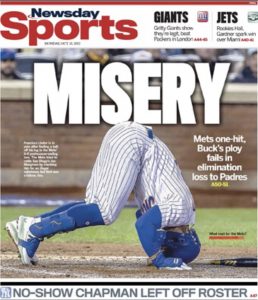 “What? What’s wrong?” “What? What’s wrong?”
“I can’t believe the nerve of you.”
“What do you mean?”
“You can’t forgive me because I have nothing to be sorry about.”
“I wouldn’t go that far.”
“Maybe I should go far right now.”
“Wait. Don’t go. That came out wrong. Can I start over?”
“You better.”
“All right. I…I wanted to let you know, that as I was lining up my seasons and I got to thinking about you, that I’m sorry about the way we ended.”
“Well, neither one of us was happy about that.”
“And the way we were falling apart as we got to the ending.”
“I wouldn’t say ‘falling apart,’ exactly.”
“It could have gone better.”
“Yeah, I guess so.”
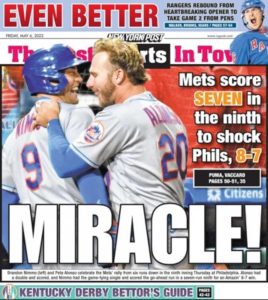 “We really did have some fun times together.” “We really did have some fun times together.”
“So you admit it.”
“Admit it? I never hid it!”
“I don’t know about that. After we ended, all I heard from you is that you weren’t satisfied about what we’d gone through together.”
“That’s a selective reading of our history. I’d expect more from you, given how interested in history you seemed to be back then.”
“You don’t admit you didn’t tell everybody how dissatisfied you were?”
“Only at the end.”
“Only at the end. That’s a pretty big period to put on things.”
“I hope you know you were more than our ending to me. I hope you know I value how we began and how we ensued and how we were most of our time together.”
“Most people only care about the end.”
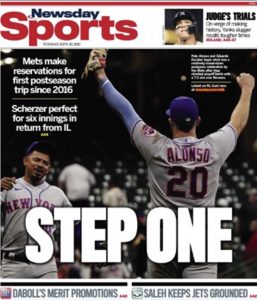 “Well, I’m not most people.” “Well, I’m not most people.”
“No, you aren’t, I suppose.”
“And you weren’t most seasons.”
“I see you haven’t forgotten how to interpret numbers.”
“I can still count to a hundred and one.”
“And how often have you gotten to do that in your life?”
“Not often.”
“I’ll bet.”
“Sounds like somebody wants to have some kind of measuring contest.”
“Who, me?”
“I’m just kidding. You never were the jealous type. I still smile thinking about the time you invited everybody over from all those earlier seasons.”
“What can I say? I like a good anniversary party.”
“You set the stage for it. It wasn’t just the gala, either. We had some really big shindigs I can’t recall any other season being so up for. Though it feels like we should have gone more all-out with the champagne that night in Milwaukee.”
“Now who’s doing the measuring?”
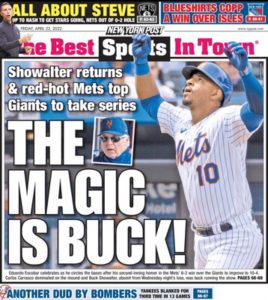 “I also liked the brand-name shopping, and you never skimped. A Cy Young pitcher, an All-Star outfielder…you even got us a manager I’d heard of. Oh, and our closer…” “I also liked the brand-name shopping, and you never skimped. A Cy Young pitcher, an All-Star outfielder…you even got us a manager I’d heard of. Oh, and our closer…”
“I can’t take credit for the closer. The closer was already here.”
“Yeah, but you made the closer something special — I can still hear the trumpets.”
“I’m liking this reading of history. Tell me more about what I did for you.”
“Why not? This is supposed to be a celebration of how much I like you, even now.”
“How much do you like me?”
“Fifteenth most.”
“FIFTEENTH MOST? You drag me back here to tell me I’m No. 15 on your list? That’s your idea of telling me you forgive me?”
“C’mon. It’s fifteenth out of fifty-five.”
“Oh. I guess that’s not so bad.”
“I like you more than 1988. Two whole spots more.”
“So what? Nobody likes 1988.”
“I do. But not as much as I like you.”
“I won more games than 1988, you know.”
“Yeah, but your winning percentage wasn’t quite as high, because 1988 had two rainouts.”
“You remember too much.”
“Yeah, I’ve heard.”
“Are you like this with all your seasons?”
“Only the ones I really like.”
“Thanks. I think.”
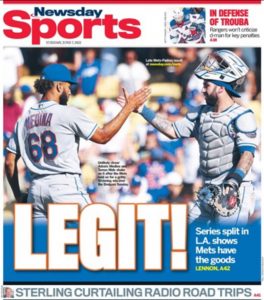 PREVIOUS ‘MY FAVORITE SEASONS’ INSTALLMENTS PREVIOUS ‘MY FAVORITE SEASONS’ INSTALLMENTS
Nos. 55-44: Lousy Seasons, Redeeming Features
Nos. 43-34: Lookin’ for the Lights (That Silver Lining)
Nos. 33-23: In the Middling Years
Nos. 22-21: Affection in Anonymity
No. 20: No Shirt, Sherlock
No. 19: Not So Heavy Next Time
No. 18: Honorably Discharged
No. 17: Taken Down in Paradise City
No. 16: Thin Degree of Separation
by Greg Prince on 5 March 2024 12:42 am Before he became my blogging partner of twenty Springs and counting, Jason used to torture me with a hypothetical. What if I could guarantee the Mets a world championship by not seeing or hearing any of the season that made them world champions? As we batted this devil’s bargain around between pitches, I searched for loopholes. Could I get updates at least? Could someone slip me scores under the door of wherever I was holing up? Would there be a commemorative VHS so I could eventually take in what I’d missed?
I don’t know that we ever defined all the conditions or if I ever fully answered the question, but long before I was asked it, I had tried my best to tolerate the Mets succeeding wildly with me in absentia. A world championship wasn’t involved, and it’s not like I was totally in the dark for six months, yet I knew the situation I’d traversed wasn’t ideal. Had I experienced more of this marvelous season from my usual vantage point of consuming most every pitch of most every game, I believe it would rate a lot higher among MY FAVORITE SEASONS, FROM LEAST FAVORITE TO MOST FAVORITE, 1969-PRESENT. As is, I am quite fond of what I was able to get out of it, and what it portended for the Mets’ future.
***16. 1984
With apologies to Elton John’s lyricist collaborator Bernie Taupin, the words I know, the tune I hum — yet I can’t tell everybody that the 1984 Mets are my song. But, oh, how it feels so real.
With further apologies to Foreigner, I’d been waiting for a year like that to come into my life. Nineteen Eighty-Four was a long time coming. A looooooong time. All I did was get older while the Mets weren’t getting better between the runup to June 15, 1977, and the aftermath of January 20, 1984. The same kid who loved the Mets in eighth grade, even while the Mets were trading Tom Seaver, was still loving the Mets, even while the Mets were losing Tom Seaver anew in something called the compensation pool, even while the description of myself as a “kid” grew less and less apt. Your accumulation of years is a larger percentage of your life when you’re younger, regardless that you haven’t lived that many years, meaning the Mets being terrible for seven years meant they’d been terrible FOREVER. If I hadn’t been permanently blinded by the orange and blue before I hit adolescence, maybe I would have stopped waiting once I had reached early adulthood.
Of course that was never going to happen. I was going to wait as long as it took for the Mets to stop being what they’d been and start being something else. Then the moment I’d been waiting for arrived, and the Mets couldn’t wait for me. Nor should they have. We’d all waited too long for the Mets to emerge from the mire in which they languished for seven seasons. “Go,” I’d tell them had they asked me. “Don’t hold off on what you need to do just because following the spring semester of my junior year of college at the University of South Florida, I won’t be coming directly back to New York like I usually do, and I therefore will be not where I oughta be at that moment when you, once and for all, stop being the dregs of the National League East and start being the kind of team I’ve dreamed about you being since I was in junior high. No, no, you go ahead without me. I’ll catch up.”
They didn’t ask. Just as well.
I doubt I enjoyed the best parts of the 1984 Mets any less than anybody who was privileged enough to be proximate to them as they transpired. I know I enjoyed them differently. The lyrics of that transformational season I do know, and the melody I can hum, even if, deep down, I have to admit what I’m belting out is a karaoke version.
To be clear, newspapers existed where I was, and the news on television included sports reports with videotaped highlights of select baseball games, and once in a while there’d be a national telecast or something on the radio. Mets information was available to the consumer diligent enough to seek it. But it wasn’t the same as being in New York as April turned to May and spring flowed into summer and the laughingstock/afterthought Mets transitioned in a blink to the truly amazing Mets who fought for and took hold of first place.
First place!
Real first place!
Not first-week first place or first-month first place before an inevitable descent to well below first place.
After 1973 and prior to 1984, the Mets’ latest first place record came 30 games into a season (19-11 in 1976). There’d be a few brief feints at upward mobility to tide me over, but mostly a lot of bad, bleeping baseball to overwhelm my optimism. Last place or next-to-last place had been the rule from 1977 forward, save for the second half of the split season of 1981, when I took a little too much delight in the Mets finishing a spirited fourth.
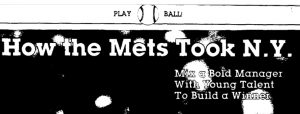 Then 1984 and first place! Or so I read in the papers from a distance. To be fair, I would have missed the promising start to this promising season, regardless of my summer plans. USF’s standard academic year annually included April. I always missed Opening Day. I missed the introduction of George Foster in 1982 and the (temporary) homecoming of Seaver in 1983. I accepted that, just as I accepted missing the final month of every season, because my academic year annually began at the tail end of August. Then 1984 and first place! Or so I read in the papers from a distance. To be fair, I would have missed the promising start to this promising season, regardless of my summer plans. USF’s standard academic year annually included April. I always missed Opening Day. I missed the introduction of George Foster in 1982 and the (temporary) homecoming of Seaver in 1983. I accepted that, just as I accepted missing the final month of every season, because my academic year annually began at the tail end of August.
In between, I’d drive my ass off to get back to New York from Tampa in time for all of May and all of June and all of July and most of August. That’s the majority of a baseball season. I’d settle in for my first game on TV and it was like I was never gone — and the Mets never got better.
Thus, it’s early April in 1984 and I’m straining to spy the Mets from afar, just as in ’82 and ’83, and they lose on Opening Day in Cincinnati, which is a shame, given that winning on Opening Day is usually one of our dependable highlights. Yet the ’84 Mets win their next six, all on the road, and that includes the debut of 19-year-old Dwight Gooden, whose potential I’m clued in on, because he’s from Tampa and he gets covered in the Tampa Tribune, plus I saw him pitch in March in St. Pete. Having Spring Training access while a college student in the Bay Area surely helped make up for the lack of Aprils and Septembers in New York. (Don’t cry for me, Temple Terrace.)
The Mets continue to succeed as they haven’t succeeded in ages, which is to say they don’t fall apart after a good first week or two. Their record never drops below .500, and they are in and out of first place as my summer semester at USF gets underway. One summer semester is a requirement. I wouldn’t have chosen to hang around Tampa as the Florida weather got even hotter. I wouldn’t have chosen to be far from New York as the Mets came into their own.
My absorption of box scores and wire copy has never been more purposeful or intense. Without the dragnet coverage provided by the beat writers in the hometown papers I’ve never missed more, I’m left to piece together what’s going on. “Chapman” is a name I see playing “2b” for the Mets. Huh? Is that Kelvin Chapman? Really? Kelvin Chapman from 1979? He’s still around? He is. He’s platooning with Wally Backman, whose presence at 2b isn’t a shock, as he’s been up and down with the Mets since 1980, but wasn’t Brian Giles the future at second base coming out of last year?
Stuff like that eventually explains itself. The computer-fueled managerial ability of Davey Johnson, who the Mets promoted from Tidewater in October of 1983 while I was immersed enough in my studies and so forth to not process what an epic hire it might be, shines through in the standings and the occasional stories I catch up on. In reflecting on his first season a year after the fact, specifically the lack of expectations surrounding the 1984 Mets before they’d played a single game, Davey told Jack Lang in the Sporting News, “I used to get a kick out of it when I picked up the papers in the Spring and saw where people were picking us for fifth and sixth. I knew a lot of people were going to be surprised because I knew we had a lot better team than they realized. It may have come together a little sooner than I anticipated, but I knew we were going to be a good team.”
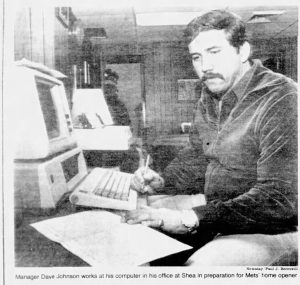 In 1984, Davey knows more than everybody. He’s platooning two minor league infielders at second and getting what he needs. He’s resurrecting Ron Gardenhire at short, who’s usurped the future of Jose Oquendo. He’s trusting in Hubie Brooks at third and moving incumbent center fielder Mookie Wilson down the order, and it’s working. Mike Fitzgerald has stepped up to squat down once hot catching prospect John Gibbons encounters injury. Foster looks alive in left. Darryl Strawberry isn’t homering every time up, as I thought might be possible, but just knowing our budding superstar right fielder might go deep during any at-bat is a boost. Keith Hernandez at first base is all we hoped he’d be when he came over from St. Louis. In 1984, Davey knows more than everybody. He’s platooning two minor league infielders at second and getting what he needs. He’s resurrecting Ron Gardenhire at short, who’s usurped the future of Jose Oquendo. He’s trusting in Hubie Brooks at third and moving incumbent center fielder Mookie Wilson down the order, and it’s working. Mike Fitzgerald has stepped up to squat down once hot catching prospect John Gibbons encounters injury. Foster looks alive in left. Darryl Strawberry isn’t homering every time up, as I thought might be possible, but just knowing our budding superstar right fielder might go deep during any at-bat is a boost. Keith Hernandez at first base is all we hoped he’d be when he came over from St. Louis.
And how about that pitching? Gooden. Ron Darling, who debuted last September when I wasn’t suffering nearly as much Mets separation anxiety. Walt Terrell, part of the same trade that brought Darling from Texas for former Flushing heartthrob Lee Mazzilli. Mazzilli’s on the Pirates now. There’s a game in Pittsburgh, on June 6, when Gooden — they call him Doctor K and hang K’s for his strikeouts at Shea, I learn — flirts with the first no-hitter in Mets history. He doesn’t get it, and the Mets give up their 1-0 lead in the eighth, yet “Doc” is still on the mound in the ninth, trying to hold a 1-1 tie in place. The Mets have good relievers like Jesse Orosco and Doug Sisk, but Davey trusts Dwight the way managers have always trusted aces.
Mazzilli, who wore 16 for the Mets before Gooden did, walks to lead off the bottom of the ninth and then steals second. A ground ball moves him to third. An intentional walk is ordered to Bill Madlock. Johnson tells his rookie pitcher to take on the main Buc slugger Jason Thompson. Unfortunately, Thompson drives a ball to Wilson in center. Mookie still doesn’t have much of an arm. Mazzilli still has enough legs. Lee beats the throw. Fireworks go off above Three Rivers Stadium. Pirates win, 2-1.
Except Davey Johnson is clever enough to put on an appeal play and short-circuit the celebration. Fitzgerald throws to Brooks at third. Doug Harvey calls Mazzilli out in an 8-2-5 double play. Lee left the bag too soon (similar to his timing in departing Queens before he could be part of a contending Mets team). Coach Frank Howard says later, “Anyone with eyes in his rear end could have seen it.”
No part of me saw this incredible reprieve from the governor. I had to read about it in the Tribune. I had to read, too, that the Mets and Pirates played on until the thirteenth, when Backman sparked the go-ahead rally and Tom Gorman — another fringe Met off my outdated radar — saved the 2-1 victory. I was extremely happy to have the win and the momentum, but I wished I could have embellished it by walking around after learning of it and bumping into people who also knew about it and cared about it. That just wasn’t how it was going to be when you lived somewhere else when the Mets were riding high.
The important thing was the riding high, I told myself.
On June 21, the Mets and Phillies played one of the craziest games I never saw or heard in all my years as a Mets fan. It’s probably more of a legend in my mind because a) I didn’t see or hear it; b) I was determined to run up my Sports Phone bill to stay abreast of it the weekday afternoon at Shea while it was in progress; and c) I was on one of those multiple all-nighter jags I would get on during college when assignments and tests and work all collided to make sleep a luxury. The 1984 Mets were Vivarin for my soul.
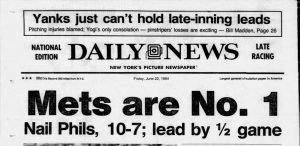 The upshot of June 21 was the Mets had a 6-1 lead; fell behind, 7-6; and stormed back to win, 10-7. I don’t know if “stormed back” was ever more appropriate. The Mets had stormed back from the depths of the NL East in 1984 and now they were beating the team that had been the embodiment of subjugation. The Phillies were at the end of their line as a formidable foe, but they’d won the pennant the year before and so many division titles since 1976. There was a passing of the torch going on here, I decided. The Phillies, by losing, fell out of first place. The Mets, by winning, took over first place. Not with a joke record, either, like when the Mets earned a first-place headline from the Post in 1979 for winning on Opening Day. The Mets were 36-27. Fewer than 100 games remained to the 1984 season and the Mets were in first place. You could calculate a magic number if so inclined. The fans at Shea, I read in the thin but essential National Edition of the Daily News, chanted WE’RE NO. 1! as they might have when Rusty Staub and Ron Hodges were contributing to miracles for the 1973 Mets. As it happened, Staub and Hodges delivered key RBIs to topple Philadelphia in 1984. It was all so perfect. The upshot of June 21 was the Mets had a 6-1 lead; fell behind, 7-6; and stormed back to win, 10-7. I don’t know if “stormed back” was ever more appropriate. The Mets had stormed back from the depths of the NL East in 1984 and now they were beating the team that had been the embodiment of subjugation. The Phillies were at the end of their line as a formidable foe, but they’d won the pennant the year before and so many division titles since 1976. There was a passing of the torch going on here, I decided. The Phillies, by losing, fell out of first place. The Mets, by winning, took over first place. Not with a joke record, either, like when the Mets earned a first-place headline from the Post in 1979 for winning on Opening Day. The Mets were 36-27. Fewer than 100 games remained to the 1984 season and the Mets were in first place. You could calculate a magic number if so inclined. The fans at Shea, I read in the thin but essential National Edition of the Daily News, chanted WE’RE NO. 1! as they might have when Rusty Staub and Ron Hodges were contributing to miracles for the 1973 Mets. As it happened, Staub and Hodges delivered key RBIs to topple Philadelphia in 1984. It was all so perfect.
Except for me not being anywhere near it.
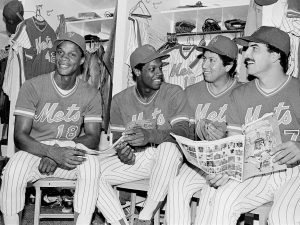 My summer semester ended as the All-Star break was concluding. The Mets were the first-place Mets as baseball’s best gathered at Candlestick Park, sending their largest contingent of players to date to the Midsummer Classic. Hernandez on the bench. Orosco in the pen. Strawberry in the starting lineup (his Rookie of the Year award from the year before and unforgettable name might have boosted his vote total). And Gooden. Gooden was 19 and pitching in the All-Star Game, striking out every American Leaguer he faced in the fifth inning and giving up no runs in the sixth, either. I watched from a booth in an off-campus pub, ostensibly enjoying a post-finals night out with a couple of friends whose attention I kept directing at the TV over the bar. I Metsplained to them who Dwight Gooden was and why what he was doing was so stupendous. They nodded politely before steering the conversation back to another topic. My summer semester ended as the All-Star break was concluding. The Mets were the first-place Mets as baseball’s best gathered at Candlestick Park, sending their largest contingent of players to date to the Midsummer Classic. Hernandez on the bench. Orosco in the pen. Strawberry in the starting lineup (his Rookie of the Year award from the year before and unforgettable name might have boosted his vote total). And Gooden. Gooden was 19 and pitching in the All-Star Game, striking out every American Leaguer he faced in the fifth inning and giving up no runs in the sixth, either. I watched from a booth in an off-campus pub, ostensibly enjoying a post-finals night out with a couple of friends whose attention I kept directing at the TV over the bar. I Metsplained to them who Dwight Gooden was and why what he was doing was so stupendous. They nodded politely before steering the conversation back to another topic.
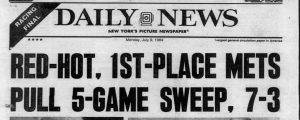 There was another topic? What was more worth talking about than what the Mets were doing? The Mets had finished out the first half of 1984 by sweeping a five-game series from the Reds at Shea and tossing their caps to the fans in the box seats upon completion of their rampage. I practically panted as I stared at the agate type and gleaned assorted details in the Trib, my eyes lighting up the same as they did in a muffler shop waiting room where I picked up a recent issue of Sports Illustrated and found a feature story on the Mets as a revelation and Gooden as a Metropolitan phenomenon. “He’s a happening in New York,” the article said, and I wondered how he and they could be happening without me. There was another topic? What was more worth talking about than what the Mets were doing? The Mets had finished out the first half of 1984 by sweeping a five-game series from the Reds at Shea and tossing their caps to the fans in the box seats upon completion of their rampage. I practically panted as I stared at the agate type and gleaned assorted details in the Trib, my eyes lighting up the same as they did in a muffler shop waiting room where I picked up a recent issue of Sports Illustrated and found a feature story on the Mets as a revelation and Gooden as a Metropolitan phenomenon. “He’s a happening in New York,” the article said, and I wondered how he and they could be happening without me.
Finally, on the evening of July 14, I pulled into the driveway of my family’s house on Long Island after a two-day drive, raced inside, greeted my parents, and turned the TV to Channel 9. The Mets were playing the Braves in Atlanta. Mets announcers were telling me all about it. Mets reporters would expand on it in the morning. The Mets won, 7-0, and increased their lead over their new rivals, the Cubs, to a game-and-a-half. Everything was, at last, as it should be.
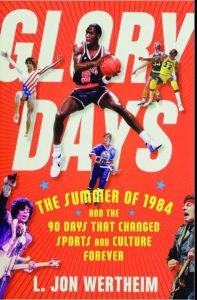 It stayed that way for a couple of weeks. The Mets came home a few days after I did and I got to see them in person. Just showed up at the ballpark with my friends and lined up for tickets for the game that night. The line was way longer than it had been in previous summers, but we got in. The seats were way the hell up in the Upper Deck, but it was a pleasant change from sitting anywhere you wanted to watch a lousy team nobody wanted to see. The guy who ran Mets ticket sales confirmed the obvious for Lang: “It’s great to have a big advance sale, but you know you’re going good when people decide the day of the game they want to see the Mets play.” The first-place Mets engaged in another back-and-forth battle, this time with the Cardinals. We beat them in ten, 9-8, Hernandez sticking it to Neil Allen for the game-winning RBI, symbolism that nobody had to explain to the throng of 36,749. This wasn’t Tampa. We — we — chanted WE’RE NO. 1! like they did in June. I really was home. It stayed that way for a couple of weeks. The Mets came home a few days after I did and I got to see them in person. Just showed up at the ballpark with my friends and lined up for tickets for the game that night. The line was way longer than it had been in previous summers, but we got in. The seats were way the hell up in the Upper Deck, but it was a pleasant change from sitting anywhere you wanted to watch a lousy team nobody wanted to see. The guy who ran Mets ticket sales confirmed the obvious for Lang: “It’s great to have a big advance sale, but you know you’re going good when people decide the day of the game they want to see the Mets play.” The first-place Mets engaged in another back-and-forth battle, this time with the Cardinals. We beat them in ten, 9-8, Hernandez sticking it to Neil Allen for the game-winning RBI, symbolism that nobody had to explain to the throng of 36,749. This wasn’t Tampa. We — we — chanted WE’RE NO. 1! like they did in June. I really was home.
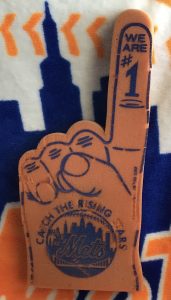 Perfection fizzled in the days ahead. The Cubs took three of four in the ensuing series at Shea, then swept four from us at Wrigley to seal off first place once and for all, taking a bit of the edge off my excitement. So now I’m here and you start losing? You DO know I was looking forward to you and me spending quality time together in first place, don’t you? Yet the memory of 1984 never goes breaking my heart, We were en route to 90 wins and a solid second-place finish, and Gooden — did I mention he was 19? — was exploring a universe of his own, really racking up the strikeout numbers as the schedule wound down. Nevertheless, it became evident to me that I had missed the best part of the season by fulfilling my academic requirement. The five weeks I was around, the Rising Stars the contemporary ad slogan urged us to Catch were in something of a holding pattern, and the Mets mostly seemed to be on the road. Their victory tour didn’t go any better than the Jacksons’. I rushed back to Shea to catch three of the last four games I could in mid-August, versus the Pirates. We lost two of them. The one win was a Gooden win. (Don’t cry for me, Massapequa.) I thoroughly annoyed whoever sat behind me with my standing and clapping with two strikes so I could properly acknowledge those K’s going up in that Korner that was all the rage. Like the foam finger I bought and the wave I considered charming enough to participate in the first time it washed over my section, I wanted to reach out and touch every totem of the 1984 Mets. Perfection fizzled in the days ahead. The Cubs took three of four in the ensuing series at Shea, then swept four from us at Wrigley to seal off first place once and for all, taking a bit of the edge off my excitement. So now I’m here and you start losing? You DO know I was looking forward to you and me spending quality time together in first place, don’t you? Yet the memory of 1984 never goes breaking my heart, We were en route to 90 wins and a solid second-place finish, and Gooden — did I mention he was 19? — was exploring a universe of his own, really racking up the strikeout numbers as the schedule wound down. Nevertheless, it became evident to me that I had missed the best part of the season by fulfilling my academic requirement. The five weeks I was around, the Rising Stars the contemporary ad slogan urged us to Catch were in something of a holding pattern, and the Mets mostly seemed to be on the road. Their victory tour didn’t go any better than the Jacksons’. I rushed back to Shea to catch three of the last four games I could in mid-August, versus the Pirates. We lost two of them. The one win was a Gooden win. (Don’t cry for me, Massapequa.) I thoroughly annoyed whoever sat behind me with my standing and clapping with two strikes so I could properly acknowledge those K’s going up in that Korner that was all the rage. Like the foam finger I bought and the wave I considered charming enough to participate in the first time it washed over my section, I wanted to reach out and touch every totem of the 1984 Mets.
I noticed during my month-plus in New York a few other things were changing without telling me. Little things. A new shopping center opened in the center of Long Beach, cosmetically improving the immediate neighborhood; the Waldbaum’s from two blocks east moved in. My neighbor was sunbathing to a radio station I hadn’t heard before, Lite-FM; 106.7 on the dial had switched formats over the winter. When I used a pay phone, it suddenly cost more than a dime to make a call. I understood Queens was getting a new area code — 718, something to remember for those thinking about connecting to 507-TIXX. For better or worse, the kind of change you might not pick up on if you’re around all the time was in the air. I was glad the Mets were a part of it for the better.
My senior year at USF beckoned at the end of August. I kept tabs on the Mets as best I could, deluding myself for as long as the math would allow that the Cubs would blow it and we’d pass them, because they blew it and we passed them in 1969…but 1984 wasn’t quite 1969. As an arc, however, it was the closest thing we’d had to it in fifteen years, and if you don’t think that’s Amazin’, then you weren’t exposed to at least some of it. It was the year that so needed to happen, the year that couldn’t wait one more inning for its most ardent fan to pull up a chair and soak it all in. Geography was more of an obstacle to Metsian immersion than it would be once developing technology collapsed barriers. Change was coming where that was concerned, but not with lightning speed. My college curriculum included a computer class that involved punch cards. Try to log into an out-of-town broadcast with those.
After the 1984 season was over, I had to put up with being in a place my team wasn’t for just a little longer. The Mets and I would get together for good soon enough. Something splendid had begun, and once I graduated, in April of 1985, I’d make damn sure that I’d be on its scene.
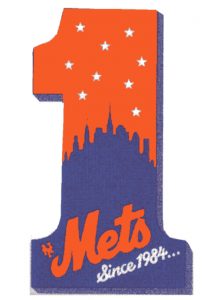 The splendidness has waxed and waned since. I’ve never left. The splendidness has waxed and waned since. I’ve never left.
PREVIOUS ‘MY FAVORITE SEASONS’ INSTALLMENTS
Nos. 55-44: Lousy Seasons, Redeeming Features
Nos. 43-34: Lookin’ for the Lights (That Silver Lining)
Nos. 33-23: In the Middling Years
Nos. 22-21: Affection in Anonymity
No. 20: No Shirt, Sherlock
No. 19: Not So Heavy Next Time
No. 18: Honorably Discharged
No. 17: Taken Down in Paradise City
by Greg Prince on 29 February 2024 2:18 pm We have reached a stop on the MY FAVORITE SEASONS, FROM LEAST FAVORITE TO MOST FAVORITE, 1969-PRESENT journey that can’t be appreciated fully if you forget to pack nuance. This season wouldn’t rate as highly as it does with me if there wasn’t more to it than its unfortunate ending. It would likely rate a lot higher if the ending didn’t still feel so unfortunate.
***17. 1988
Howie Rose welcomed a guest to his nightly talk show in the fall of 1988, a reporter from Sport magazine who explained he was working on a story about the state of the New York sports scene, part of a larger series of citycentric profiles the publication was planning. Howie, being the gracious host he was, let the writer borrow his platform for a couple of segments to interact with callers who would deposit their two cents of perspective in his notebook. In retrospect, the idea that a sportswriter would reach out to sports fans for what they thought about sports seemed novel. Pre-Internet, we were usually just the rabble, referred to as a veritable blob when referred to at all: “The fans seem to think…” Kudos to article author Rufus Sears for taking the extra step.
After listening to WFAN that night, I kept on the lookout at a newsstand near me in the months ahead for the issue of Sport that would include the New York story. Its cover date was February 1989. Its cover subject was Cindy Crawford, fronting Sport’s HOT SWIMSUIT ISSUE (wonder where they got that idea). I don’t know how many readers rushed past the supermodel’s picture for the table of contents and laid down their $2.50 only when they ascertained what else was inside, but one of them was me.
Pardon my moistened flipping finger, Ms. Crawford, but I need to get to why I purchased this magazine.
On page 42, the reader is informed New York sports are “the biggest and baddest” and that they “burn with passion”. In our boroughs, we are told, “the chances are surprisingly good that the woman heading down the avenue in navy-blue business suit and Nikes has a strong opinion on whether Mookie Wilson or Lenny Dykstra ought really to be starting for the Mets. It’s that kind of town. You take sports seriously, or you don’t ever completely fit in.” Municipally flattering enough, I suppose, and it’s nice to know Sport was focusing a little on a lady who didn’t have to wear a two-piece to be part of its editorial planning.
 Why, yes, I did buy the swimsuit issue for the articles. Thirty-five years later, as I turned my Favorite Seasons focus to remembering 1988, I’d completely forgotten Cindy’s bikini turn, but I recalled a passage in Sears’s “Sport City Tours” piece so vividly that I had to purposefully trawl eBay for the first time in ages and search out the issue anew — so many subscription cards and cigarette ads! — to confirm I wasn’t imagining it. There it was, on page 46, where Sears, who self-identifies at the outset of the feature as “a New York fan,” shares his impression of what the New York Mets are all about in the aftermath of 1988: Why, yes, I did buy the swimsuit issue for the articles. Thirty-five years later, as I turned my Favorite Seasons focus to remembering 1988, I’d completely forgotten Cindy’s bikini turn, but I recalled a passage in Sears’s “Sport City Tours” piece so vividly that I had to purposefully trawl eBay for the first time in ages and search out the issue anew — so many subscription cards and cigarette ads! — to confirm I wasn’t imagining it. There it was, on page 46, where Sears, who self-identifies at the outset of the feature as “a New York fan,” shares his impression of what the New York Mets are all about in the aftermath of 1988:
The Mets drew even more than the Yankees, a record three million plus, despite the fact that yupsters and Janey-come-latelies seemed to lose interest last season. The team’s sweaty, dusty hubris had somehow lost its chat appeal at the water cooler. People grew tired of the whining from the manic “tablesetters,” Dykstra and Wally Backman; though solemn and productive Kevin McReynolds was increasingly mentioned as a role model. The team was subtly handed back to its Queens constituency, the muscled street kids and their bespectacled middle-class counterparts. in a comforting way, the Metsies are reverting back to primary ownership by the Queens fans who have supported them since long before any miracles, fans who’ll be there in the cold and the rain, no matter what. The Manhattan-forged hipness and “heat” has quietly dissipated, and they’re once against part of the streets where generations of bottlecaps are melted into the asphalt and the prototypical fan is a portly old presser of suits taking his ease on a sidewalk milk crate on a hot August afternoon while the game crackles over WFAN.
I read this summation in early 1989, and couldn’t connect it to the reality I knew and sensed about the Mets at the end of 1988 (and that’s with my relatively svelte, Yankees fan grandfather having been an actual rather than abstract dry cleaner in Jackson Heights; he was long gone by then, but Prince Valet was still open and pressing suits on 82nd Street). I reread this summation in early 2024, and I still can’t. It didn’t embody the Mets zeitgeist I had lived through, which may be why some of the rhetorical flourishes — “muscled street kids” and “subtly handed back to its Queens constituency” stood out — have lived under my skin for three-and-a-half decades. Perhaps the author, under deadline pressure, simply thought it all sounded good and decided all of it was true.
To me, the Mets of 1988 were, if anything, verging on too big, too popular, too much of an ongoing event. They were almost too good for their own good, or our own good. Maybe 1988 was the original manifestation of the dreaded 21st-century lament, “This is why we can’t have nice things.” We had the nicest thing there was in baseball. It proved too nice to last.
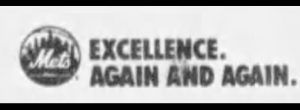 “This must be just like living in paradise,” David Lee Roth wailed in the leadup to the 1988 season. Who knew he was a Mets fan? Then again, it seemed like almost everybody was in those hard-earned days. We’d persevered through the barren late ’70s and the false-start early ’80s. We’d spent seven years at the bottom of the National League East and alone at Shea Stadium. Now we were where the party was. Nineteen Eighty-Eight was the future we as Mets fans dreamed of living in before such a Metscape seemed possible. We went from having basically nothing to owning essentially everything. This was not our younger selves’ franchise. “This must be just like living in paradise,” David Lee Roth wailed in the leadup to the 1988 season. Who knew he was a Mets fan? Then again, it seemed like almost everybody was in those hard-earned days. We’d persevered through the barren late ’70s and the false-start early ’80s. We’d spent seven years at the bottom of the National League East and alone at Shea Stadium. Now we were where the party was. Nineteen Eighty-Eight was the future we as Mets fans dreamed of living in before such a Metscape seemed possible. We went from having basically nothing to owning essentially everything. This was not our younger selves’ franchise.
In no particular order, we had…
SUCCESS: Ninety or more wins every year as a rule for five consecutive years; only two other National League teams had as many as two such years between 1984 and 1988, and nobody else in the NL could claim as much as a winning record every season in that span. Plus, there was a world championship in the middle of all that, assuring that for eternity nobody could say about those spectacular Mets teams that they never won the big one. You could hardly blame the Mets for playing up their arc as “Excellence. Again and Again.” They were telling it like it was.
CONTINUITY: The promising likes of Randy Myers, Dave Magadan, David Cone and Gregg Jefferies — truly promising, not simply “future stars” fodder for a back page of the official yearbook — all had to wait for their big break. Myers emerged as the primary closer despite the presence of two proven World Series firemen on the roster. Magadan had to sit behind a perennial Gold Glover and revered clutch captain at one position and a 30-30 man at another. Cone was depth for an already deep rotation. And Jefferies was merely the shiniest object in anybody’s farm system. Through the draft and through trades, the Mets were replenishing while winning, having “created a minor league farm system that is now producing more talent than they know what to do with,” per a glowing Manhattan, Inc. profile that ran shortly after Sport’s New York analysis.
ESTEEM: The Mets’ “build-from-the-bottom organization” was termed “the model that other teams,” the Twins and Rangers among them, “say they emulate,” per Manhattan, Inc., which hailed the Mets as a blueprint to follow for both baseball and business.
ALLURE: The Dodgers were traditionally the only team that could be relied on to draw more than three million fans, thanks in great part to beautiful weather. It rarely rained in Southern California. Queens could make no such claim, but it had a team almost impervious to climate conditions. In 1987 and 1988, the Mets became the first non-L.A. franchise to register paid attendance over three million in back-to-back years — and this was when only people through the turnstiles rather than total tickets sold were counted. This was also when occasional doubleheaders were still scheduled as a matter of course; rainouts occasionally had to be rescheduled within single-admission doubleheaders; and there weren’t promotional come-ons practically every weekend to goose the gate. Nationally, the Mets aired over NBC and ABC as much as the networks could put them on, and locally, they were literally the talk of the town. Their presence on 1050 AM was the foundation for all-sports radio, and no athletic enterprise drew more calls to WFAN than the New York Mets.
NEAR FLAWLESSNESS: To be fair, I generally lacked confidence in our various lefty specialists after Carlos Diaz was traded with Bob Bailor to land Sid Fernandez, though Bob McClure seemed like a pretty sharp pickup coming out of the break in ’88. I’ll also cop to a lingering wistfulness for Bailor’s versatility. Otherwise, what were we missing? We had glittering superstars, unquestionable frontline ability, superb backups adeptly deployed, starters and relievers to count on, a regenerative talent pipeline, in Davey Johnson a manager who rarely took lose for an answer and, per Manhattan, Inc. once more, “the best-run organization in baseball”. Ownership facilitated Frank Cashen, Joe McIlvaine and Al Harazin and didn’t make a public-facing jerk out of itself. The stadium was freshened up with those eye-catching neon figures along the exterior. If you weren’t one of the three million-plus rushing to Flushing, Tim McCarver continued to bring out the best in Ralph Kiner on TV, and by the end of 1988, WFAN’s signal, beaming Bob Murphy and Gary Thorne during games that were bracketed by Howie Rose’s must-listen Mets Extra before and after, now emanated from 660 AM, was stronger than ever.
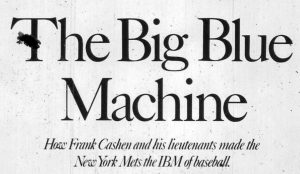 If this wasn’t paradise, then it was close enough for the earthbound Mets fan to mistake it for such. Then again, things could have been a little more heavenly in our version of nirvana. Just one world championship despite all those regular-season wins? Just two division titles? Only one Cy Young winner, and he had to miss time the year after to enroll in drug rehab? No MVPs despite some outstanding individual seasons? The flawlike down notes were a function of day-to-day baseball. Your team, no matter how good, never goes 162-0. The 1988 Mets couldn’t even put 162 games in the books, getting rained out twice without convenient makeup dates. Of the 160 they played, they required every last one of them in order to reach triple-digits in wins. The nerve! If this wasn’t paradise, then it was close enough for the earthbound Mets fan to mistake it for such. Then again, things could have been a little more heavenly in our version of nirvana. Just one world championship despite all those regular-season wins? Just two division titles? Only one Cy Young winner, and he had to miss time the year after to enroll in drug rehab? No MVPs despite some outstanding individual seasons? The flawlike down notes were a function of day-to-day baseball. Your team, no matter how good, never goes 162-0. The 1988 Mets couldn’t even put 162 games in the books, getting rained out twice without convenient makeup dates. Of the 160 they played, they required every last one of them in order to reach triple-digits in wins. The nerve!
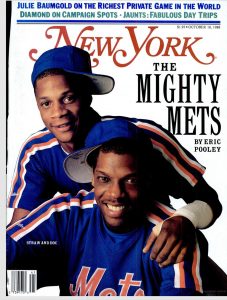 Seriously, the 1988 Mets took over first place in early May and never surrendered it, but they dared to not altogether put away their primary competition — the young and relentless Pittsburgh Pirates of Barry Bonds and Bobby Bonilla — until late August. The Mets thwarted the Pirates in every head-to-head showdown through the summer, but the Bucs remained close enough in the standings to make the Mets sweat. We’d convinced ourselves the Mets were made of Right Guard and were therefore never supposed to perspire. A 30-11 start to the season indicated the rest of the year would be a breeze. But the Mets didn’t always hit as well as they pitched, and if Darryl Strawberry wasn’t blasting one of his 39 homers, or if one of the pitchers had an off night, the 24-man roster had a tendency to be human. Age was also catching up with good old (emphasis on the latter) Gary Carter, whose three-month wait for his 300th homer made him seem like less than a stickler for promptness, and Keith Hernandez, whose hamstring betrayed him and sent him to the DL. A few wins, a few losses, rinse and repeat. For about three months, the mighty, mighty Mets played at a .500 clip. Their leadership didn’t like what it was seeing. Seriously, the 1988 Mets took over first place in early May and never surrendered it, but they dared to not altogether put away their primary competition — the young and relentless Pittsburgh Pirates of Barry Bonds and Bobby Bonilla — until late August. The Mets thwarted the Pirates in every head-to-head showdown through the summer, but the Bucs remained close enough in the standings to make the Mets sweat. We’d convinced ourselves the Mets were made of Right Guard and were therefore never supposed to perspire. A 30-11 start to the season indicated the rest of the year would be a breeze. But the Mets didn’t always hit as well as they pitched, and if Darryl Strawberry wasn’t blasting one of his 39 homers, or if one of the pitchers had an off night, the 24-man roster had a tendency to be human. Age was also catching up with good old (emphasis on the latter) Gary Carter, whose three-month wait for his 300th homer made him seem like less than a stickler for promptness, and Keith Hernandez, whose hamstring betrayed him and sent him to the DL. A few wins, a few losses, rinse and repeat. For about three months, the mighty, mighty Mets played at a .500 clip. Their leadership didn’t like what it was seeing.
Cashen: “In all my years in baseball, I’ve never seen a club with this much talent play so poorly for so long.”
Hernandez: “This team plays like a bunch of Little Leaguers.”
Whether you tuned into the games, read the papers or listened (too much) to the FAN, you knew the Metsopotamian natives were restless, too. The Mets were less cheered for their stranglehold on the top of the division than questioned for not pulling away from the pack. On August 14, the Mets swept the Expos, who’d briefly nosed ahead of the Pirates for second place, in a Banner Day doubleheader at Shea (the last time the Mets ever scheduled a twinbill in advance rather than out of contingency). Montreal was now 6½ games back. Pittsburgh sat five out. “Maybe,” an unidentified Met told Bob Klapisch in the News, “that’ll keep the animals off our backs for a while.”
 A little harsh, but that’s living in paradise in real time, when the players, according to ace observer Klapisch, were “weary, plain and simple” of the expectations and critique surrounding them. Howard Johnson told Bob, “Imagine we’re apologizing for being five games up.” Klap’s colleague Phil Pepe, who’d been around baseball clubhouses for a long time, chimed in, “What the Mets have been this season is an enigma, a puzzlement to those who follow them closely. […] They were stamped with the mark of greatness after the first month of the season, an aura they have not been able to maintain with any consistency.” A little harsh, but that’s living in paradise in real time, when the players, according to ace observer Klapisch, were “weary, plain and simple” of the expectations and critique surrounding them. Howard Johnson told Bob, “Imagine we’re apologizing for being five games up.” Klap’s colleague Phil Pepe, who’d been around baseball clubhouses for a long time, chimed in, “What the Mets have been this season is an enigma, a puzzlement to those who follow them closely. […] They were stamped with the mark of greatness after the first month of the season, an aura they have not been able to maintain with any consistency.”
Again, five games up.
 Whatever expectations were going unmet, the fans were still coming out to meet the Mets — a lot. Banner Day represented the eleventh sellout at Shea in the Mets’ previous twelve dates. Season ticket package sales had been so robust the Mets had to limit them so they’d have enough seats to fill the postseason orders most everybody was anticipating. Getting a ticket for most any game at the height of the Mets’ attractiveness was tough enough. Getting what was considered a good one was nearly impossible unless you’d bought one of those packages or wrote away during the winter as soon as individual ducats went on sale. The crowds, as might be expected in New York when demand is high, skewed more corporate than ever. Even Harazin, who you’d figure would be happy to take the money from whatever entity was willing to pay it, admitted to Manhattan, Inc., “It’s harder for Joe Fan, for his family, to come out and buy a ticket for a ballgame. I don’t know what to do about that.” Whatever expectations were going unmet, the fans were still coming out to meet the Mets — a lot. Banner Day represented the eleventh sellout at Shea in the Mets’ previous twelve dates. Season ticket package sales had been so robust the Mets had to limit them so they’d have enough seats to fill the postseason orders most everybody was anticipating. Getting a ticket for most any game at the height of the Mets’ attractiveness was tough enough. Getting what was considered a good one was nearly impossible unless you’d bought one of those packages or wrote away during the winter as soon as individual ducats went on sale. The crowds, as might be expected in New York when demand is high, skewed more corporate than ever. Even Harazin, who you’d figure would be happy to take the money from whatever entity was willing to pay it, admitted to Manhattan, Inc., “It’s harder for Joe Fan, for his family, to come out and buy a ticket for a ballgame. I don’t know what to do about that.”
I was an infinitesimal fraction of the Mets’ paid attendance in 1988. I wasn’t connected to any corporation, I didn’t mail in any checks before the season started, I wasn’t brimming with disposable income. I just wanted to go to a game now and then. On a Saturday night in early July, I went alone. I hadn’t been to a game yet all year, so I invested in two of the less expensive tickets at the advance window on spec when I found myself driving by Shea a few days earlier. Couldn’t convince anybody to join me at the last minute. There went a ticket that didn’t count as paying and attending; oh well. I drove to the general vicinity of the stadium on my own, got stuck in traffic on the Cross Island while Belmont was letting out, wound up having to park far away as well as sit far away. Unnecessary second seat notwithstanding, I judged the outing worthwhile. Doc pitched a complete game. Darryl and Hojo homered. The Mets won with ease. Long before I came to embrace the pleasures of a solitary outing, I felt kind of lonely among 44,715 presumably sated patrons, but the baseball aspect of it was definitely rewarding, no matter how small the star players looked from the Upper Deck in left field. As I walked and walked and walked some more back to my car somewhere in Corona, I knew I had just watched my team rise to 51-29 after their first eighty games, a pace they almost replicated in their next eighty games en route to finishing 100-60, a full fifteen up on the second-place Pirates. What had everybody been complaining about?
About a week after quieting “the animals,” the Mets roared to life in a manner that nobody could question. In Los Angeles, with Bud Harrelson filling in as manager when Davey Johnson needed to leave the team to tend to his ailing mother, the team’s senior man, Mookie Wilson, was entrusted anew with the full-time center field job. Platoon partner Lenny Dykstra sat and Mookie hit: 6-for-15 in a three-game sweep of the Dodgers, setting the stage for one of the great combined individual and team stretch runs in franchise history. Mookie batted .376 in his final 31 games, as the Mets, on a 29-8 tear, buried the Buccos. One of the team’s least experienced hands played an outsize role in the leveling up as well. Infielder Gregg Jefferies, who sipped a cup of coffee in 1987 after twice being named Baseball America’s Minor League Player of the Year, was recalled for good in late August and lit up National League pitching for the next several weeks. Throw in David Cone’s march to twenty wins, and it seemed there was nothing this team didn’t have or couldn’t do.
Their lead kept growing, their talent kept showing, and the vibe surrounding them turned inevitable. They’d face a much lesser team in the playoffs, the 94-67 Dodgers, from whom they’d already taken ten of eleven, and the looming Mets-A’s World Series resonated with classic overtones. Those of us in the stands for the final regular-season home game (I lucked into Field Level seats for my second and last Shea appearance of the year) figured we were stating a fait accompli as we chanted, BEAT L.A.!
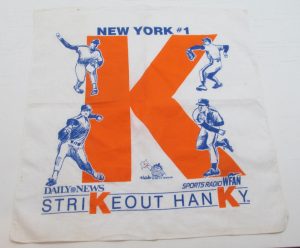 It was a delight being embedded within the 42,099-person choir offering an amen to our conquering heroes, but I think I had my real celebration slightly in advance of the September 22 division-clinching versus the Phillies. I was standing on the porch of my family’s house, looking to the sky as sunset neared. I must have heard something on the news about the autumnal equinox and decided the stars were aligning in our favor. Fall was coming. For the fourth time in the history of this planet, the New York Mets, my New York Mets, were about to be crowned champions of the National League East, the only designation that got a team somewhere at the end of the regular season back when there were only four divisions. It was a delight being embedded within the 42,099-person choir offering an amen to our conquering heroes, but I think I had my real celebration slightly in advance of the September 22 division-clinching versus the Phillies. I was standing on the porch of my family’s house, looking to the sky as sunset neared. I must have heard something on the news about the autumnal equinox and decided the stars were aligning in our favor. Fall was coming. For the fourth time in the history of this planet, the New York Mets, my New York Mets, were about to be crowned champions of the National League East, the only designation that got a team somewhere at the end of the regular season back when there were only four divisions.
My first undeniable specific memory of the Mets, my Mets, doing something was becoming NL East champions the first time, in 1969. This, now, was my twentieth season as their fan. We won 100 games my first year, topped off by the World Series. We were nearing 100 wins again. It had been a pretty lousy non-Mets year for me personally. I’d reached a professional crossroads I didn’t know how to traverse, my mother was having serious health problems, I was more than a thousand miles away from my college-going girlfriend. At 25 years old, I was letting circumstances too often overtake me. On the baseball side of life, the realm where I sought solace, I was as guilty as any Mets fan of turning my expectations into assumptions. Of course the Mets were supposed to win a division. Of course I believed they should be closer to closing in on 160-0 than 100-60. Yet alone on the porch, alone with my thoughts, as alone as I’d been at that game in July, I looked to the sky and pictured my team pulling together. They were about to gain one of those little asterisks next to their name in the standings. They were going to be champions of something essential, and they’d be poised over the next few weeks to be champions of everything, returning to the apogee they’d attained in 1986 and compensating for what felt like the cosmic mistake of 1987. We should have been striding toward our third consecutive world championship. I was willing to settle for two out of three.
I hadn’t had that much to feel good about in 1988. The Mets shaking off whatever held them back before Mookie and Jefferies and Coney led their charge to the forthcoming champagne shower(s) filled me up. This first clinching would merely begin to make it official.
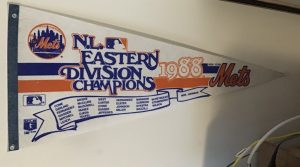 In New York magazine on the eve of the NLCS, Keith Hernandez issued a warning: “If we don’t win the playoffs, it all goes down the fucking toilet.” Thirty-five years later, to Mike Vaccaro in the Post, Keith reflected, “Even when things were rolling, you could feeling something was just…off. Just a little bit off.” In New York magazine on the eve of the NLCS, Keith Hernandez issued a warning: “If we don’t win the playoffs, it all goes down the fucking toilet.” Thirty-five years later, to Mike Vaccaro in the Post, Keith reflected, “Even when things were rolling, you could feeling something was just…off. Just a little bit off.”
A little bit was all it took to lose the pennant to Los Angeles, four games to three. Few any longer seem to remember the three wins, though they were rousing and reassuring in their time, a reminder that whenever you doubted the 1988 Mets, they were capable of demolishing your skepticism. They chased Orel Hershiser, he of the record-setting shutout string, in the ninth inning of Game One, Gary Carter doing the key RBI honors. They rollicked in the rain at Shea in Game Three. And with their backs to the wall in Game Six, Cone delivered a complete game five-hitter, supported by Kevins McReynolds and Elster at the plate.
Not pictured: Cone firing up the Dodgers for a Game Two ambush with his acerbic comments in a ghostwritten column following Game One; Carter stranded on third after the gimpy catcher tripled with nobody out in the sixth inning of Game Four, the Mets’ two-run lead left unexpanded; Gooden protecting that two-run lead into but not through the ninth (what, Doc was gonna give up a two-run homer to Mike Scioscia?); baserunners galore not being driven home in the bottom of the eleventh and the bottom of the twelfth, sandwiching a Kirk Gibson home run that spelled the difference in what became the pivotal Game Four loss; the Game Five matinee defeat that seemed to start about ten minutes after the Game Four post-midnight loss; and the Game Seven debacle during which Hershiser couldn’t have been more Hershiser and the Mets couldn’t have been more what their skeptics said they were when they lagged during the summer.
That it was the Dodgers who beat the Mets struck me as symbolic. During the Mets’ down years, when an appearance on Monday Night Baseball made you think somebody in an ABC Sports production truck must have pushed a wrong button — because since when are we on Monday Night Baseball? — the Dodgers reigned as the flagship team of the National League. They didn’t win every year, but they were always atop the list of teams everybody took seriously. Outlasted the Reds and the Pirates following the end of the 1970s. Overshadowed the Phillies and the Astros past the dawn of the 1980s. A bigger deal than everybody. Most fans through the gate. Most stars on the field. Most mentions on sitcoms and such when somebody writing a script wanted to invoke a baseball team by instantly recognizable name. I’d always attributed that to so much of TV being based in Hollywood, but you couldn’t deny the enormity of the Dodgers’ identity. Yet by 1988, we’d all but usurped their position as the team people thought of when they thought about baseball. We had the crowds and the stars and the buzz. They’d had a couple of off years while we’d established our ascendancy. They rode Hershiser, Gibson and gumption to the NL West flag, but that was going to be it as a storyline. Adios, Chavez Ravine; cachet is setting up shop at Shea. How odd, I thought, despite our superior record, that they were framed as the big underdog against us, given that they were the Dodgers. If we won this playoff battle, their name would no longer mean what it had. We would be, once and for all in my thinking, the Mets to everybody.
But we switched roles at the wrong time, in October. When they went on to win the World Series over Oakland, Vin Scully (their announcer) told a national audience, “Like the 1969 Mets, it’s the impossible dream revisited.” Freaky Friday had never been so cruel.
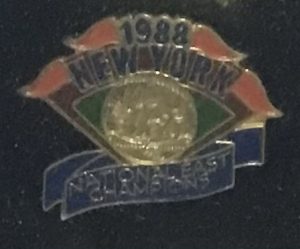 So, did it all go down the toilet? In collective recall, pretty much. Vaccaro wasn’t interviewing and writing about the 1988 Mets in 2023 to celebrate the thirty-fifth anniversary of 100 victories or the fourth division title or those three swell NLCS victories. The homer Scioscia indeed hit off Gooden was framed as the dividing line between how great things had been for the Mets up to that pitch and how it was never quite the same again. This familiar angle tilted toward tabloid black & white (the Mets legitimately challenged for division titles in 1989 and 1990), but the evidence is compelling. The Mets’ next playoff engagement wouldn’t take place for more than a decade, and except for 2006, they haven’t since entered a postseason as the consensus favorite in their league. No New Yorker true to the orange and blue need be reminded the Mets fumbled away Biggest Thing In Town status by the mid-1990s and have never grasped it for more than a few fleeting minutes in the current century. When Hernandez and Ron Darling are nudged by Gary Cohen to remember 1988 in the SNY booth, they invariably respond with regret and recriminations. When the year’s accomplishments are remembered anywhere, it is only as prelude to spotlighting the failure to accomplish more. So, did it all go down the toilet? In collective recall, pretty much. Vaccaro wasn’t interviewing and writing about the 1988 Mets in 2023 to celebrate the thirty-fifth anniversary of 100 victories or the fourth division title or those three swell NLCS victories. The homer Scioscia indeed hit off Gooden was framed as the dividing line between how great things had been for the Mets up to that pitch and how it was never quite the same again. This familiar angle tilted toward tabloid black & white (the Mets legitimately challenged for division titles in 1989 and 1990), but the evidence is compelling. The Mets’ next playoff engagement wouldn’t take place for more than a decade, and except for 2006, they haven’t since entered a postseason as the consensus favorite in their league. No New Yorker true to the orange and blue need be reminded the Mets fumbled away Biggest Thing In Town status by the mid-1990s and have never grasped it for more than a few fleeting minutes in the current century. When Hernandez and Ron Darling are nudged by Gary Cohen to remember 1988 in the SNY booth, they invariably respond with regret and recriminations. When the year’s accomplishments are remembered anywhere, it is only as prelude to spotlighting the failure to accomplish more.
Gregg Jefferies’s surefire superstardom never quite ignited. Kevin McReynolds — dubbed “the Stealth Bomber” by Roger Angell — didn’t endure as the role model Sport magazine said he was. Within twelve months of the final out of the Dodger series, none among feisty 1986 ring-bearers Wilson, Dykstra, Backman, Carter and Hernandez (not to mention Lee Mazzilli, Roger McDowell and Rick Aguilera) would remain Mets. We were already missing the fiery leadership of Ray Knight. We’d soon realize we also missed the sparks set off by Kevin Mitchell, despite strong, silent McReynolds’s steadiness and productivity in the two seasons that followed the exchange of those Kevins. We probably missed everything about Bobby Ojeda, lost for the playoffs to a hedge-trimming fiasco, more than we realized. Knight, Mitch and Bobby O were intrinsic elements of winning it all two years earlier. As was just about everybody that singular year, with nobody, despite all the talent the organization could boast of having collected, proving easily replaced in the scheme of Met things. In August, Hojo had stressed to Klapsich, “1986 will never happen again.” It surely didn’t happen in 1988. Coming sort of close, then reasoning sometimes you’re left with nothing to do but shrug and say Shea la vie wasn’t going to wholly satisfy the Queens constituency, not even this member of its Long Island branch. A hundred wins, a division title and an aura that doesn’t come around very often isn’t nothing. It also wasn’t everything.
 The era in which the 1988 Mets thrived and fell short was indeed the future we wanted. Just not every day of it. Paradise isn’t always what you imagine it might be. The era in which the 1988 Mets thrived and fell short was indeed the future we wanted. Just not every day of it. Paradise isn’t always what you imagine it might be.
PREVIOUS ‘MY FAVORITE SEASONS’ INSTALLMENTS
Nos. 55-44: Lousy Seasons, Redeeming Features
Nos. 43-34: Lookin’ for the Lights (That Silver Lining)
Nos. 33-23: In the Middling Years
Nos. 22-21: Affection in Anonymity
No. 20: No Shirt, Sherlock
No. 19: Not So Heavy Next Time
No. 18: Honorably Discharged
by Greg Prince on 22 February 2024 1:38 pm Spring Training was humming along. Players showed up and pledged to maintain or adjust their career arcs, whichever would help the team most. Prospects were going to make an impression. Youth was going to gain experience. Veterans were already setting examples. The previously ailing were feeling never better. Thievable relievers were working on their pickoff move. Former batting champions were aiming to recapture their crown. Everybody was focused on winning, whatever their positional or contractual status. Smiles abounded. The sun of optimism snuck its head through the clouds that lingered all winter.
In other words, there was nothing any sensible person would consider news. Great! I can’t reiterate enough that you pretty much never want actual news to come out of Spring Training. Until Wednesday, Mets camp offered no bulletins, only reassuring updates, presentation of new faces, and a steady stream of happy horsespit to keep the folks back home satisfied that a new year indeed brings new hope. We might have even started buying into the Us Against The World storyline the Mets have been test-marketing, daring all outside the walls of Port St. Lucie that you underestimate us at your own risk.
Then, Kodai Senga, he of the 202 strikeouts and the 2.98 ERA in his MLB rookie year, felt something in his right shoulder. “Arm fatigue” was the word, which sounded not as benign as a dead arm, if not as foreboding as a sore arm in the medical Spring lingo we brush up on annually. It did, however, sound like something.
Hey, where did that sun go?
Oh, it’s still there, save for every fifth-ish day that Senga, the only Met starting pitcher currently answering to “ace,” would have pitched. It’s still Spring, it’s still a new season, it’s still possible Adam Ottavino will come out of the bullpen and hold a runner close. Think good thoughts. Think Kodai’s moderate right posterior capsule strain will heal with rest and treatment and — though he projects to start the season on the IL and stay on it for a spell before loosening up all over again — think at some point he will come off it and be his Ghost Forking self.
Until then, think of Tylor Megill, Joey Lucchesi, Jose Butto or whoever already in orange and blue now gets an additional chance to shine. That’s reportedly what David Stearns is thinking, so we might as well be on the same page with our POBO. These potentially decent alternatives with whom we’re quite familiar will join the potentially decent rotation that was set to line up behind Senga. Keeping the Hot Stove on a low simmer, the Mets signed Luis Severino and Sean Manaea and traded for Adrian Houser to join Jose Quintana as what you might call innings eaters. A lot of innings lie ahead of us. Senga will devour none of them for a while.
But somebody will, just as was the case the first year we did this blog and the Mets lost Steve Trachsel in March and Kris Benson days before the Opener. Just like last year, when Justin Verlander’s availability evaporated the day of the Opener, echoing what happened (albeit with a tad more notice) with Jacob deGrom the year before that. Starters have issues. Throwing a baseball is a leading cause of discomfort. It always happens to us? It always happens to everybody. We just don’t notice everybody else having some version of this problem, because we don’t care about them. That’s why we’re so susceptible to Us Against The World storylines.
It’s not good news, because it’s Spring news. Games that don’t count getting underway this weekend is a good sign. Maybe we can get back to nothing happening.
by Greg Prince on 16 February 2024 2:44 pm Today marks the nineteenth anniversary of Faith and Fear in Flushing, founded February 16, 2005. For the now twenty Spring Trainings that this blog has existed, we have set out annually in the sincere hope that the Met season ahead serves as prelude to a Met postseason. That’s really all you can ask of a regular season, that it becomes successful enough for more baseball once most baseball teams have to go home. In the ongoing countdown of MY FAVORITE SEASONS, FROM LEAST FAVORITE TO MOST FAVORITE, 1969-PRESENT, we have, to this point, revisited 37 seasons that have produced their share of warm Met memories…but zero Met playoffs.
This installment is the first to take us beyond the traditional finish line. Not all that far beyond it, but tangibly through the tape. Ladies and gentlemen and Mets fans of all ages, I give you, at last, a season that got us to the tournament.
 18. 2016 18. 2016
If you have seen the movie Stripes repeatedly (and I hope you have), you might remember Sergeant Hulka primarily as the drill sergeant who gives Bill Murray grief despite Murray praising him as the platoon’s “big toe,” or perhaps as the inspiration behind the meme that urges every self-serious Internet arguer to LIGHTEN UP FRANCIS. I have seen the movie Stripes repeatedly, and when I think of Sergeant Hulka, I think of the 2016 Mets.
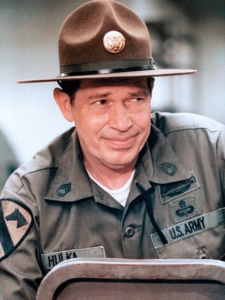 Specifically, I am reminded of the introductory chat Hulka has with his men when he instructs them, “You don’t say ‘sir’ to me. I’m a sergeant. I work for a living.” The 2016 Mets connection here relates to the postseason banner that troop of Mets earned by dint of their Wild Card berth. For six years, until that aspect of Citi Field decor was reimagined in 2023, the marker commemorating what elevated 2016 into rafter prominence was graphically identical to those explaining 1969, 1973, 1986 and so on. Different words, but same pantheon. Except the 2016 Mets never won a world championship, a league championship, a division championship or a postseason series as their eight postseason predecessors had. Now and then a picture of the nine banners all lined up in a row would appear online, and, like clockwork, some party pooper would sniff that it was embarrassing to see 2016 being given the same treatment as the other years listed — because in the Internet age, being a Mets fan too often means finding something to complain out loud about. Specifically, I am reminded of the introductory chat Hulka has with his men when he instructs them, “You don’t say ‘sir’ to me. I’m a sergeant. I work for a living.” The 2016 Mets connection here relates to the postseason banner that troop of Mets earned by dint of their Wild Card berth. For six years, until that aspect of Citi Field decor was reimagined in 2023, the marker commemorating what elevated 2016 into rafter prominence was graphically identical to those explaining 1969, 1973, 1986 and so on. Different words, but same pantheon. Except the 2016 Mets never won a world championship, a league championship, a division championship or a postseason series as their eight postseason predecessors had. Now and then a picture of the nine banners all lined up in a row would appear online, and, like clockwork, some party pooper would sniff that it was embarrassing to see 2016 being given the same treatment as the other years listed — because in the Internet age, being a Mets fan too often means finding something to complain out loud about.
To which I would think, LIGHTEN UP FRANCIS. The 2016 Mets didn’t make the rules that said if you finish with one of the two best non-first place records in your league, you get to call yourself a postseason team. They simply abided by them, falling in line just in time to turn themselves into a lean, mean fighting machine, working to live another day…if just one day. The Mets were scheduled to play 162 games in 2016, as was everybody. Ten of thirty Major League Baseball teams could build an extension to their allotment. The Mets were one of the ten to march beyond Game 162. Where they wound up was no mere Game 163, to invoke another blithe dismissal of their accomplishment. It was the playoffs, befitting a playoff team. The Mets were licensed to print postseason tickets, sell postseason merchandise and, through whatever MLB formula took precedence, open their stadium for postseason play.
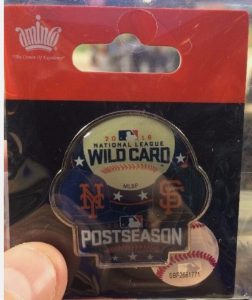 I will grant it was different from winning a division en route to a pennant round or World Series, and, given that it was a one-and-done affair, with the Mets sadly falling into the Done category, it didn’t quite leave behind that lingering “Flushing in the Fall” feel an autumn existing on the edge will. Still, one night in a sanctioned battle to move on within the postseason is definitely the postseason. Twenty teams received no so-called participation commendation that year, and you can’t tear that stripe off the 2016 Mets’ uniforms. So maybe consider them something akin to a Command Sergeant Major among Mets teams, the non-commissioned officer outranking all the enlisted personnel from 1962 forward who never made the playoffs in orange and blue. I will grant it was different from winning a division en route to a pennant round or World Series, and, given that it was a one-and-done affair, with the Mets sadly falling into the Done category, it didn’t quite leave behind that lingering “Flushing in the Fall” feel an autumn existing on the edge will. Still, one night in a sanctioned battle to move on within the postseason is definitely the postseason. Twenty teams received no so-called participation commendation that year, and you can’t tear that stripe off the 2016 Mets’ uniforms. So maybe consider them something akin to a Command Sergeant Major among Mets teams, the non-commissioned officer outranking all the enlisted personnel from 1962 forward who never made the playoffs in orange and blue.
When this unit bucked for a further promotion, they received an honorable discharge from Madison Bumgarner. Yet like Murray’s platoon on graduation day after Sergeant Hulka went down with an injury, boy did they come through when the odds were against them.
Long before they left an oddly polarizing banner behind, the 2016 Mets were a legitimate breeding ground for gripes if you watched them repeatedly in the middle of their muddy five-month run that seemed to leave them stranded in the middle of nowhere by the middle of August. You could have been excused for forgetting they were what are commonly called defending league champions entering the season. It’s a handy phrase that tells you only about the year before, not the year in progress. There’s nothing to defend during the year in progress. Last year’s flag is safe and secure and flying on a pole. It’s not going to be taken away from you no matter how different the year in progress reveals itself relative to the year before. The 2016 Mets were bound to be different from the 2015 pennant-winners. The calendar ensured that conceptually, the reality of churn and attrition made it factual.
As 2016 crept further from 2015, the 2016 Mets bore less and less resemblance to the team that lit up the previous summer, both in terms of performance and composition. If I may invoke another film close to my heart, they were a team full of Wolfmen, as in Scott “Wolfman” Pell, the bassist for hire who was brought in at the last minute to replace the AWOL T.B. Player (a.k.a. the bass player) as those lovable one-hit Wonders prepared to appear on The Hollywood Television Showcase in That Thing You Do!. Wolfman could handle their tune, junior, and that was all you needed to know about him. The group was one-quarter different in the hours leading up to their playing before their largest audience ever, but if you liked the Wonders five minutes ago, their manager Mr. White figured, you’ll like them just fine now.
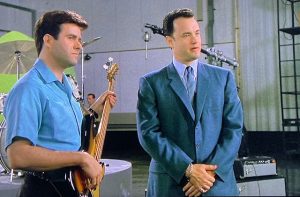 Meet your new catcher, René Rivera. Meet your new catcher, René Rivera.
Meet your new first baseman, James Loney.
Meet your new second baseman, Neil Walker.
Meet your next new second baseman, T.J. Rivera.
Meet your new shortstop, Asdrubal Cabrera.
Meet your old shortstop who’s your new third baseman, Jose Reyes.
Meet your new trade deadline acquisition, Jay Bruce.
Remeet your old trade acquisition, Yoenis Cespedes. His leg is probably bothering him.
Fortunately, Cespedes, who we thought might have been a rental in 2015, reupped for all of 2016 and persevered through what appeared to be six months of aches and pains. And good old Curtis Granderson was a mainstay, even if you suddenly found him in center to make room for Bruce in right, where Bruce wasn’t remotely the revelation Cespedes in left had been a year earlier, but every little bit helped. The rotation that pitched us to the World Series the prior October required lots of help. Matt Harvey was out. Jacob deGrom was out. Steven Matz was out. Noah Syndergaard and Bartolo Colon were it, until two rookies, Seth Lugo and Robert Gsellman, came along. There were others who made starts, but there was literally no Fifth Starter.
From this stew that included dashes of effervescent callup Brandon Nimmo, neglected second-year man Michael Conforto, utility dudes Matt Reynolds, Ty Kelly and Alejandro De Aza and a handful of holdovers either recovering from injuries or finding themselves, Terry Collins ladled out a team that couldn’t quite bring itself to fall out of playoff contention despite doing its best to make other plans once the leaves turned brown. After getting blown out, 8-1, in San Francisco on August 19, the 2016 Mets sat two games under .500 and 5½ games south of the nearest available Wild Card slot, a veritable crowd of contenders elbowing them out of the picture.
Then the 2016 Mets became a reasonable facsimile of the 1973 Mets. They took the next two from the Giants, with Cespedes homering three times, which was both a nice reminder of what Peerless Yo from near Manzanillo (Cuba, that is) could do by way of carrying a contender, and a timely turnaround considering San Fran was one of the umpteen teams ahead of the Mets in the playoff scramble. The road trip moved on to St. Louis, where the Mets took another two out of three from another Wild Card rival. The pitchers who registered New York’s wins were Gsellman, in his first career appearance, and Lugo, in his second career start. We barely knew who these guys were, but they’d just gotten us over .500 to stay.
After winning four of five from the Giants and Cardinals, the schedule turned marshmallow soft, but don’t tell the Mets that. For too much of 2016, the Mets were an opponent others might have looked forward to feasting on. Now it was our turn to get out the forks and knives and start carving up the second division — with humility. That may have been our secret karmic weapon.
You come into a season raising a flag and you may think you’re entitled to look down on other teams, particularly teams that have caused you grief in the past. “You think you’re better than me?” the Phillies and Braves and most everybody else could have asked the defending champs, and I would have answered, on behalf of the Mets, yes, we won the pennant last year. That attitude never takes us far. So, in my mind, we took on the fluffy portion of the schedule with respect for our also-ran opponents, and we did that thing we did. None of that “I am Spartacus!” crap. Booking our gigs, playing our best, removing our shades when we left the stage.
Home for two of three from the rebuilding Phillies.
Three of four from the reviled Marlins, who we’d actually trailed in the standings (but not anymore).
Two of three as we stepped up in class to play the first-place Nationals.
A three-game sweep of the addled Reds in Cincinnati.
Two of three in our final trip to house of horrors emeritus Turner Field, where the Braves had already packed it in en route to their suburban paradise.
Only one of three at Nationals Park, but the one was a thriller, picked off when T.J. Rivera chose the tenth inning to whack his first major league homer (and one of the losses was of the 1-0 variety, which even the ’73 Mets had to withstand down their stretch).
Back to Citi Field for a three-game sweep of the Twins when they were at their lowest; Curtis Granderson waved a magic wand twice in extra innings in the middle game, homering to tie the score in the eleventh, and homering to win the damn thing in the twelfth.
To keep us humble, a three-game sweep at home at the hands of the Braves, which was really at the hands of their center fielder Ender Inciarte absolutely robbing Cespedes of a dramatic walkoff home run over Citi Field’s center field wall in the series finale, a kick in the stomach that landed like a huffy love tap because, by then, we had forged a three-way tie among us, the Cards and the Jints for the two Wild Card spots. You can haunt us, Braves, but you can’t kill us.
Besides, we had the Game of the Year awaiting us the very next night to commence a four-game series versus Philly: 11 innings, 27 Mets and 263 minutes of angsty action, culminating in Asdrubal Cabrera blasting a three-run homer that the do-it-all shortstop — he was so humble, he helpfully removed his teammates’ batting helmets after they rounded the bases — so knew was gone upon contact, that he raised his arms in exuberance before Gary Cohen could utter the first of the two OUTTA HEREs the dinger rated. Asdrubal was preceded in the clutch by old man Reyes, whose two-run homer in the ninth tied matters at six, and sturdy Cespedes, who drove in a tying run in the fifth and a temporary go-ahead run in the seventh. To win, 9-8, the Mets needed all 27 men Collins used, but it was Cabrera, Reyes and Cespedes who were putting their firma especial, or special signature, on this dash toward October.
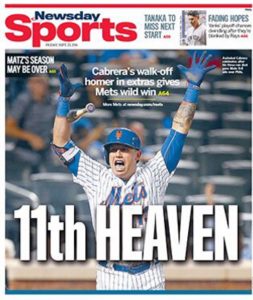 The Mets beat the Phillies the next night; lost to them the night thereafter (10-8 after falling behind, 10-0); and set a franchise record for largest margin of shutout victory, stomping Philly in the home finale, 17-0. Had the Mets thought about cultivating hubris, humility awaited them in Miami, where the Marlins were in mourning for their ace pitcher, Jose Fernandez, who had died over the weekend in a boating accident. The Mets would be the Marlins’ first opponents since the tragedy. Colon gave up a leadoff home run to Dee Gordon, who hadn’t homered all season. The Marlins, all of them wearing FERNANDEZ 16 on their backs, won and then laid their jerseys on the mound in tribute to their fallen comrade. I would have much preferred the Mets winning any game in the midst of a race for a playoff berth, but some nights, other forces prevail and you have to briefly bow your head and roll with it. The Mets beat the Phillies the next night; lost to them the night thereafter (10-8 after falling behind, 10-0); and set a franchise record for largest margin of shutout victory, stomping Philly in the home finale, 17-0. Had the Mets thought about cultivating hubris, humility awaited them in Miami, where the Marlins were in mourning for their ace pitcher, Jose Fernandez, who had died over the weekend in a boating accident. The Mets would be the Marlins’ first opponents since the tragedy. Colon gave up a leadoff home run to Dee Gordon, who hadn’t homered all season. The Marlins, all of them wearing FERNANDEZ 16 on their backs, won and then laid their jerseys on the mound in tribute to their fallen comrade. I would have much preferred the Mets winning any game in the midst of a race for a playoff berth, but some nights, other forces prevail and you have to briefly bow your head and roll with it.
Five games remained. The Mets controlled their own destiny in the prosaic sense. They beat Miami twice, then the Phillies in their series opener at Citizens Bank Park. If they won on Saturday, October 1, they’d clinch not only the Wild Card that appeared almost beyond comprehension six weeks earlier, they’d nail down home field for the game that would determine if they’d be more than one-and-done.
The good news: Colon pitched five solid innings, Loney belted a two-run homer, bullpen stalwarts Addison Reed and Jeurys Familia threw a pair of shutdown frames, Conforto in left came through with a sliding snatch of Aaron Altherr’s sinking liner with two out in the ninth, and for the second consecutive season, the New York Mets had made it to the playoffs, going 27-12 when it couldn’t have counted more.
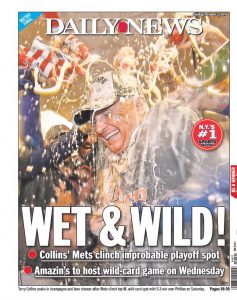 The less good news: The Mets were done after one in the round where everything counts. Syndergaard (7 IP, 2 H, 3 BB, 10 SO, 0 R) was outlasted by Bumgarner (9 IP, 4 H, 2 BB, 6 SO, 0 R). Home field advantage was no advantage versus MadBum, who’d always been maddeningly untouchable at Citi Field. Familia’s 51 saves established a single-season Met record that may remain out of reach for all future closers in the era of load management, but with the score tied at nothing-nothing in the ninth, Conor Gillaspie didn’t care what Jeurys saved previously. The journeyman infielder whose major league career wouldn’t last beyond the following August socked a three-run shot in the ninth that broke the tense scorelessness that until that moment felt like it would never be resolved. Three Mets who made so much noise to get the team this far — Cespedes, Granderson (who crashed into the fence to swipe a double from Brandon Belt and preserve the 0-0 deadlock in the sixth) and T.J. Rivera — each went down quietly. The same Giants who fell twice to the Mets in San Francisco when we began hearing the faintest echoes of You Gotta Believe prevailed, 3-0. Hard not to be humble when Madison Bumgarner is on the mound in October. The less good news: The Mets were done after one in the round where everything counts. Syndergaard (7 IP, 2 H, 3 BB, 10 SO, 0 R) was outlasted by Bumgarner (9 IP, 4 H, 2 BB, 6 SO, 0 R). Home field advantage was no advantage versus MadBum, who’d always been maddeningly untouchable at Citi Field. Familia’s 51 saves established a single-season Met record that may remain out of reach for all future closers in the era of load management, but with the score tied at nothing-nothing in the ninth, Conor Gillaspie didn’t care what Jeurys saved previously. The journeyman infielder whose major league career wouldn’t last beyond the following August socked a three-run shot in the ninth that broke the tense scorelessness that until that moment felt like it would never be resolved. Three Mets who made so much noise to get the team this far — Cespedes, Granderson (who crashed into the fence to swipe a double from Brandon Belt and preserve the 0-0 deadlock in the sixth) and T.J. Rivera — each went down quietly. The same Giants who fell twice to the Mets in San Francisco when we began hearing the faintest echoes of You Gotta Believe prevailed, 3-0. Hard not to be humble when Madison Bumgarner is on the mound in October.
 A less than stellar postscript to a fabulous last chapter. We captured the flag-like object that was within our grasp. Any further advancement would have been gravy. I still seethe at the thought of Gillaspie, but the 2016 Mets earned the marker that proclaimed they gave us a banner year. No need to show further ID, Sarge. Officers Club privileges are hereby extended into perpetuity. A less than stellar postscript to a fabulous last chapter. We captured the flag-like object that was within our grasp. Any further advancement would have been gravy. I still seethe at the thought of Gillaspie, but the 2016 Mets earned the marker that proclaimed they gave us a banner year. No need to show further ID, Sarge. Officers Club privileges are hereby extended into perpetuity.
PREVIOUS ‘MY FAVORITE SEASONS’ INSTALLMENTS
Nos. 55-44: Lousy Seasons, Redeeming Features
Nos. 43-34: Lookin’ for the Lights (That Silver Lining)
Nos. 33-23: In the Middling Years
Nos. 22-21: Affection in Anonymity
No. 20: No Shirt, Sherlock
No. 19: Not So Heavy Next Time
A new episode of National League Town is up for your Spring Training listening.
|
|
 MAY 6: Jacob deGrom, last year’s Rookie of the Year, beats the Orioles one night after Bartolo Colon does the same. I really like deGrom, though I find Colon a little too much of an Internet meme. “Jake and the Fatman,” I muse, and then tweet a picture of William Conrad. Good line, if a little pot calling the kettle black insensitive on my part. Can I help what material I come up with in my dreams?
MAY 6: Jacob deGrom, last year’s Rookie of the Year, beats the Orioles one night after Bartolo Colon does the same. I really like deGrom, though I find Colon a little too much of an Internet meme. “Jake and the Fatman,” I muse, and then tweet a picture of William Conrad. Good line, if a little pot calling the kettle black insensitive on my part. Can I help what material I come up with in my dreams? JUNE 10: I’m still having no-hitter dreams. I find Howie Rose’s ninth-inning play-by-play online somewhere and I decide to transcribe it, first on Twitter, then on the blog. I lose Twitter followers who don’t want to be reminded, and some blog readers tell me they don’t love being reminded. Yet in the dream I did it to be complimentary toward Howie’s play-by-play, particularly that he called it with the right amount of drama, never mind it was happening to rather than for the Mets, like Bob Murphy might have. The kicker to this dream? Howie Rose e-mailed me to thank me for making the comparison. No, this couldn’t have happened. MEANWHILE (yes, it’s one of those long and winding dreams), I go to a game that night, at Citi Field, against the Giants. It’s with a guy from California who tells me he’s moved to Queens for the season JUST so he can go to every Mets home game. I know, right? The guy, who tells me a book I wrote helped inspire him to do this, has very good seats not far from the field, the cushy green ones. At one point, I stand up, then sit down, and the seat collapses with me in it. In my dreams, this six-year-old ballpark is falling apart.
JUNE 10: I’m still having no-hitter dreams. I find Howie Rose’s ninth-inning play-by-play online somewhere and I decide to transcribe it, first on Twitter, then on the blog. I lose Twitter followers who don’t want to be reminded, and some blog readers tell me they don’t love being reminded. Yet in the dream I did it to be complimentary toward Howie’s play-by-play, particularly that he called it with the right amount of drama, never mind it was happening to rather than for the Mets, like Bob Murphy might have. The kicker to this dream? Howie Rose e-mailed me to thank me for making the comparison. No, this couldn’t have happened. MEANWHILE (yes, it’s one of those long and winding dreams), I go to a game that night, at Citi Field, against the Giants. It’s with a guy from California who tells me he’s moved to Queens for the season JUST so he can go to every Mets home game. I know, right? The guy, who tells me a book I wrote helped inspire him to do this, has very good seats not far from the field, the cushy green ones. At one point, I stand up, then sit down, and the seat collapses with me in it. In my dreams, this six-year-old ballpark is falling apart. JULY 2: My dad is out of the hospital and the Mets are being swept three by the Cubs while scoring exactly one run. Disappointing Met overtones asides, this qualifies as a good dream.
JULY 2: My dad is out of the hospital and the Mets are being swept three by the Cubs while scoring exactly one run. Disappointing Met overtones asides, this qualifies as a good dream. JULY 19: It’s the Sunday after the All-Star break in this one. The Mets are in St. Louis and they play EIGHTEEN innings. I think the Mets won. I know Keith Hernandez got impatient (a very lifelike detail to have retained).
JULY 19: It’s the Sunday after the All-Star break in this one. The Mets are in St. Louis and they play EIGHTEEN innings. I think the Mets won. I know Keith Hernandez got impatient (a very lifelike detail to have retained). AUGUST 2: One more Mets-Nationals dream. This time it’s Sunday Night Baseball, which is usually akin to a nightmare, but crazily enough, the Mets can’t stop hitting home runs, at least in the third inning. Granderson — home run! Murphy — home run! Duda — home run! The Thor guy goes eight. Tyler Clippard, who my subconscious vaguely recalls as a Yankee who came out of nowhere to beat us on Sunday Night Baseball a long time ago, gets the save for us. We’re in a “virtual tie” for first. I’m beginning to wish I was awake for more of this.
AUGUST 2: One more Mets-Nationals dream. This time it’s Sunday Night Baseball, which is usually akin to a nightmare, but crazily enough, the Mets can’t stop hitting home runs, at least in the third inning. Granderson — home run! Murphy — home run! Duda — home run! The Thor guy goes eight. Tyler Clippard, who my subconscious vaguely recalls as a Yankee who came out of nowhere to beat us on Sunday Night Baseball a long time ago, gets the save for us. We’re in a “virtual tie” for first. I’m beginning to wish I was awake for more of this. AUGUST 22: It’s the next night, and the Mets have beaten the Rockies again by THE EXACT SAME SCORE of 14-9, which must mean I’m dreaming in a loop.
AUGUST 22: It’s the next night, and the Mets have beaten the Rockies again by THE EXACT SAME SCORE of 14-9, which must mean I’m dreaming in a loop. SEPTEMBER 27: My wife and I visit my dad. He’s in the ICU all of a sudden. He’s only vaguely aware of the Mets being division champions and drifts off a lot. The dream ends with us sitting around his bed watching 60 Minutes.
SEPTEMBER 27: My wife and I visit my dad. He’s in the ICU all of a sudden. He’s only vaguely aware of the Mets being division champions and drifts off a lot. The dream ends with us sitting around his bed watching 60 Minutes. OCTOBER 17: Instead of being haunted by Shea, I am haunting Citi, site of Game One of the NLCS, Mets versus Cubs. How odd that it’s the Cubs in my dream. The Mets trying to catch the Cubs is where it all started for me as a fan, spurred on by my reading the Post my father would bring home every night. I’d see the standings and I’d see a cartoon on the back page, where the Cubs were the bear and the Mets were a bird of some sort, and now this? Does it mean some kind of full-circle in my relationship with my dad? While I ponder that, I note that my first NLCS game since 2006 (the Mets’ too, I guess) goes swimmingly. Murphy keeps hitting homers and we win.
OCTOBER 17: Instead of being haunted by Shea, I am haunting Citi, site of Game One of the NLCS, Mets versus Cubs. How odd that it’s the Cubs in my dream. The Mets trying to catch the Cubs is where it all started for me as a fan, spurred on by my reading the Post my father would bring home every night. I’d see the standings and I’d see a cartoon on the back page, where the Cubs were the bear and the Mets were a bird of some sort, and now this? Does it mean some kind of full-circle in my relationship with my dad? While I ponder that, I note that my first NLCS game since 2006 (the Mets’ too, I guess) goes swimmingly. Murphy keeps hitting homers and we win. OCTOBER 21: I’ve never seen all of Back to the Future II, but in my dream, it’s significant that this is October 21, 2015, because apparently the Cubs win the World Series on this date in, you know, the future. (In, you know, the movie.) But never mind the movies. Let’s screen what I’ve been dreaming: the Mets win the pennant! Yes, Murphy has hit a home run in his sixth consecutive dream…I mean game. And though I’m watching from home, I get to share it with my father, as he calls me a few minutes after it happens. The strange part is he’s been calling me at all hours confused about whether it’s day or night, but in this part of the dream, he’s not only totally lucid, but simply calls to congratulate me, like he knows this is important to me, and that it was important to him to let me know that.
OCTOBER 21: I’ve never seen all of Back to the Future II, but in my dream, it’s significant that this is October 21, 2015, because apparently the Cubs win the World Series on this date in, you know, the future. (In, you know, the movie.) But never mind the movies. Let’s screen what I’ve been dreaming: the Mets win the pennant! Yes, Murphy has hit a home run in his sixth consecutive dream…I mean game. And though I’m watching from home, I get to share it with my father, as he calls me a few minutes after it happens. The strange part is he’s been calling me at all hours confused about whether it’s day or night, but in this part of the dream, he’s not only totally lucid, but simply calls to congratulate me, like he knows this is important to me, and that it was important to him to let me know that. OCTOBER 25: I’m going up to my father’s place with a bag from Burger King. In my dream, my sister told me I should bring him a couple of cheeseburgers, that he likes Burger King cheeseburgers. I’ve avoided Burger King and its Golden Arched-brethren for years, but in my dream I go to the drive through and order some cheeseburgers. On my way up there, I notice Mets flags flying in people’s front yards. There’s something different in the air, and it’s not just the Burger King aroma. There’s no ballgame on, so it’s not much of a visit, and he’s not that into the cheeseburger. On my way home, my car is making a noise. I barely steer it into the parking lot. My driving has improved throughout these dreams, probably out of necessity. But it’s still an old car, just like my dad is an old dad. I eat the leftover cheeseburger. It doesn’t sit well.
OCTOBER 25: I’m going up to my father’s place with a bag from Burger King. In my dream, my sister told me I should bring him a couple of cheeseburgers, that he likes Burger King cheeseburgers. I’ve avoided Burger King and its Golden Arched-brethren for years, but in my dream I go to the drive through and order some cheeseburgers. On my way up there, I notice Mets flags flying in people’s front yards. There’s something different in the air, and it’s not just the Burger King aroma. There’s no ballgame on, so it’s not much of a visit, and he’s not that into the cheeseburger. On my way home, my car is making a noise. I barely steer it into the parking lot. My driving has improved throughout these dreams, probably out of necessity. But it’s still an old car, just like my dad is an old dad. I eat the leftover cheeseburger. It doesn’t sit well. OCTOBER 30: The Mets are down oh-two in the Series, but I’m not giving up, because, according to the latest tributary of my dreamscape, I’m writing a book about the 2015 Mets, but it will only be published if they win. I’m working furiously on it before Game Three so I can have some of the chapters done and THEN walk to the train station and head for MY FIRST WORLD SERIES GAME. Not even in my dreams did I see the Mets in person in the Series in 1969, 1973, 1986 or 2000, but here I am, coming down the staircase from the 7 and taking in all the World Seriesness of it. I see a number of friends in the parking lot beforehand, including the California guy. It’s like we’re all getting our reward for our patience, and it makes me feel really good. Between one of the innings, they tell us to hold up our Stand Up 2 Cancer cards, which I do. I’ve written my father’s name on it. Daniel Murphy doesn’t hit a home run, but David Wright does. So does Curtis Granderson, but I don’t see it, because in this dream, the whole thing is almost too much and I have to get up and do a lap around Field Level. What else happened? Oh, Syndergaard! He’s brushed back that pesky leadoff Royals hitter, which was a welcome sight. Thor pitched well and we scored a lot and we won! I’ve seen the Mets win a World Series game in my dreams! Close enough to reality, I figure.
OCTOBER 30: The Mets are down oh-two in the Series, but I’m not giving up, because, according to the latest tributary of my dreamscape, I’m writing a book about the 2015 Mets, but it will only be published if they win. I’m working furiously on it before Game Three so I can have some of the chapters done and THEN walk to the train station and head for MY FIRST WORLD SERIES GAME. Not even in my dreams did I see the Mets in person in the Series in 1969, 1973, 1986 or 2000, but here I am, coming down the staircase from the 7 and taking in all the World Seriesness of it. I see a number of friends in the parking lot beforehand, including the California guy. It’s like we’re all getting our reward for our patience, and it makes me feel really good. Between one of the innings, they tell us to hold up our Stand Up 2 Cancer cards, which I do. I’ve written my father’s name on it. Daniel Murphy doesn’t hit a home run, but David Wright does. So does Curtis Granderson, but I don’t see it, because in this dream, the whole thing is almost too much and I have to get up and do a lap around Field Level. What else happened? Oh, Syndergaard! He’s brushed back that pesky leadoff Royals hitter, which was a welcome sight. Thor pitched well and we scored a lot and we won! I’ve seen the Mets win a World Series game in my dreams! Close enough to reality, I figure. NOVEMBER 1-2: I never dreamed of the Mets playing in November, but here they are, trying to not lose the World Series, no matter what the calendar says. My car’s still in the shop. so I’m commuting by rail to get to my father’s. Matt Harvey is pitching really well. Granderson homers. Dad naps in and out of the action. It’s actually going pretty fast. Maybe I can make a decent-hour LIRR and wind my way home and then we can plan for Game Six. Maybe I shouldn’t have been thinking about such things prematurely because suddenly Harvey is on the mound in the ninth after yelling at Terry Collins in the dugout (I think he was gonna be taken out) and this long, painful drip of a Royals rally ensues. I’m not sure of the details. I may have blocked them out, but I do know it’s tied and we’re in extra innings again, and my father’s asleep and I’m texting with my sister which is REALLY weird, because she’s never cared about baseball, but in my mind in my dream I’m remembering my very first World Series memory: me and her running errands with Dad with Game One against the Orioles on the radio for my benefit. Don Buford homers off Tom Seaver, but Dad tells me it’s all right, there’s still a long way to go. We lose that game, but we win that Series. It, like the business about the Post and the standings and the cartoon, is the touchstone of my fandom. Full-circle? Going in circles? Why would my sister be watching the World Series? Not to see the Mets win, apparently. I dream the Royals score a ton of runs, again via details I block out, and Wilmer Flores, who everybody embraced back in July, takes strike three to end it. My father is awake by now and offers some condolences blended with some encouragement. He’s lying there in bed, unable to get up and walk out as I’m sure he’d prefer, and he’s telling me everything’s gonna be all right, just like in the Chrysler in 1969. I think I tell him I was glad to watch so much baseball with him. Or did I forget to mention that? I should’ve said something profound, but we’ve never talked to each other like that, so why make him uncomfortable with emotions? I don’t know. I have to take another expensive cab ride home, during which me and the driver end up talking about Carmelo Anthony for some reason. Then, in the dream, I get home, I write a whole lot about how much this weird dream of a season meant to me, I fall asleep (sleeping while I’m sleeping; I can’t make sense of anything anymore), and when I wake up, I learn my car is fixed, so I better pick it up, and they’re gonna publish my book despite the Mets losing, so I better finish it.
NOVEMBER 1-2: I never dreamed of the Mets playing in November, but here they are, trying to not lose the World Series, no matter what the calendar says. My car’s still in the shop. so I’m commuting by rail to get to my father’s. Matt Harvey is pitching really well. Granderson homers. Dad naps in and out of the action. It’s actually going pretty fast. Maybe I can make a decent-hour LIRR and wind my way home and then we can plan for Game Six. Maybe I shouldn’t have been thinking about such things prematurely because suddenly Harvey is on the mound in the ninth after yelling at Terry Collins in the dugout (I think he was gonna be taken out) and this long, painful drip of a Royals rally ensues. I’m not sure of the details. I may have blocked them out, but I do know it’s tied and we’re in extra innings again, and my father’s asleep and I’m texting with my sister which is REALLY weird, because she’s never cared about baseball, but in my mind in my dream I’m remembering my very first World Series memory: me and her running errands with Dad with Game One against the Orioles on the radio for my benefit. Don Buford homers off Tom Seaver, but Dad tells me it’s all right, there’s still a long way to go. We lose that game, but we win that Series. It, like the business about the Post and the standings and the cartoon, is the touchstone of my fandom. Full-circle? Going in circles? Why would my sister be watching the World Series? Not to see the Mets win, apparently. I dream the Royals score a ton of runs, again via details I block out, and Wilmer Flores, who everybody embraced back in July, takes strike three to end it. My father is awake by now and offers some condolences blended with some encouragement. He’s lying there in bed, unable to get up and walk out as I’m sure he’d prefer, and he’s telling me everything’s gonna be all right, just like in the Chrysler in 1969. I think I tell him I was glad to watch so much baseball with him. Or did I forget to mention that? I should’ve said something profound, but we’ve never talked to each other like that, so why make him uncomfortable with emotions? I don’t know. I have to take another expensive cab ride home, during which me and the driver end up talking about Carmelo Anthony for some reason. Then, in the dream, I get home, I write a whole lot about how much this weird dream of a season meant to me, I fall asleep (sleeping while I’m sleeping; I can’t make sense of anything anymore), and when I wake up, I learn my car is fixed, so I better pick it up, and they’re gonna publish my book despite the Mets losing, so I better finish it.























































